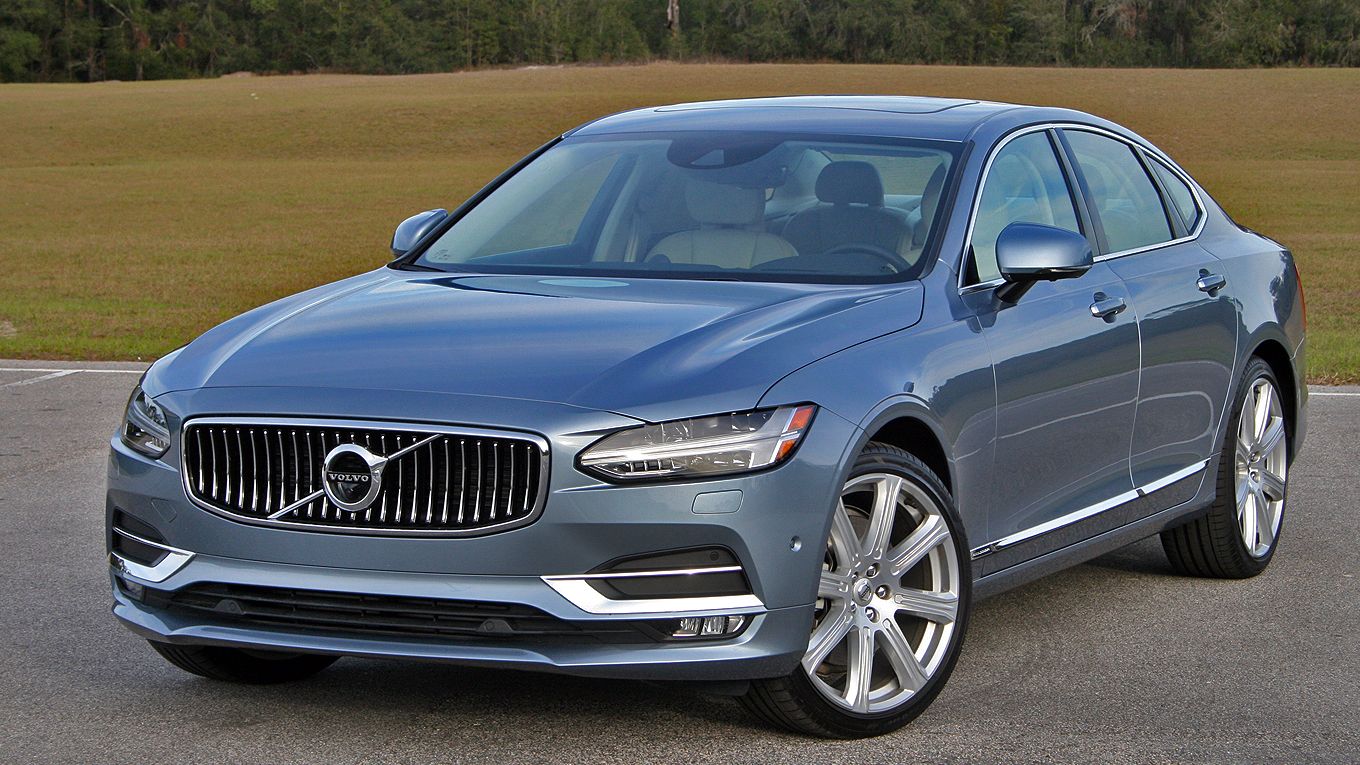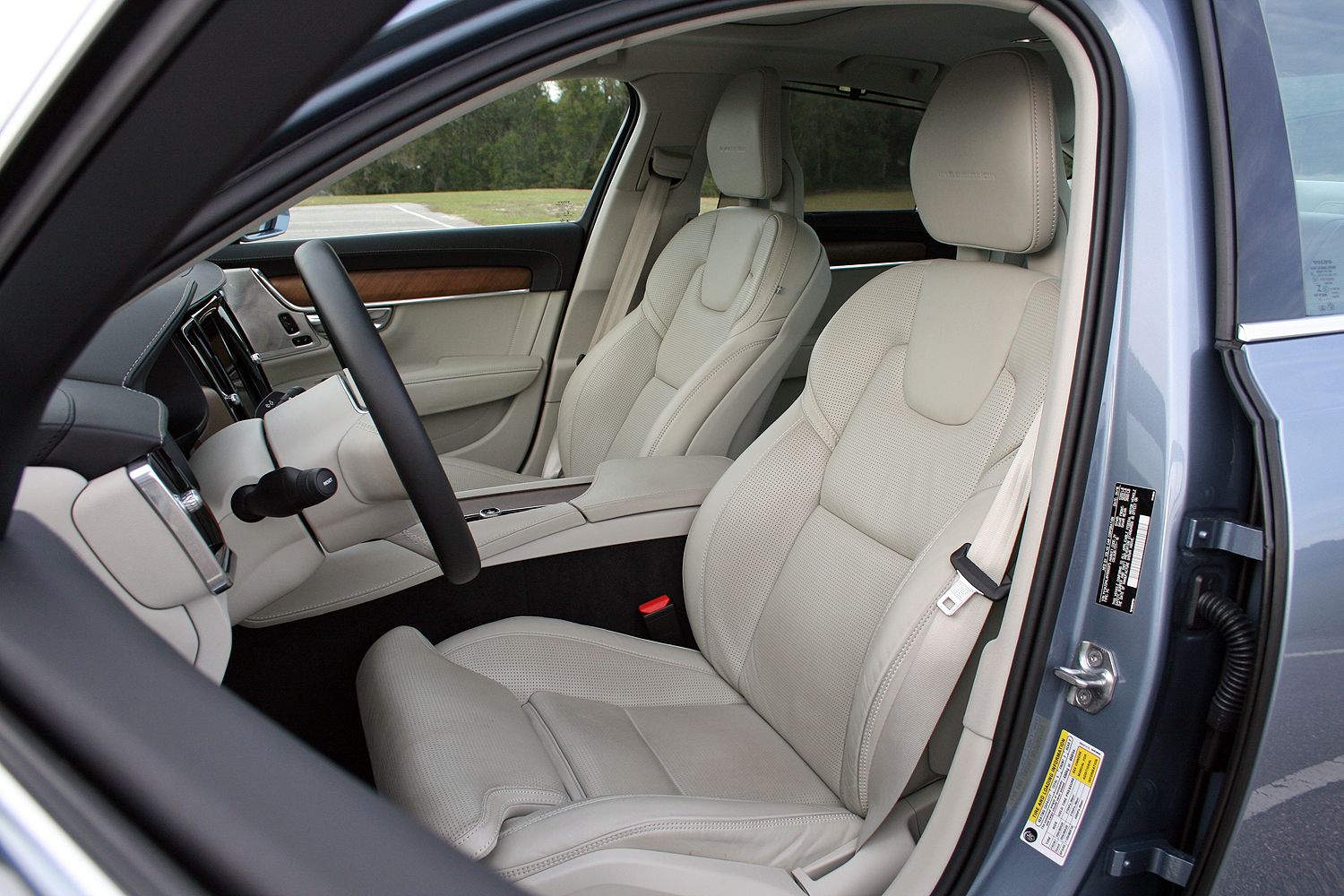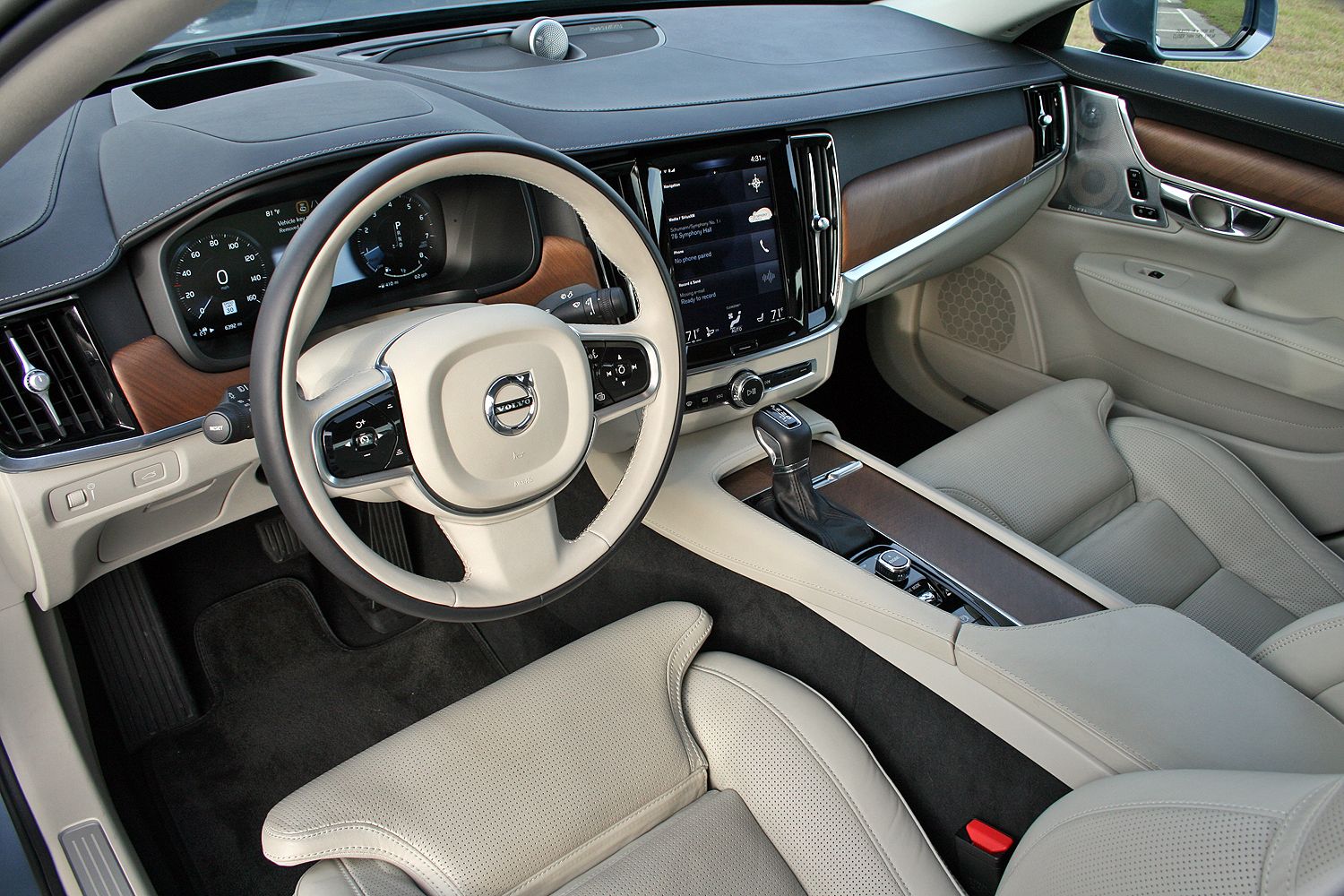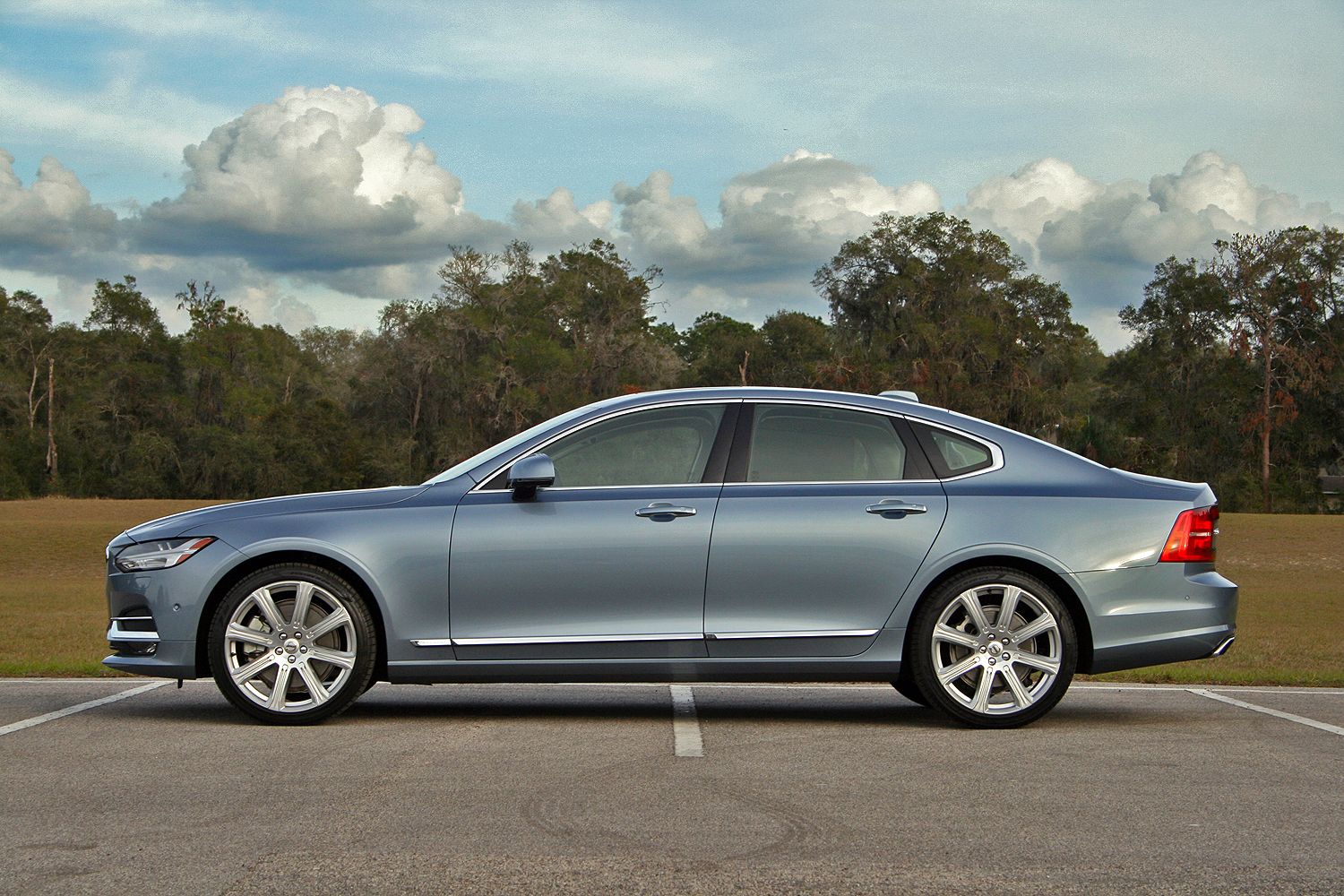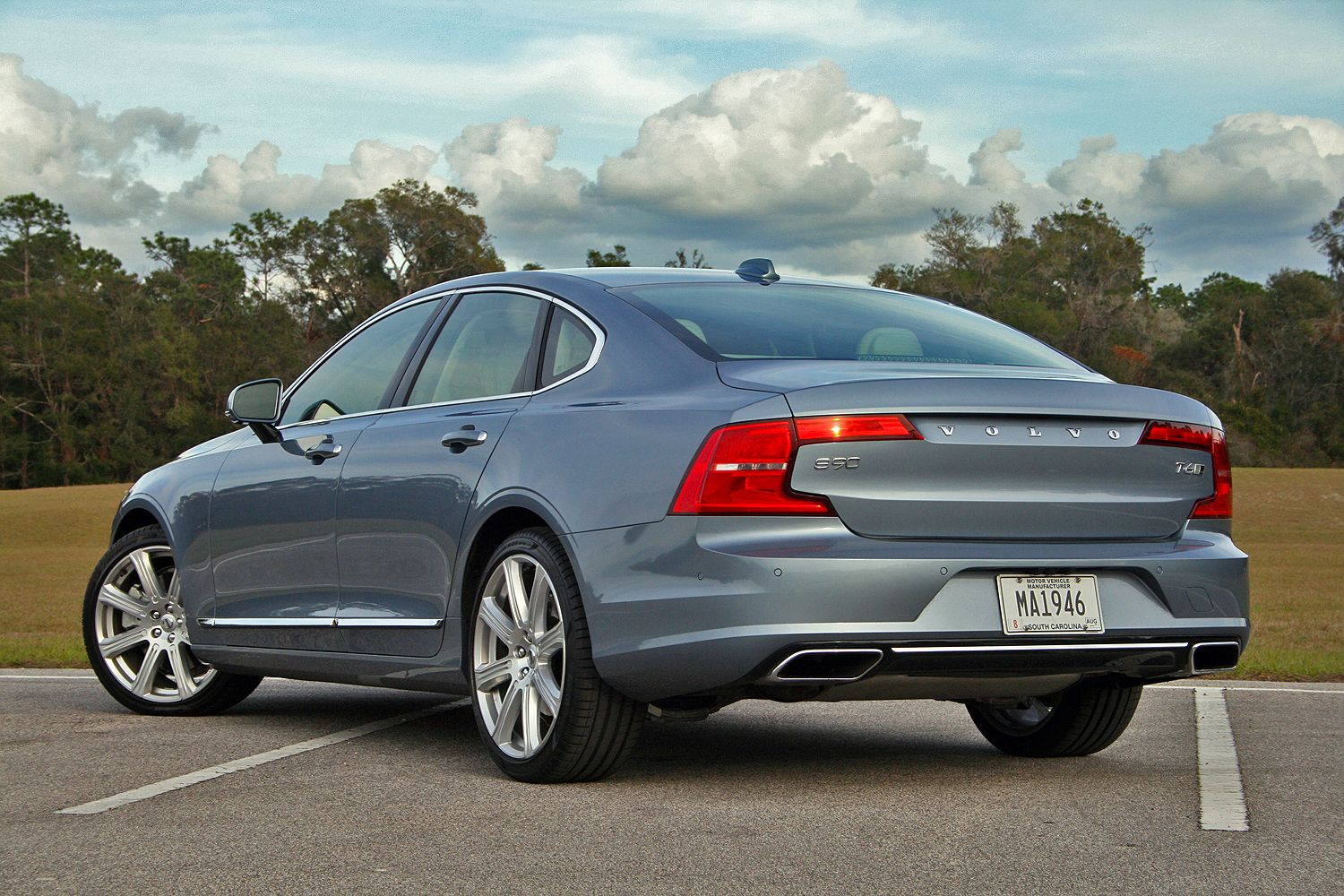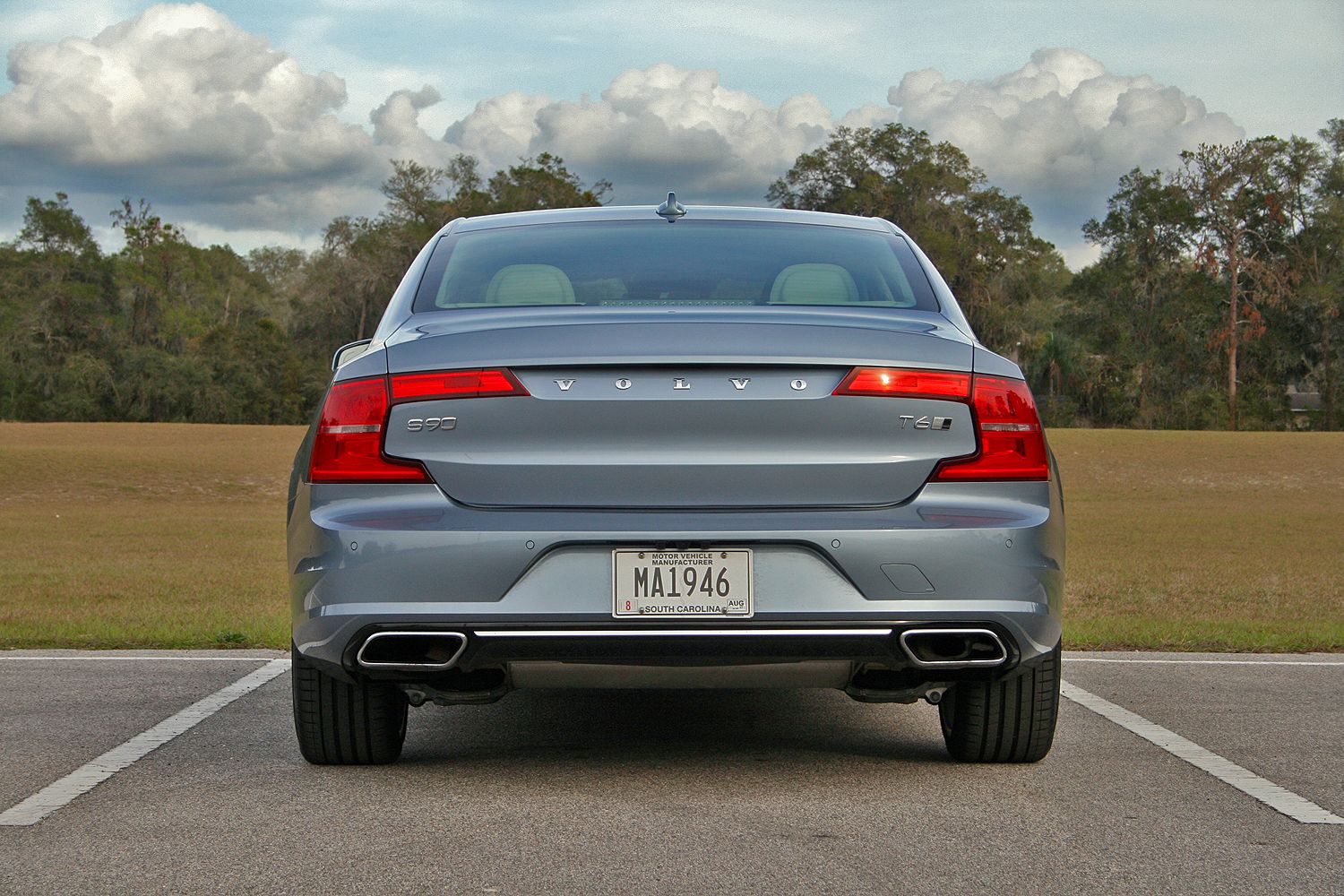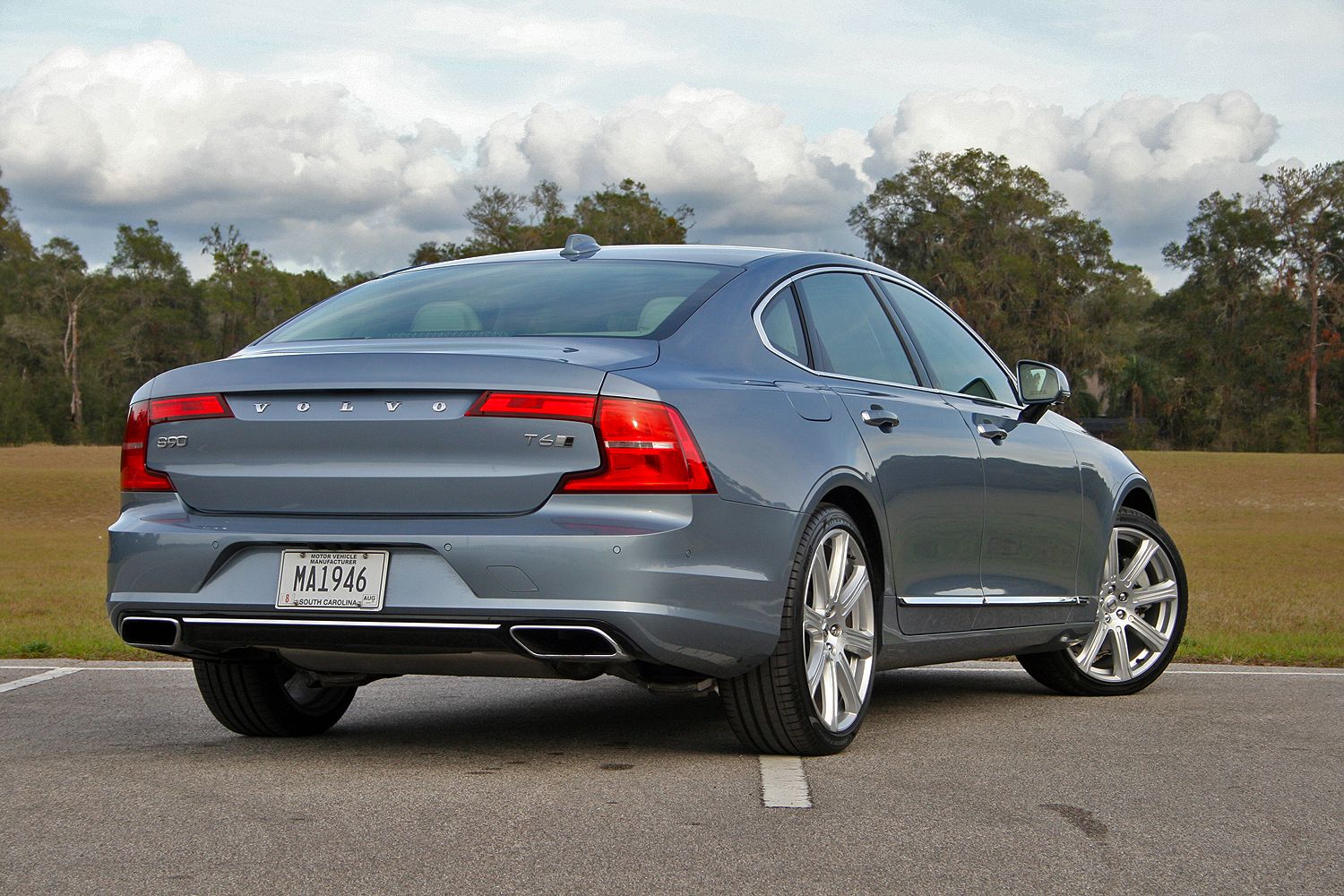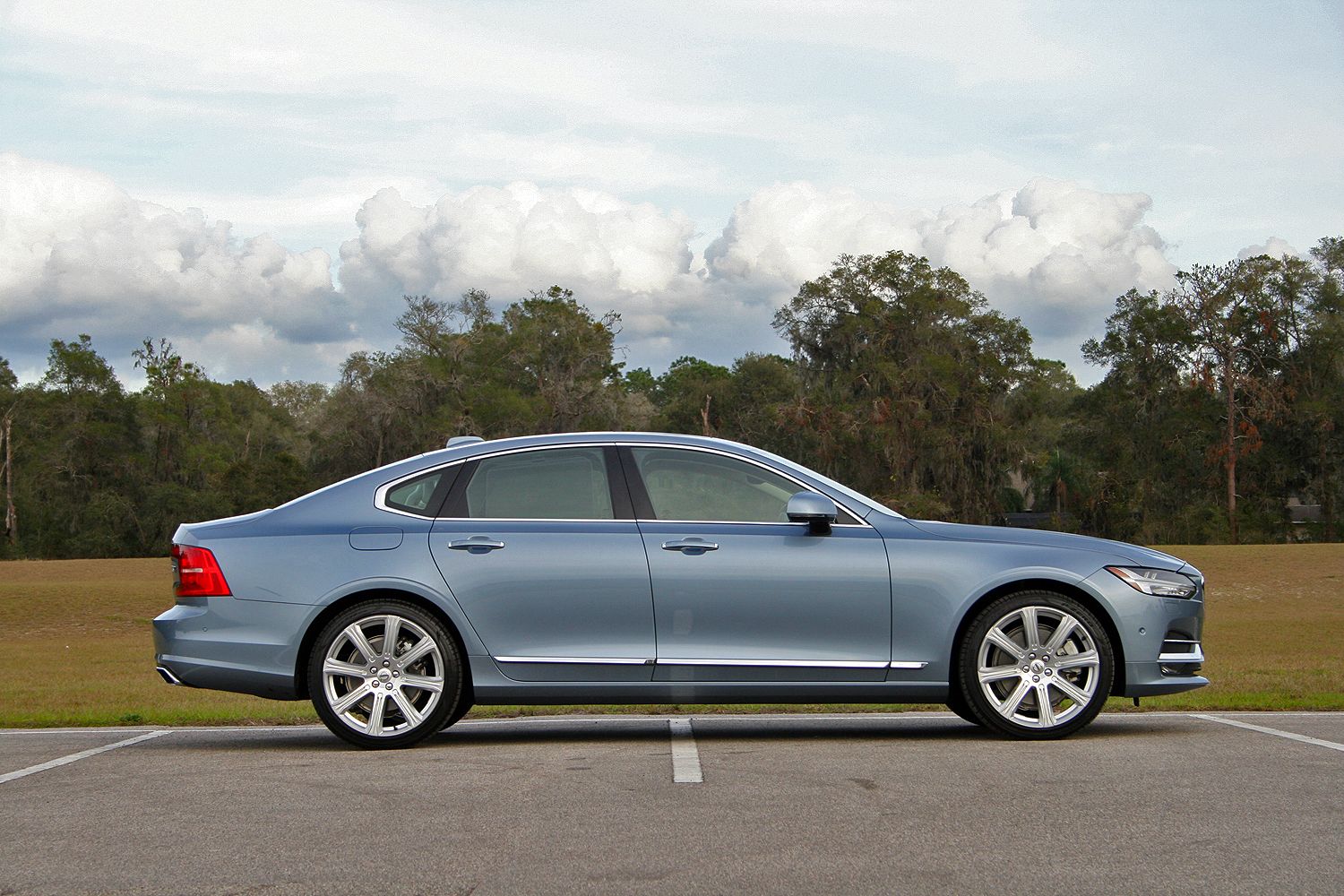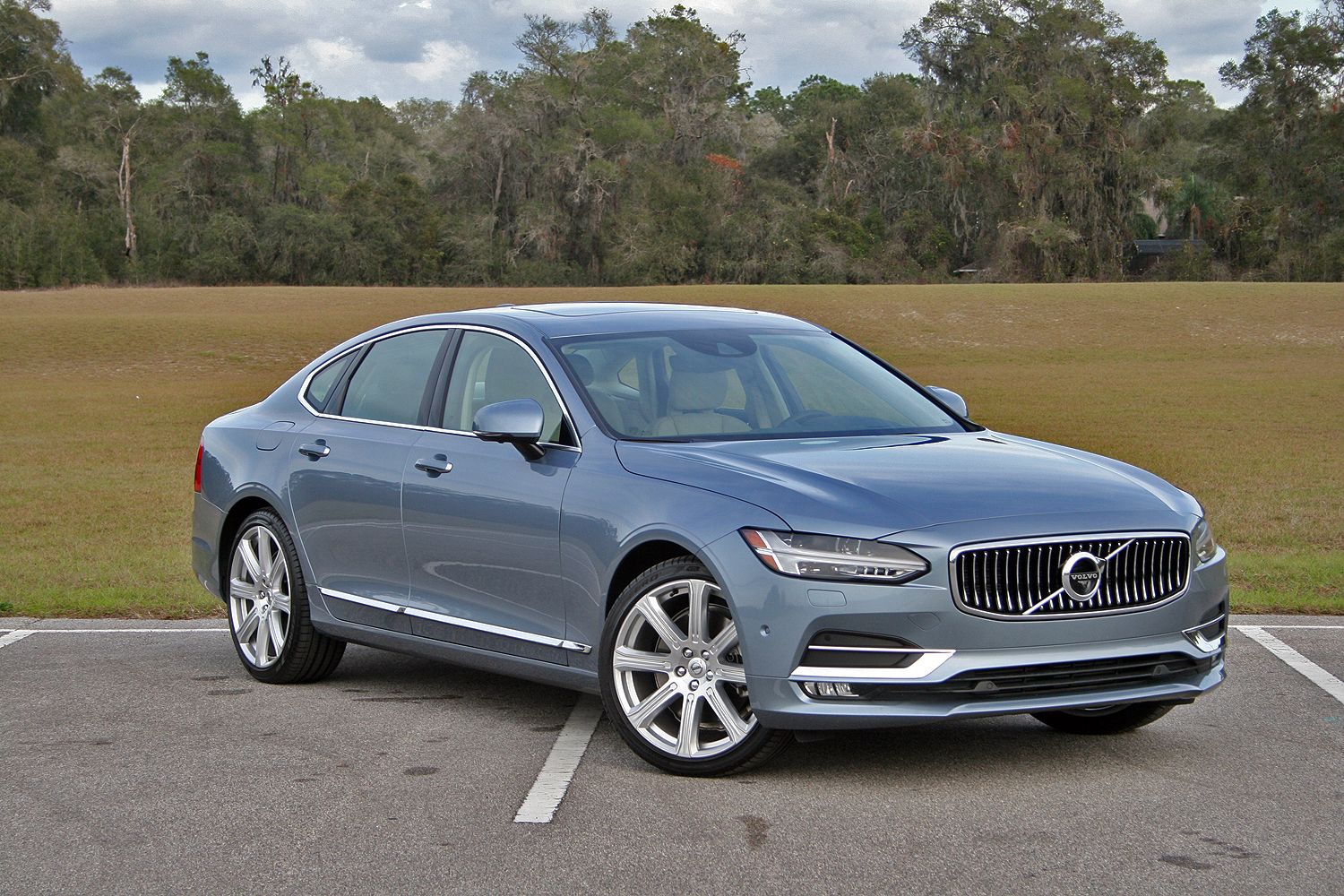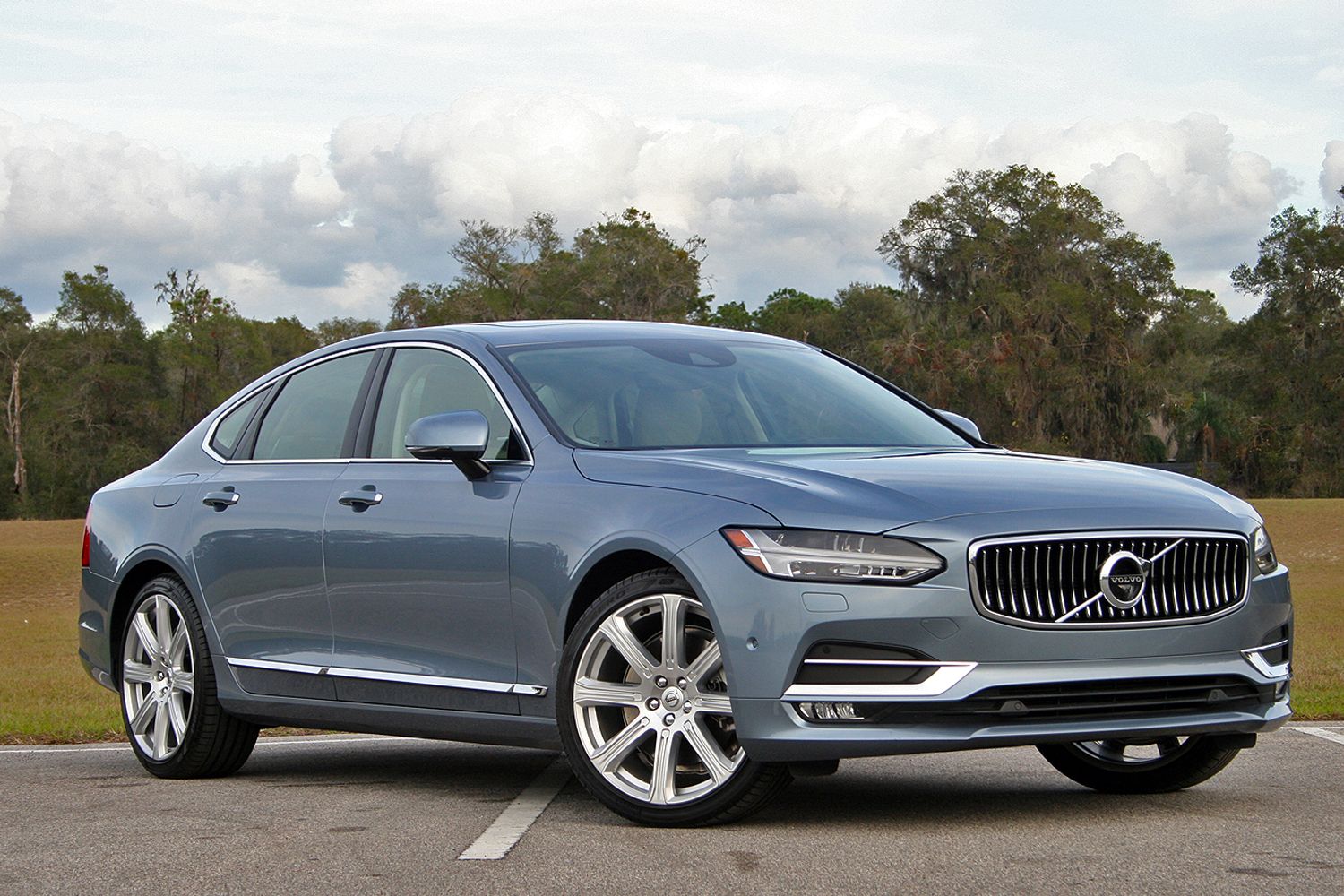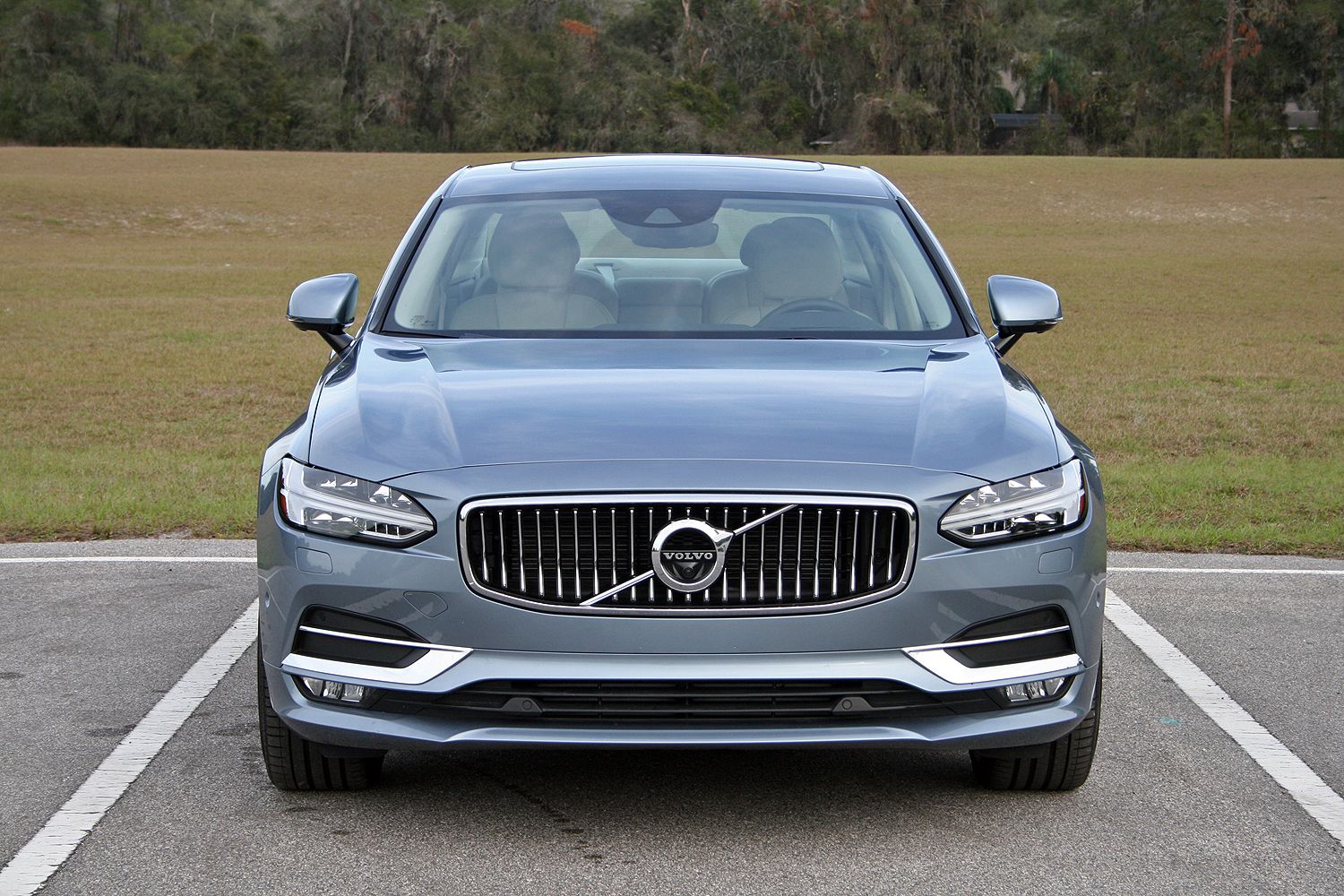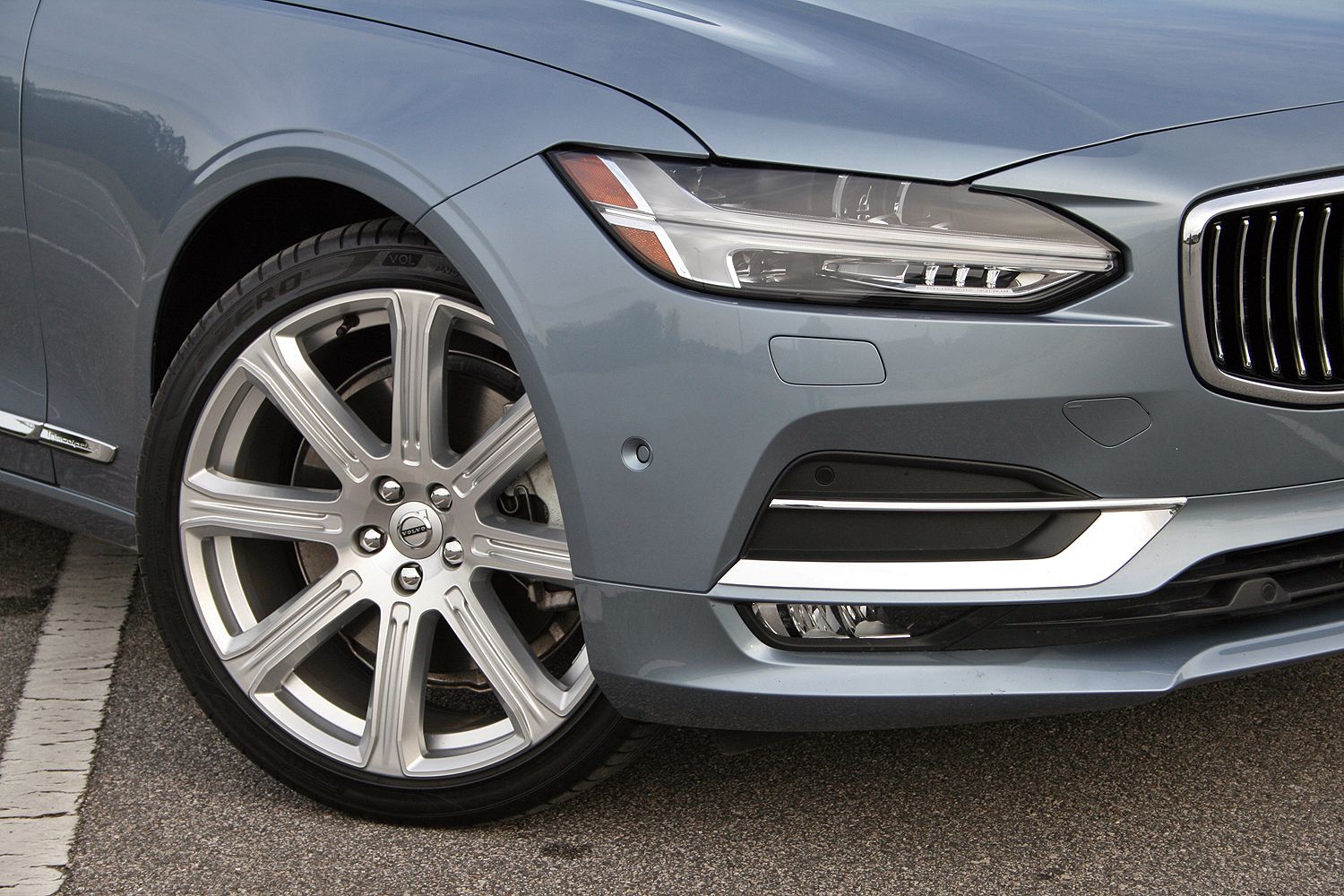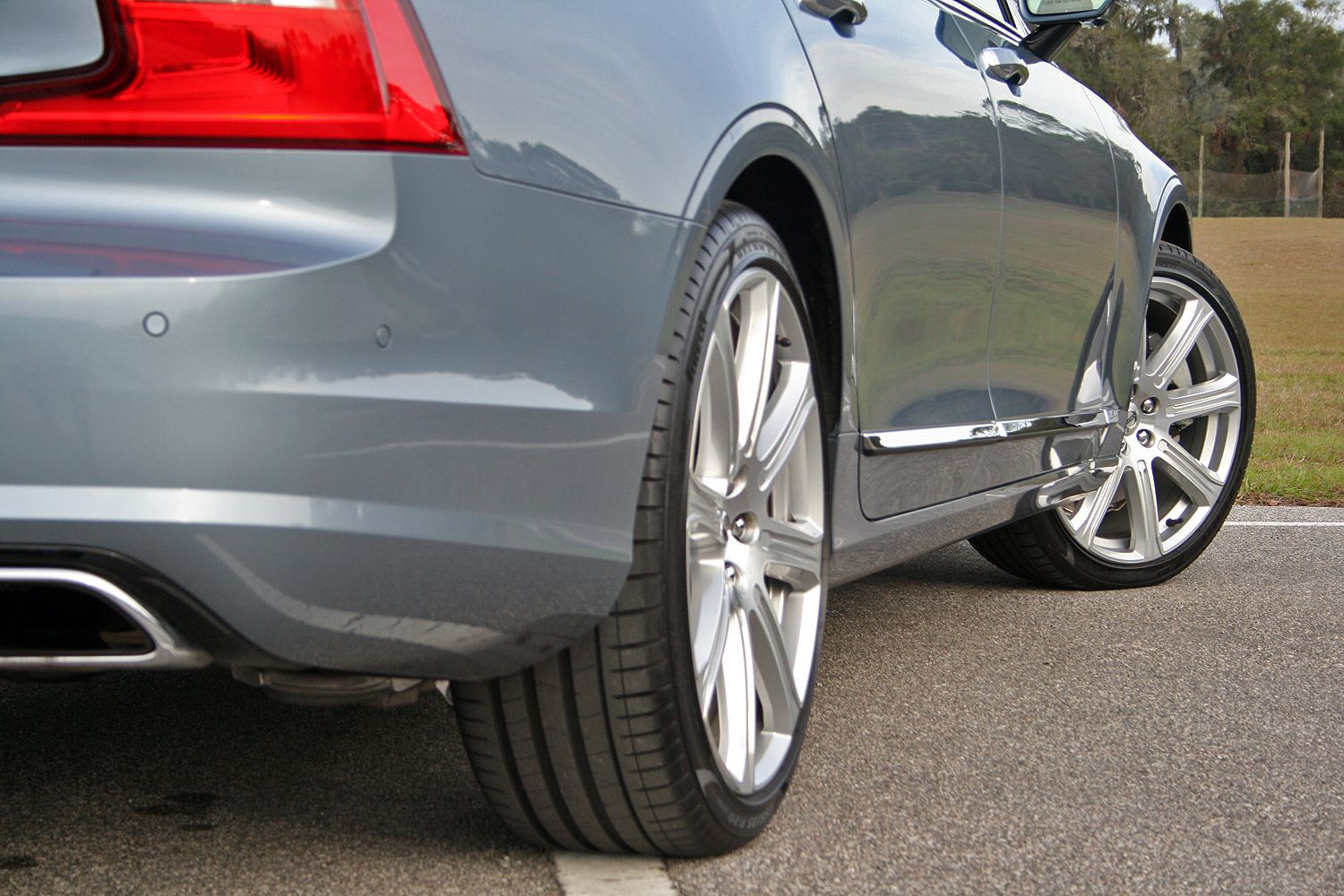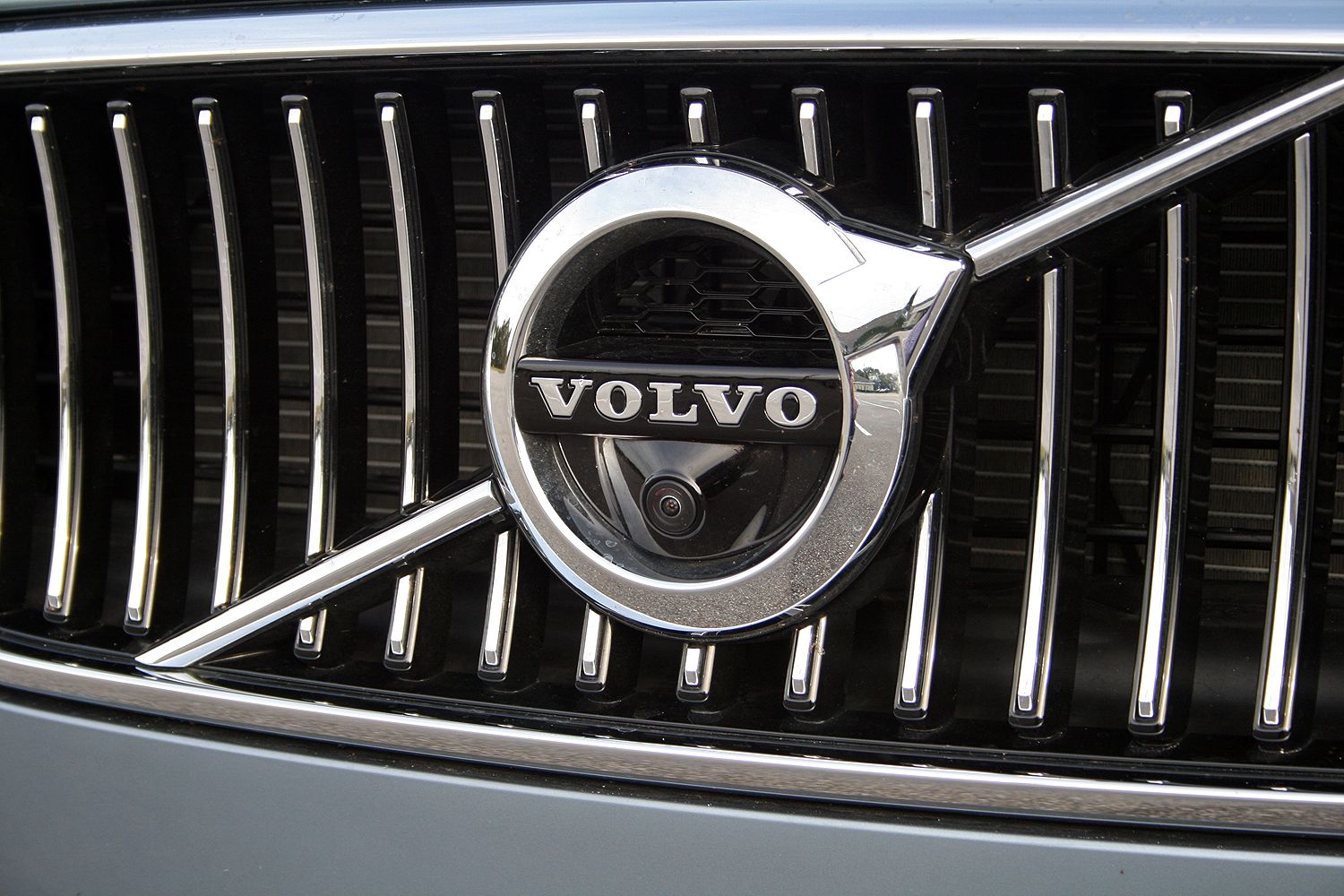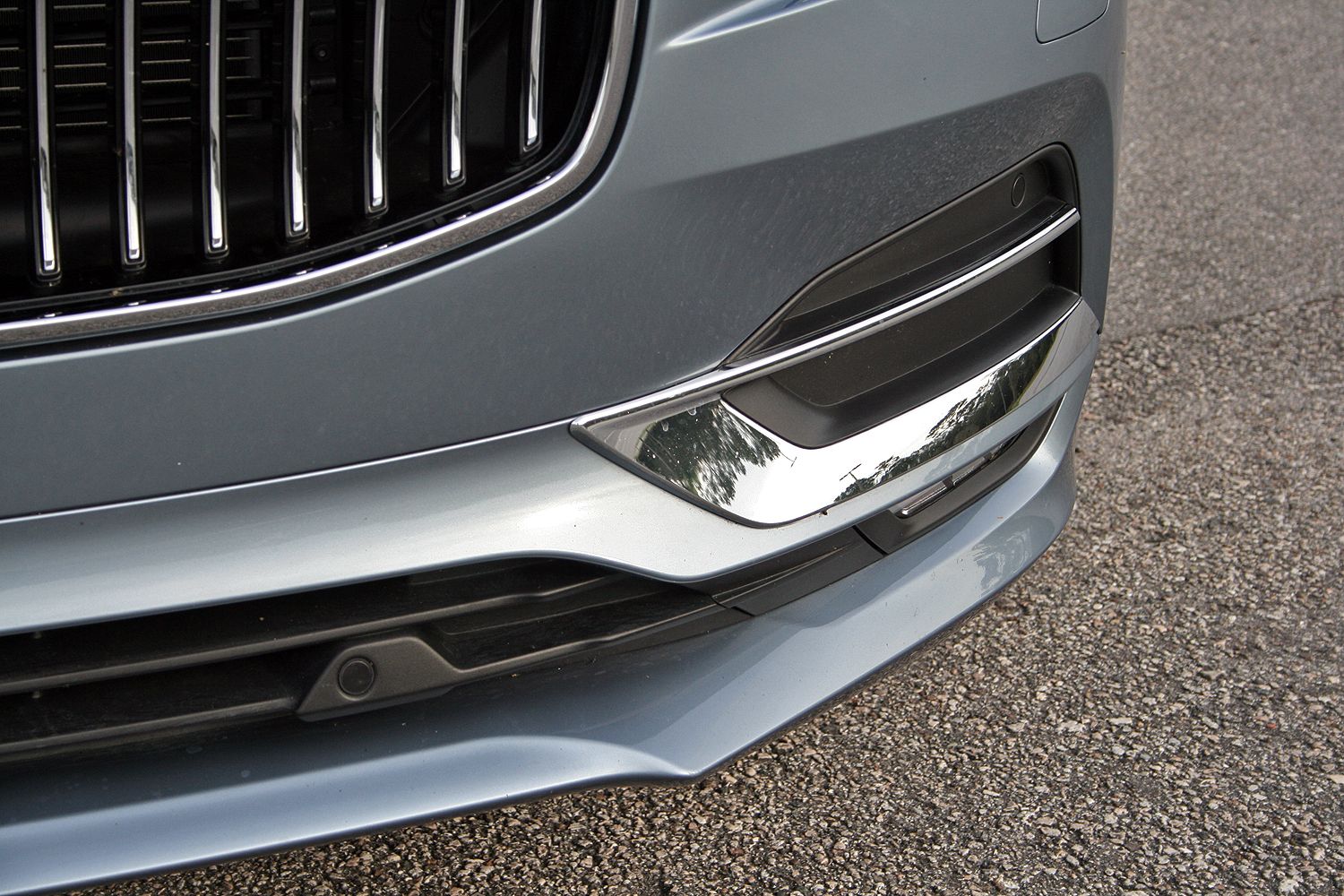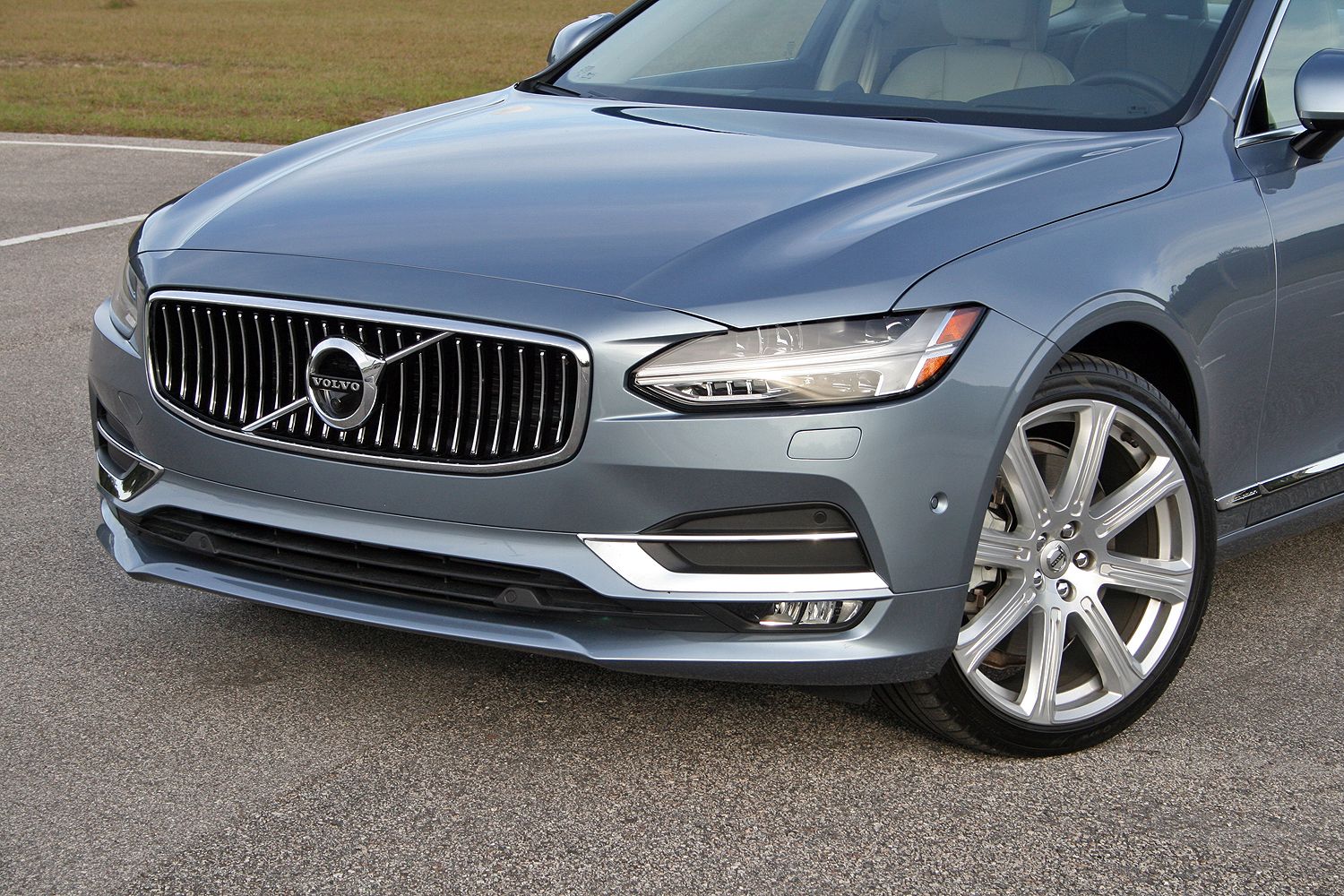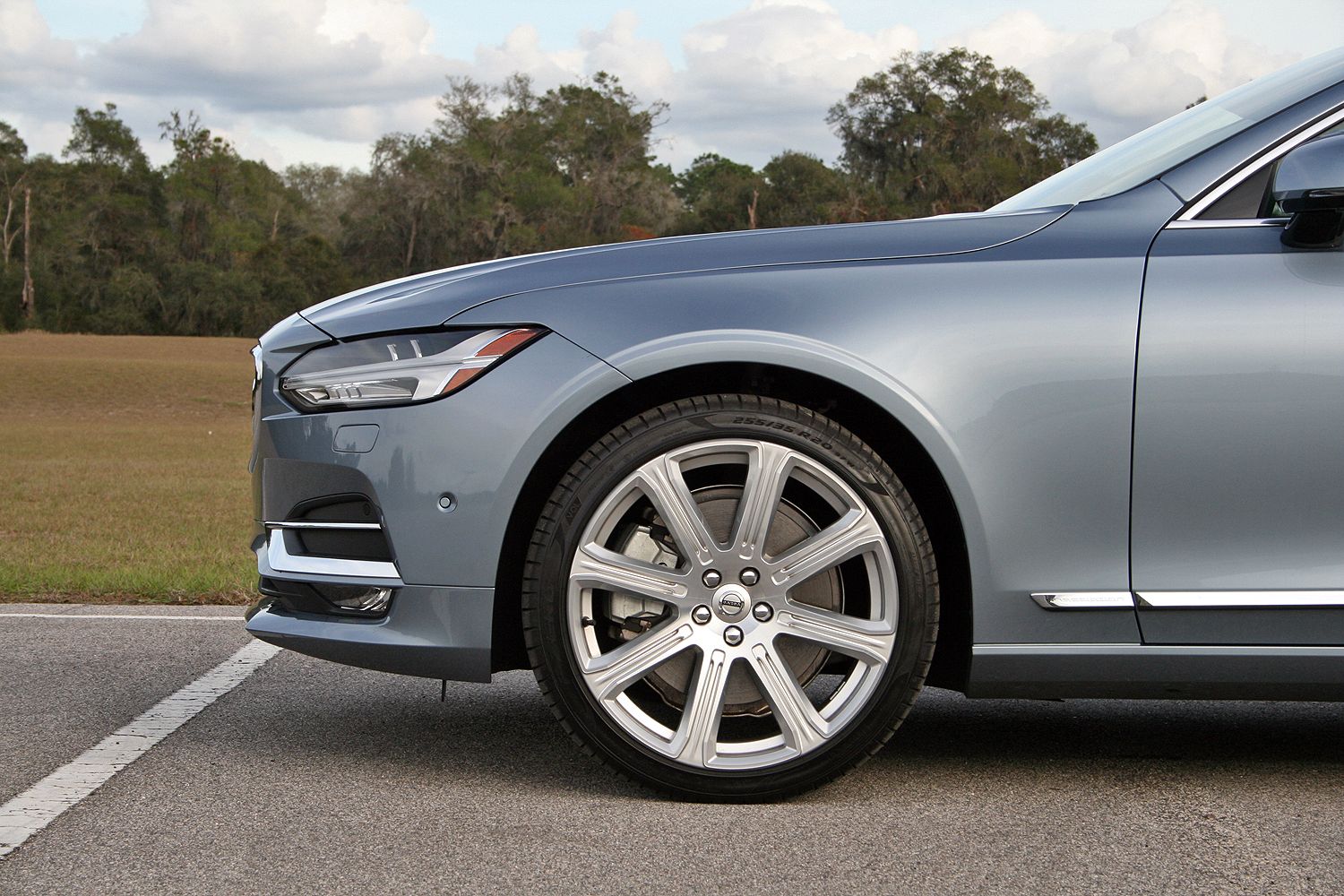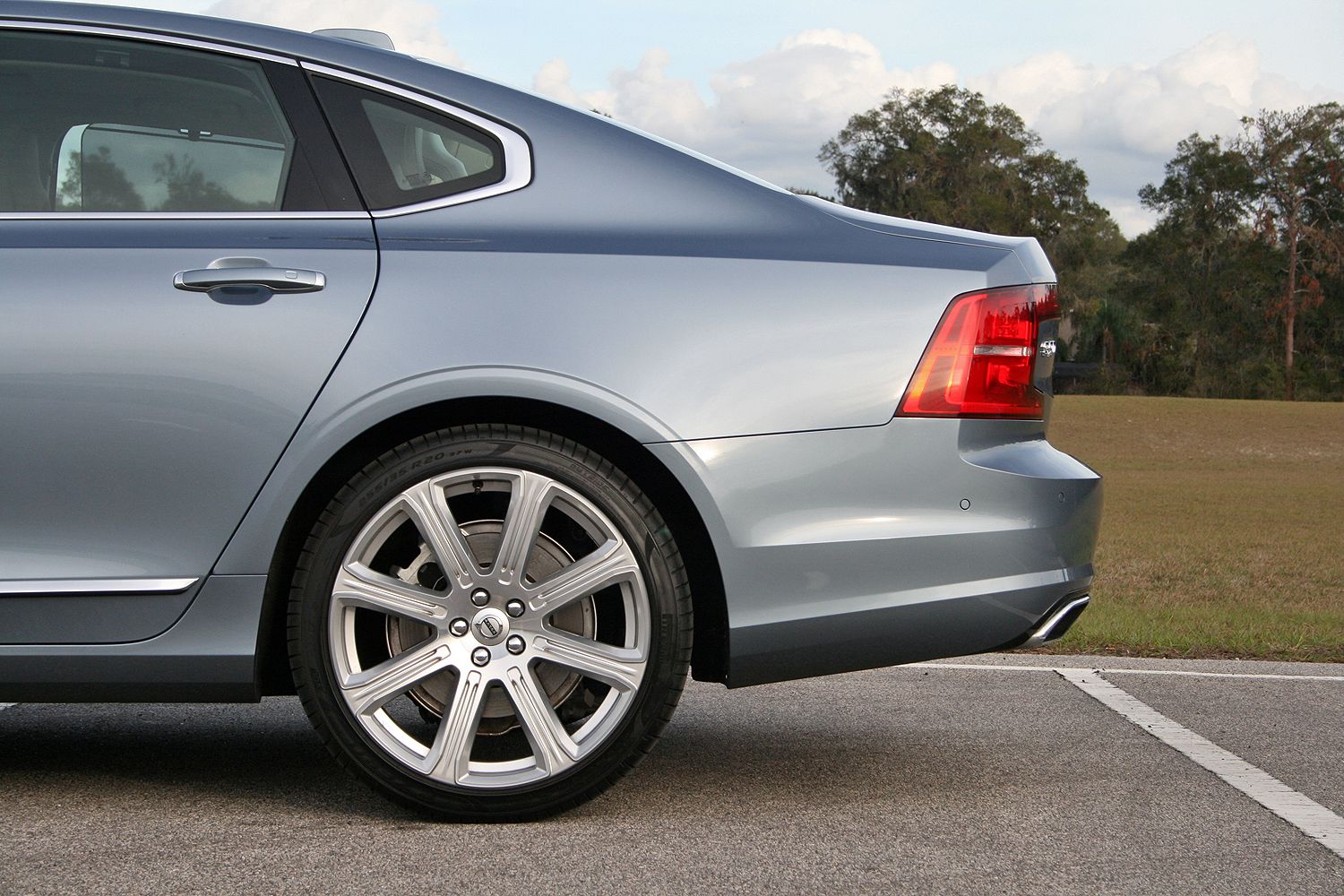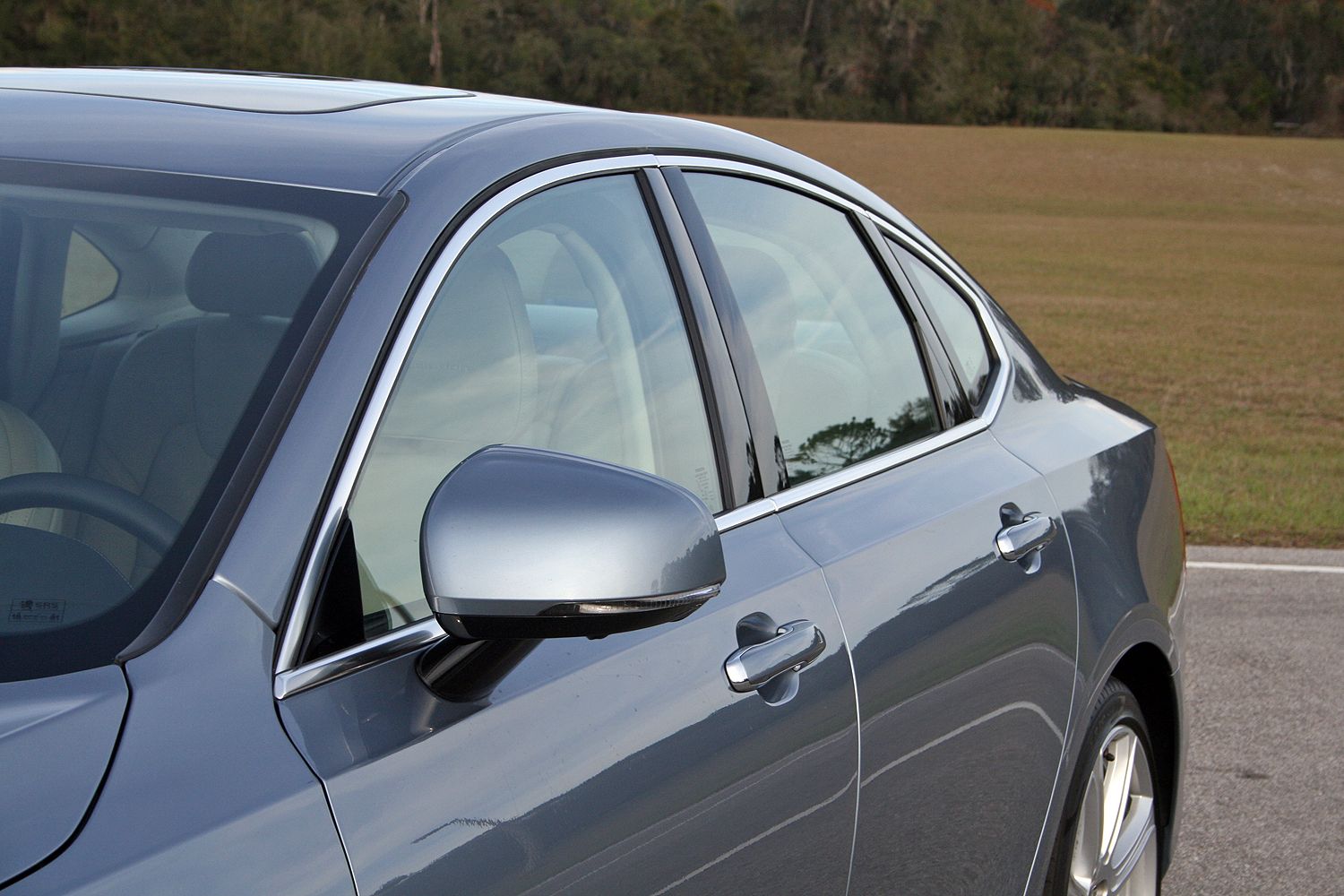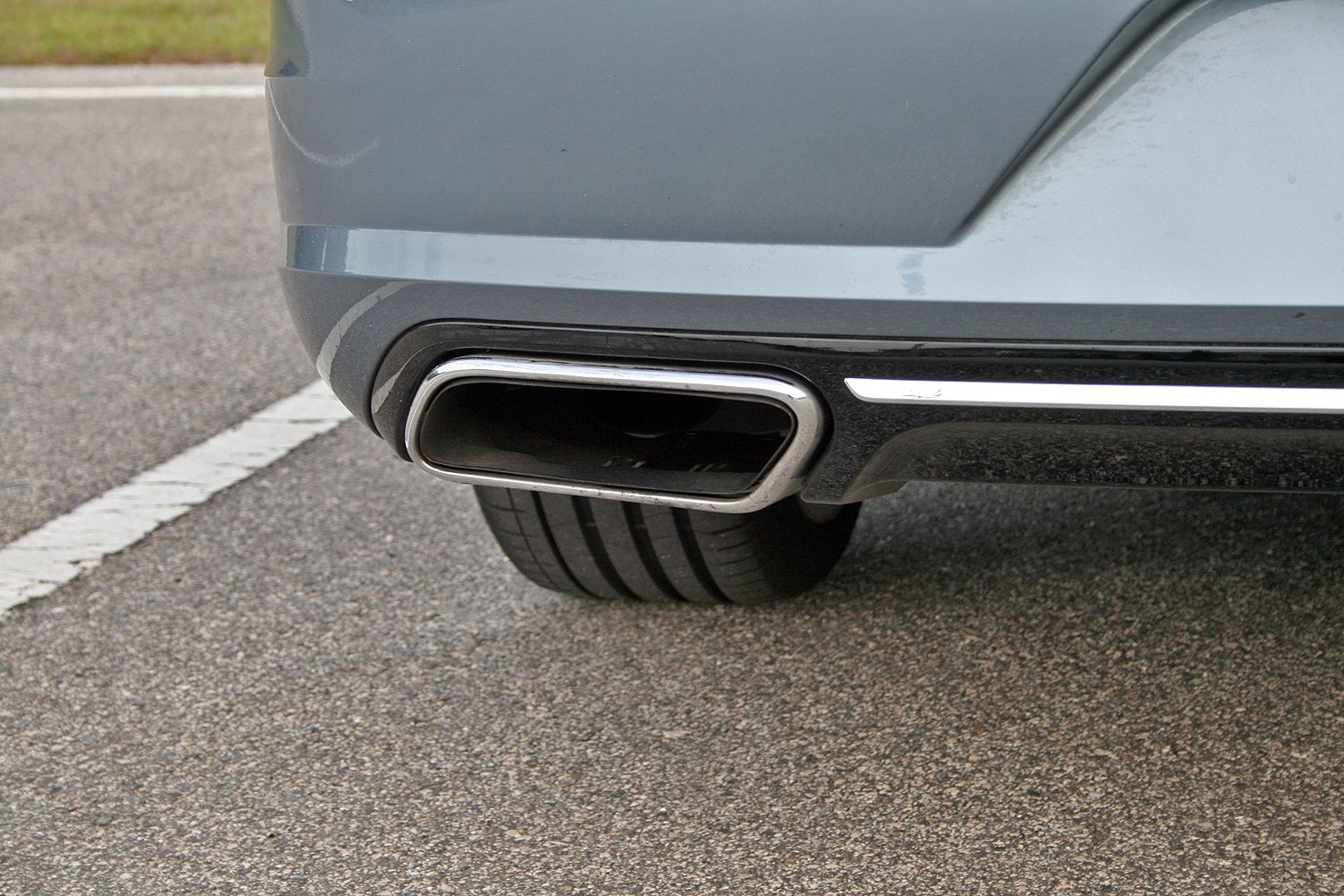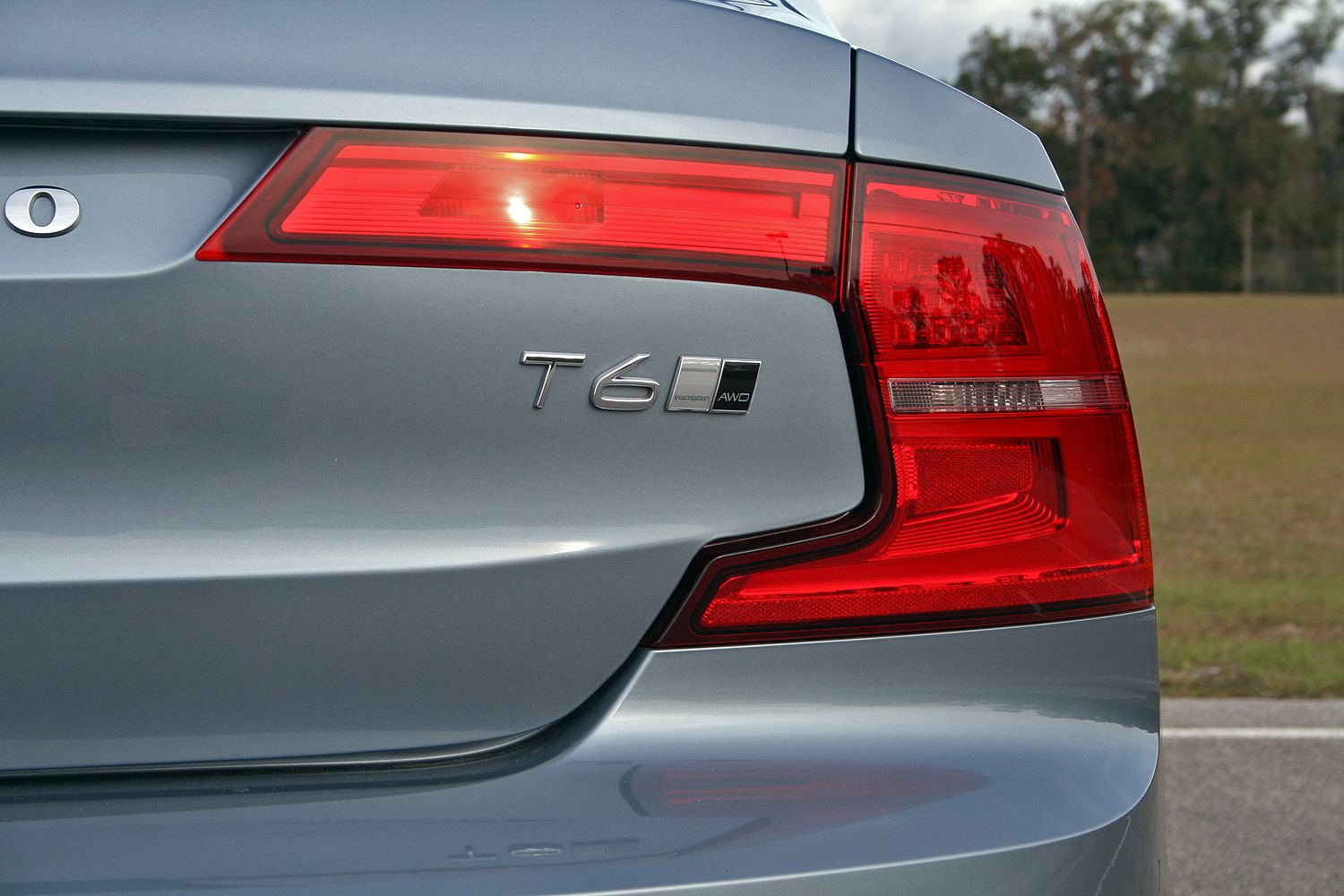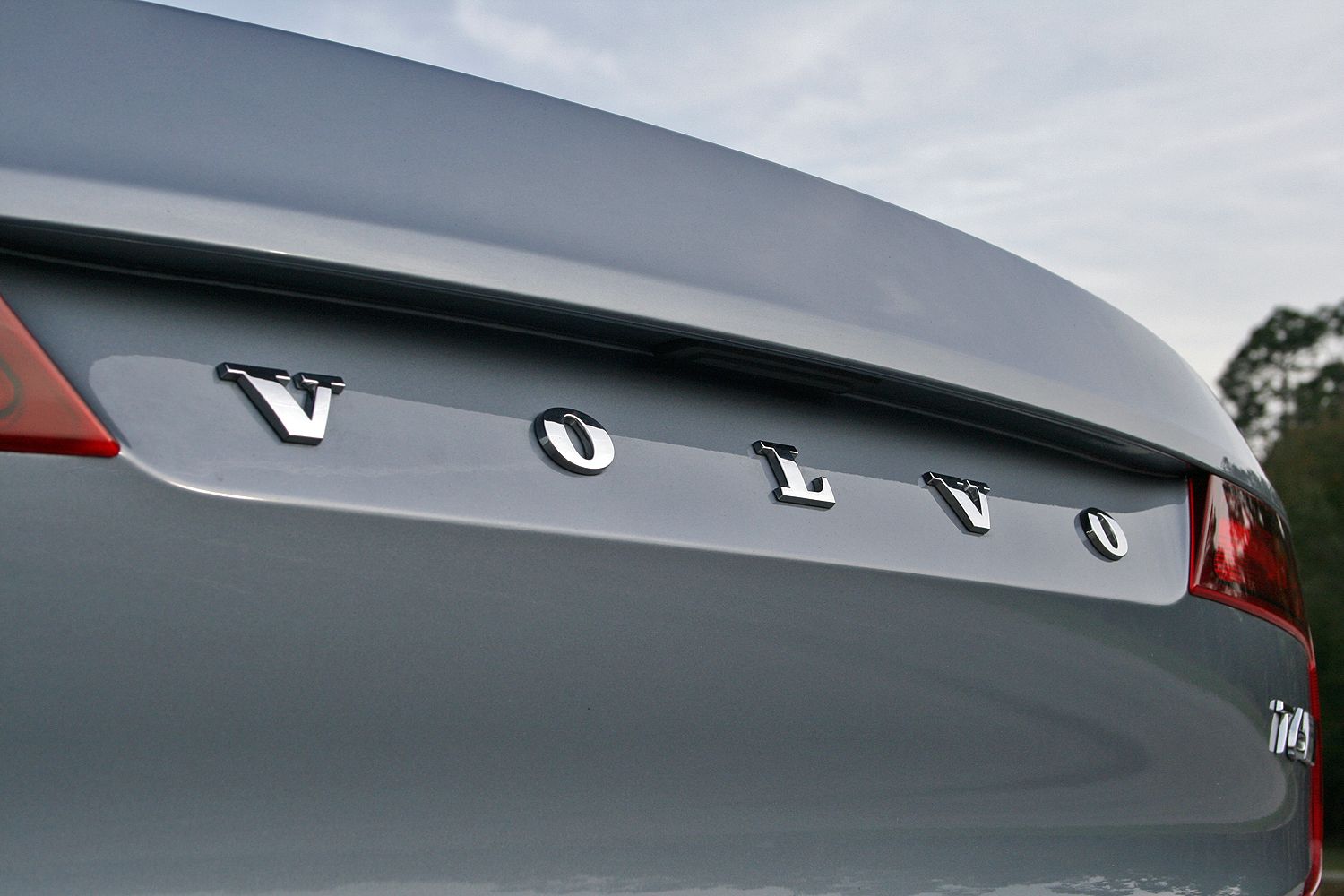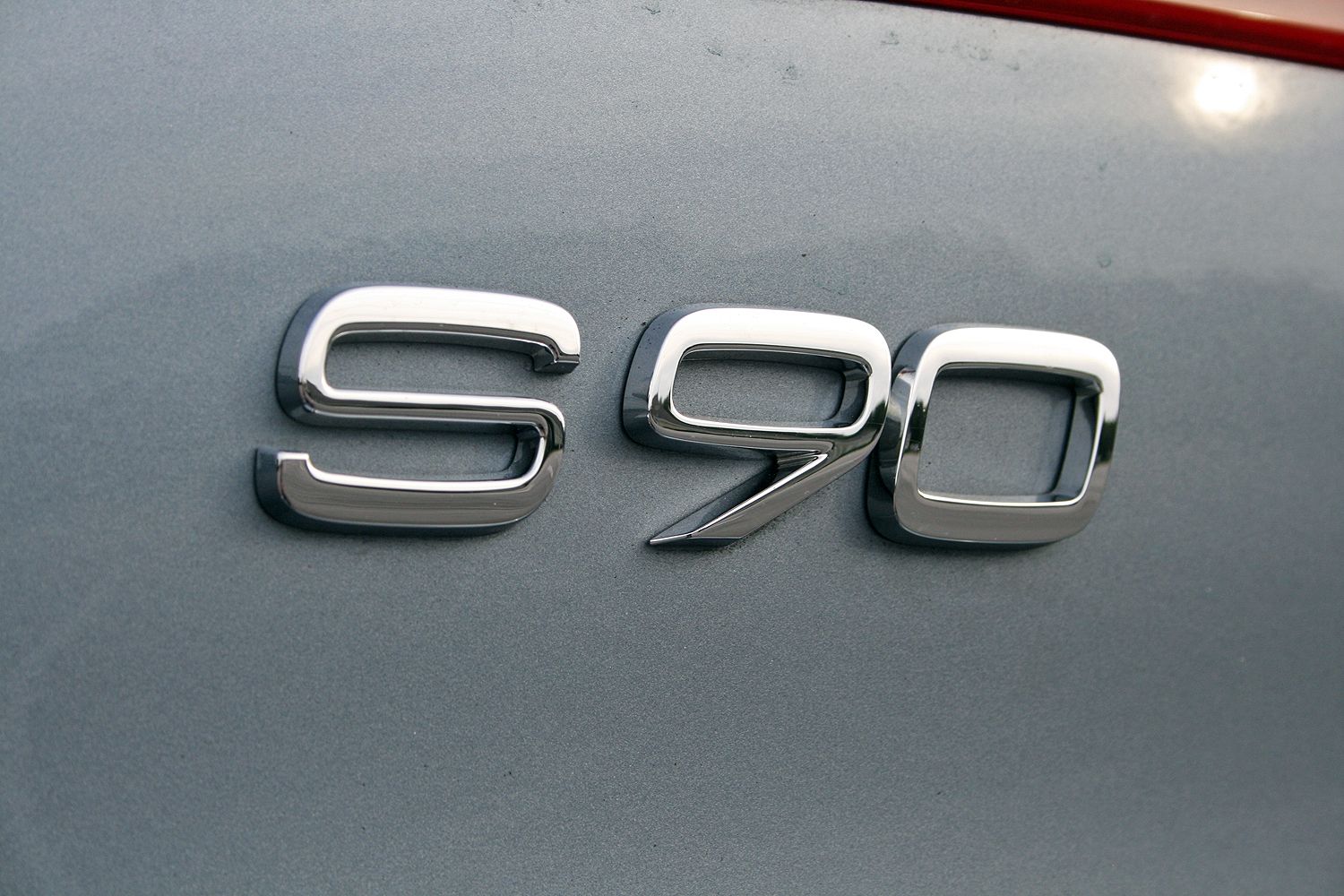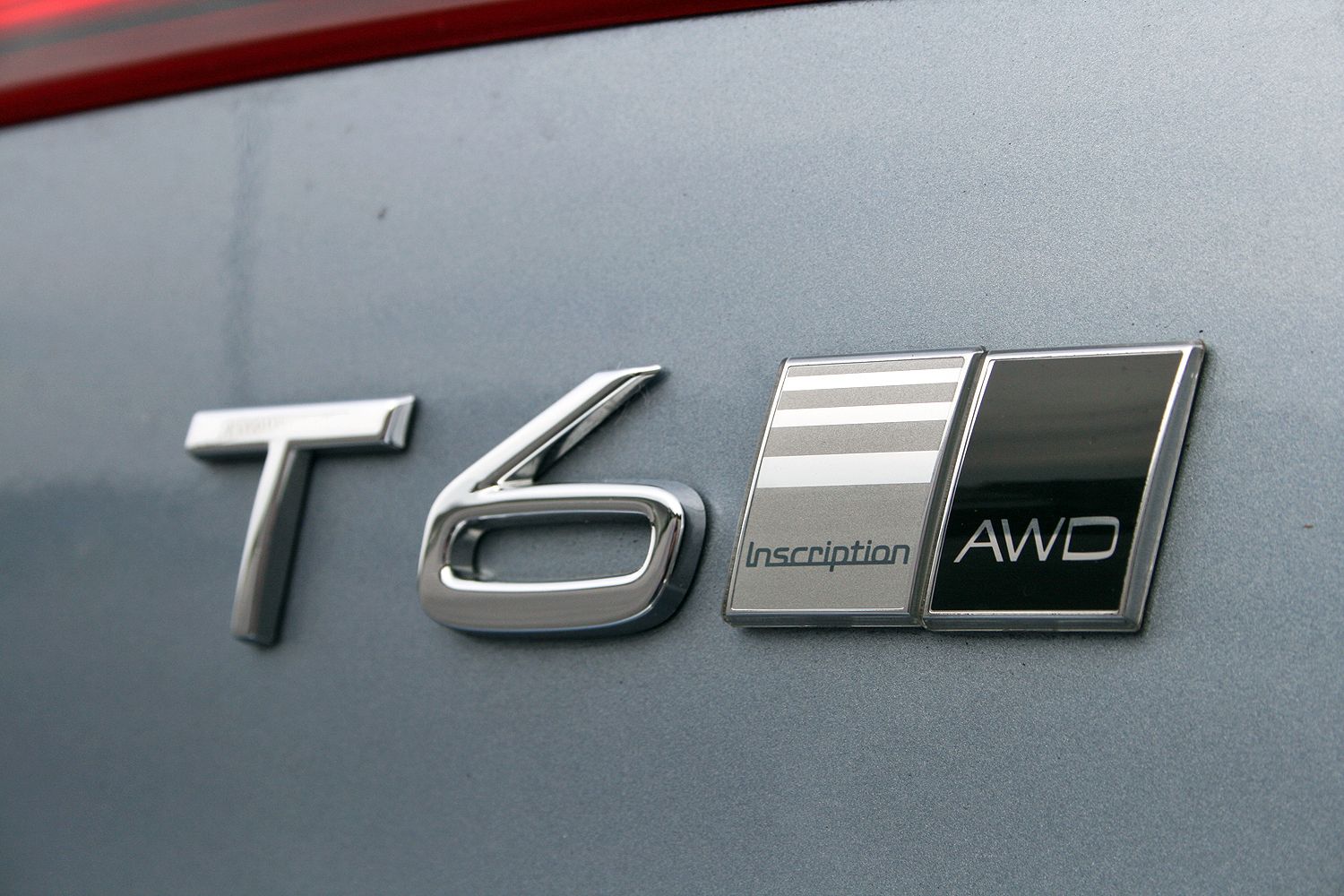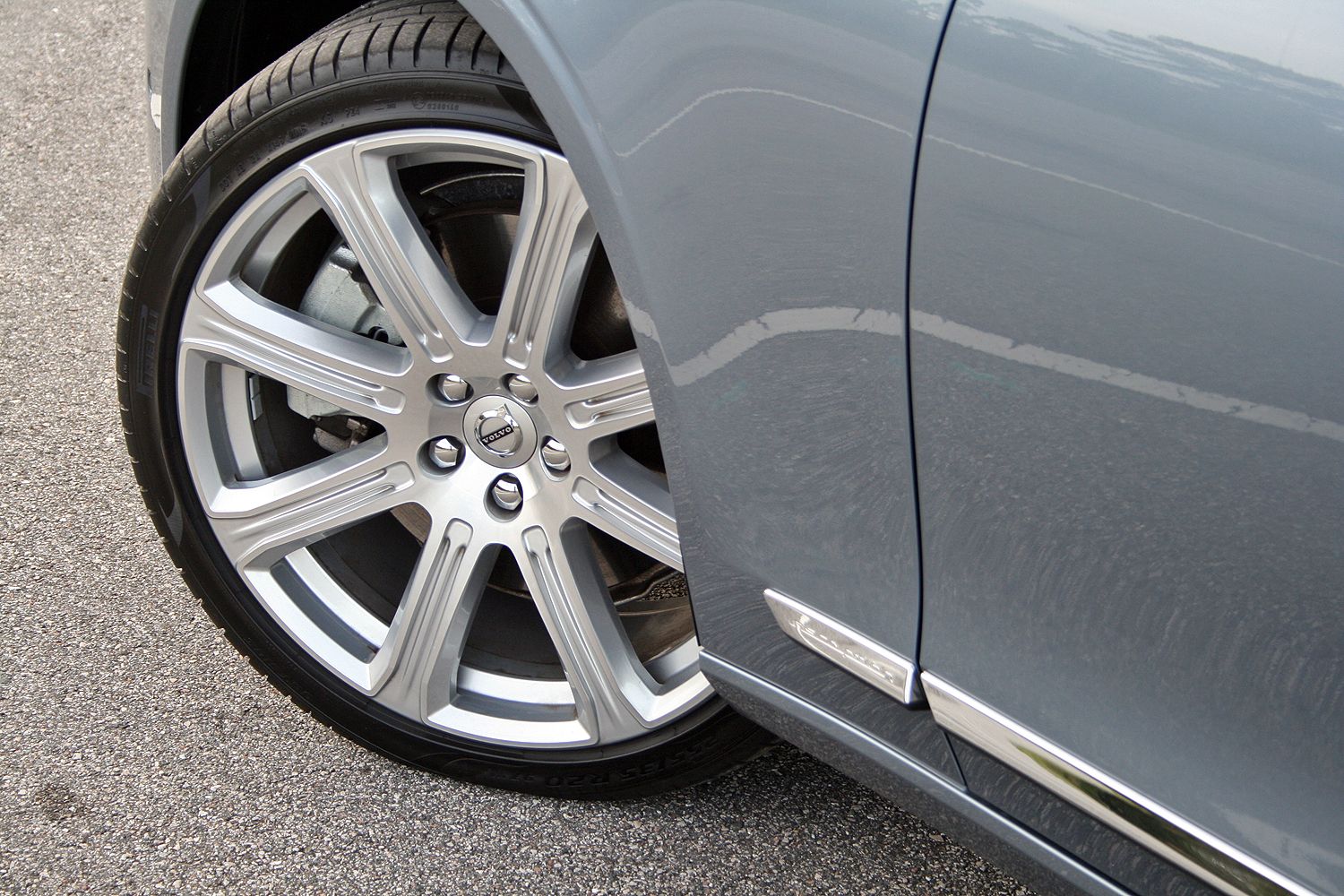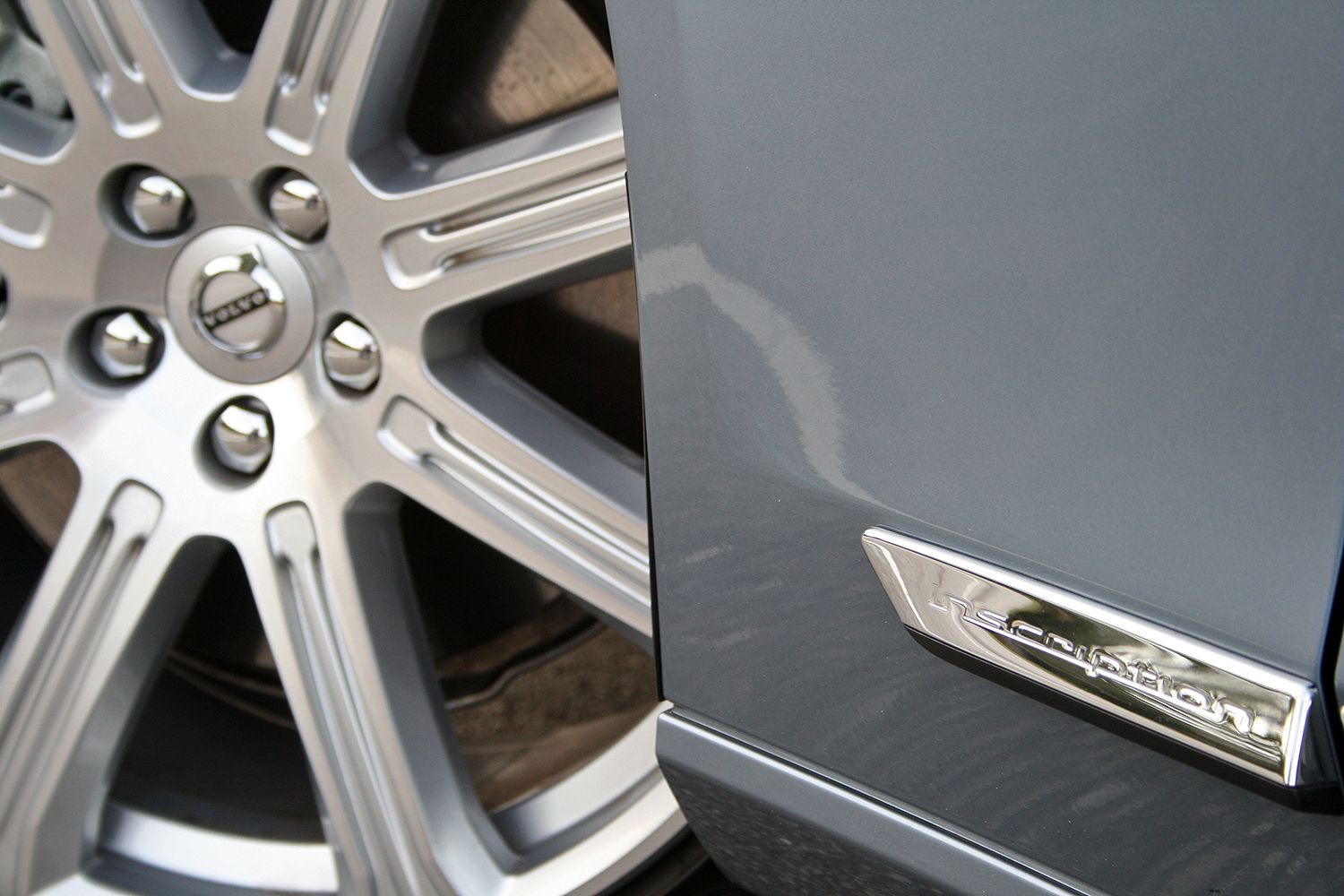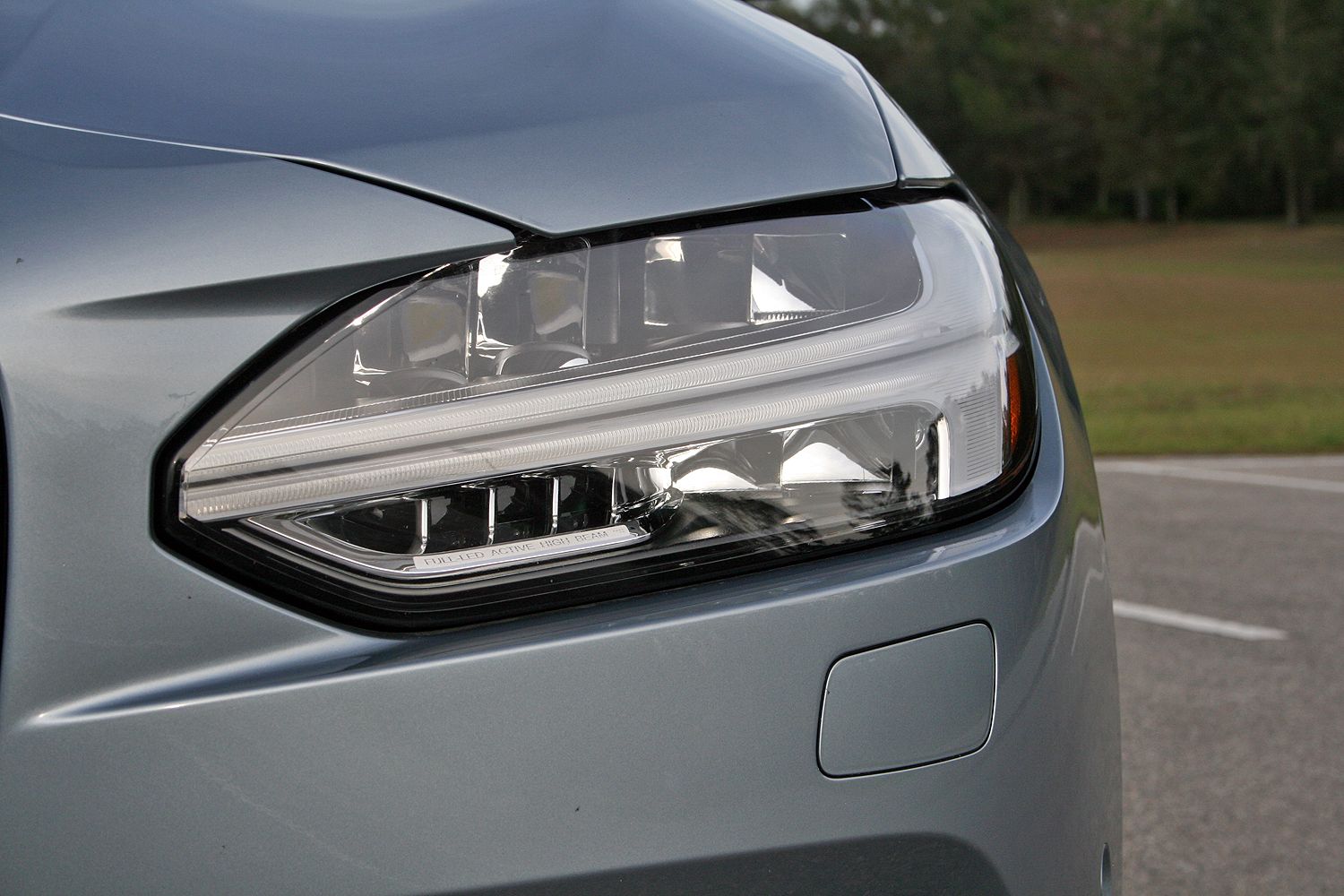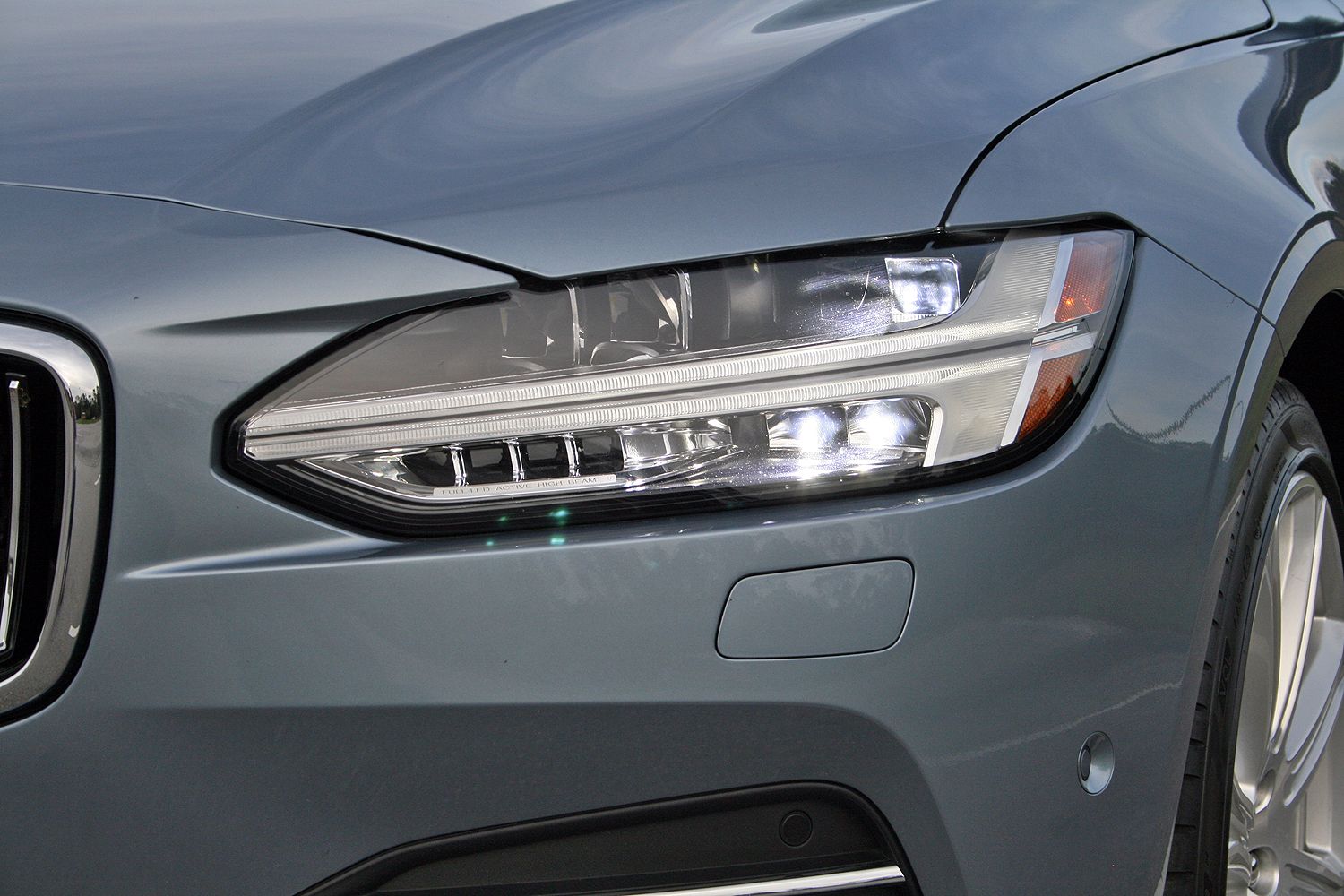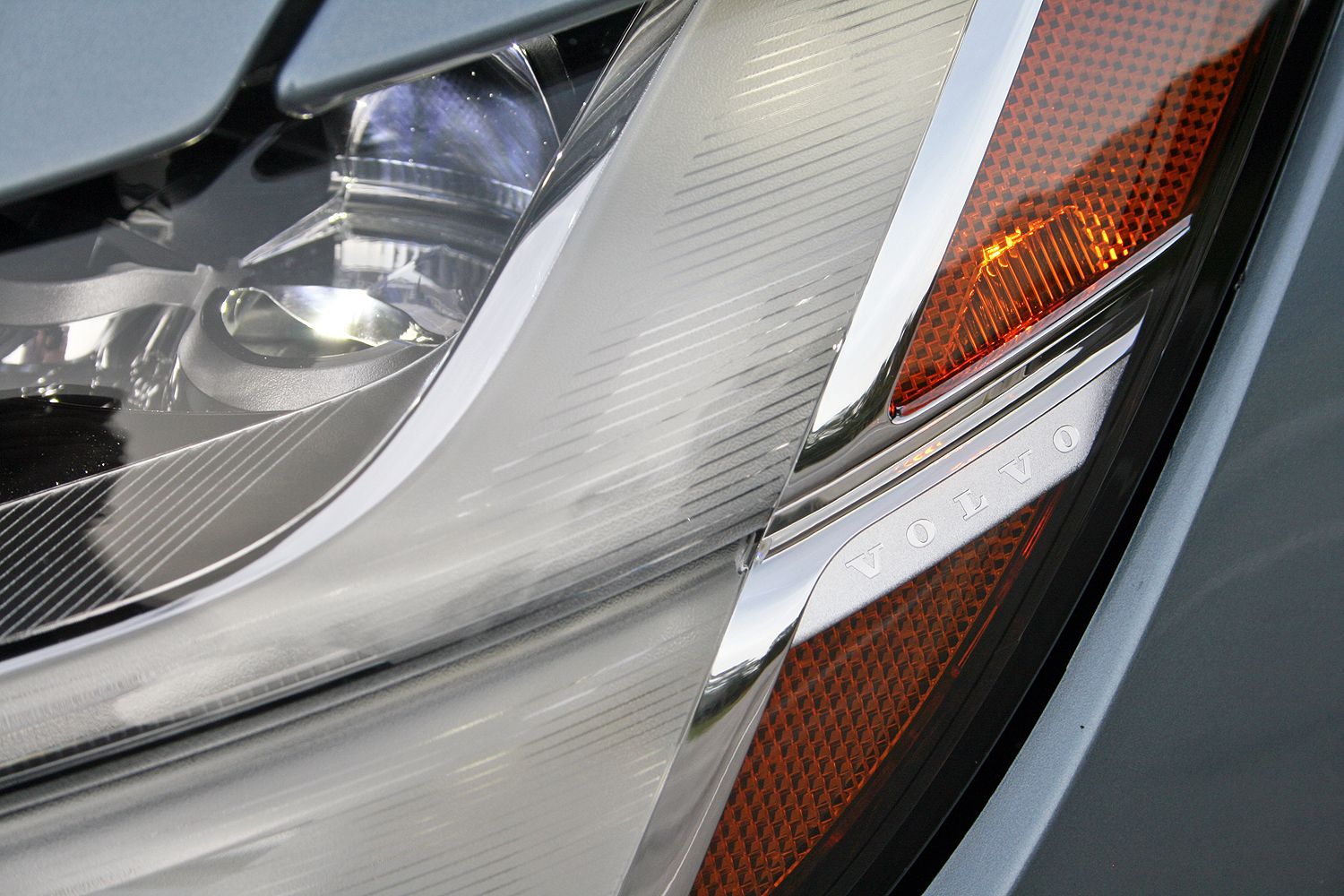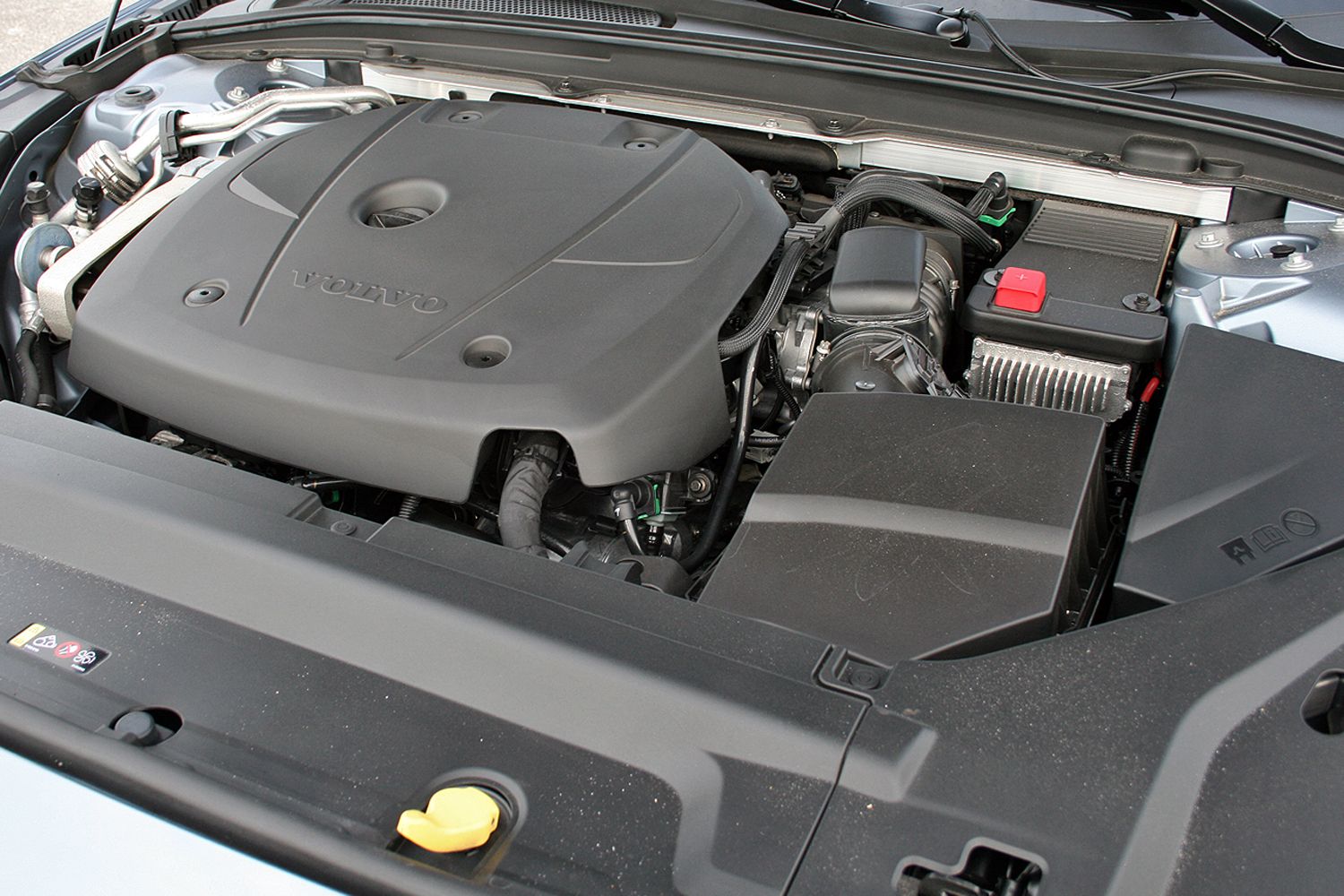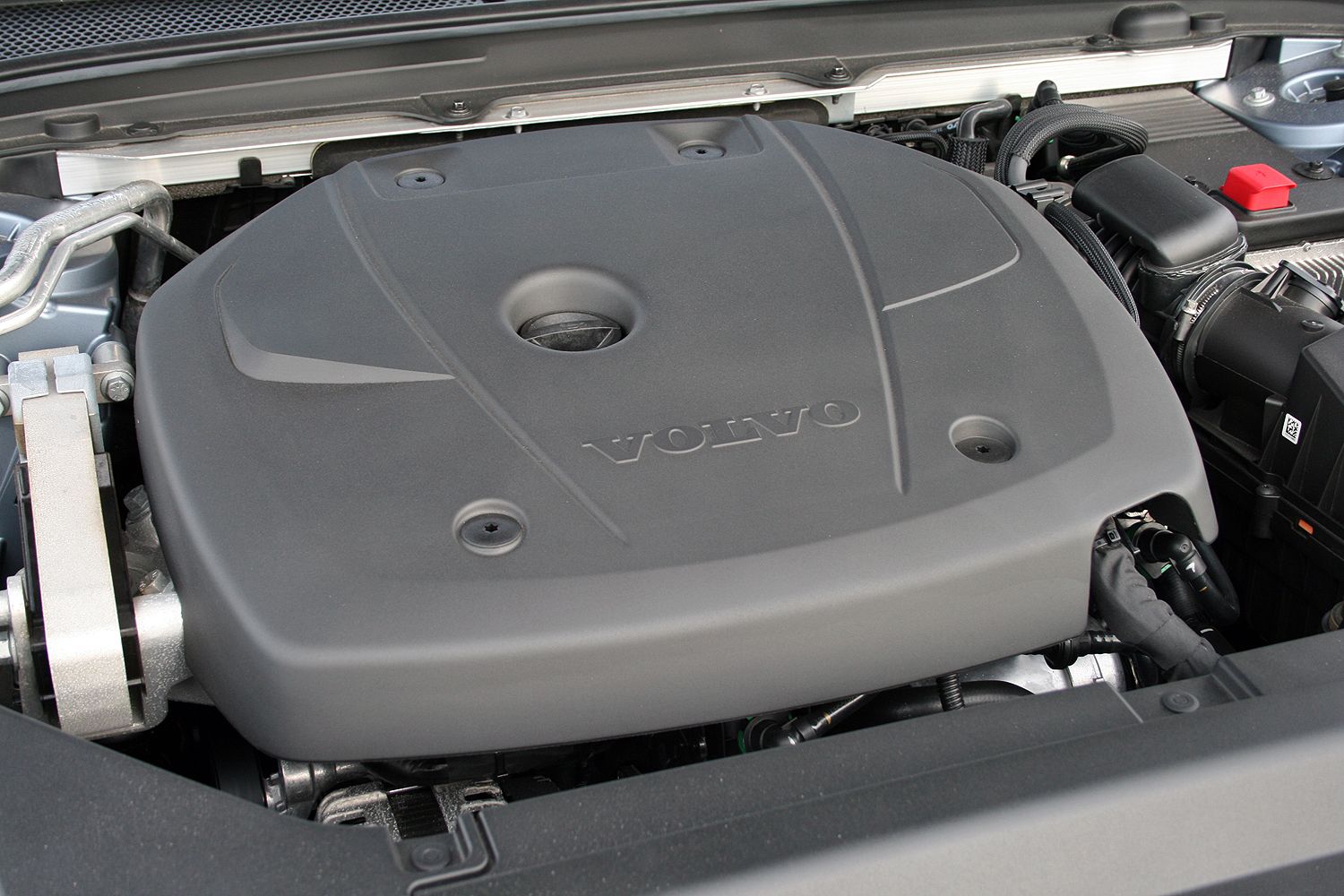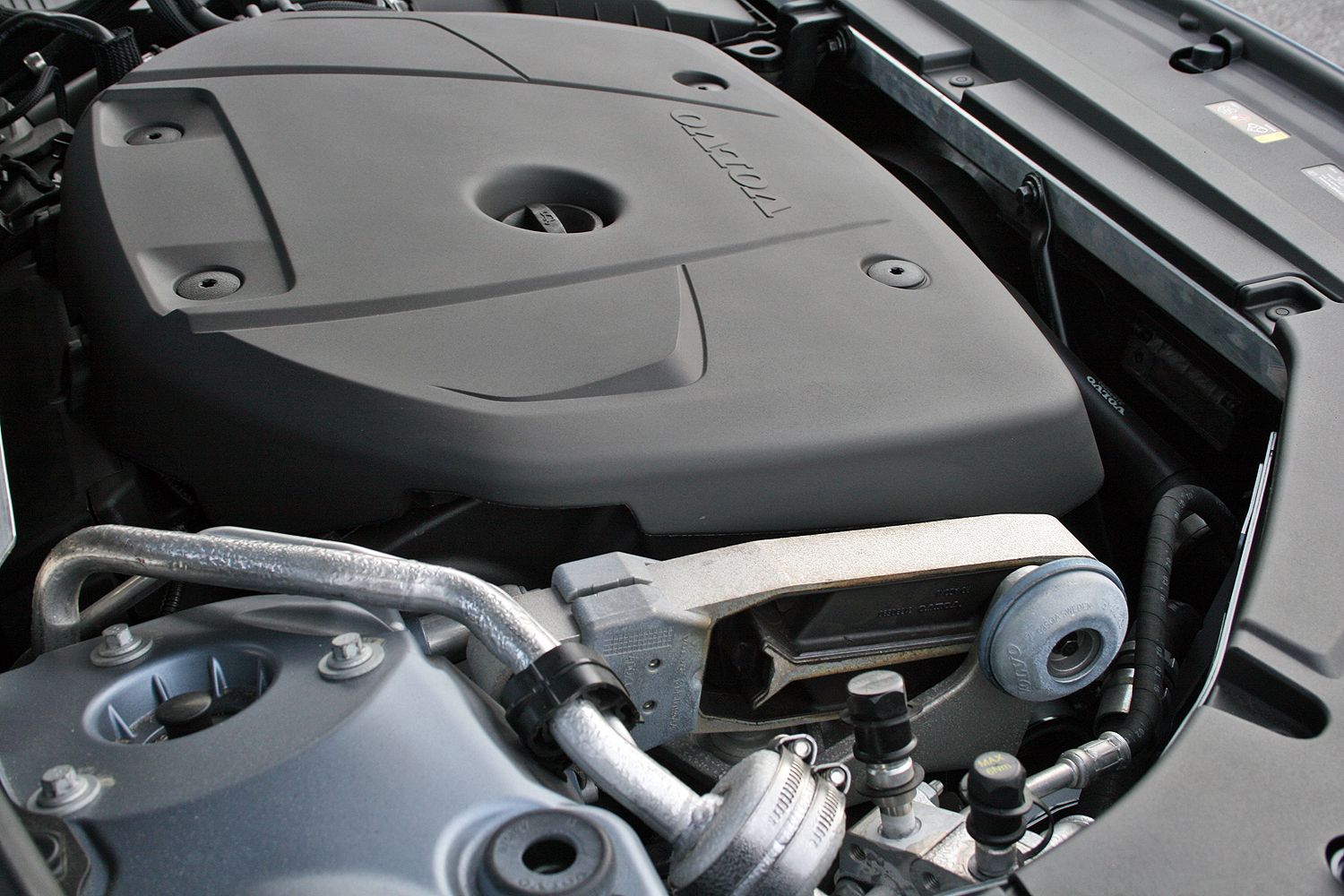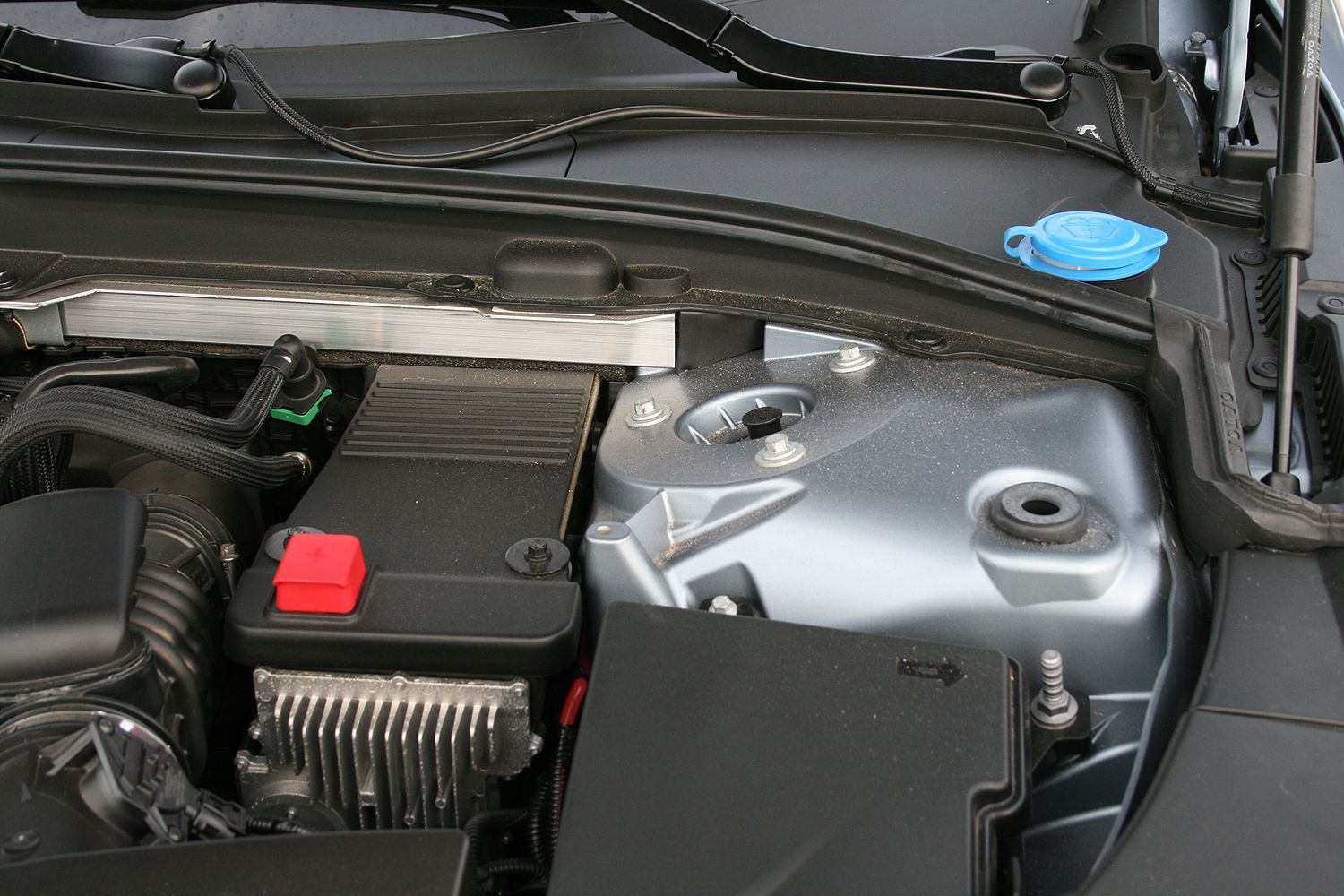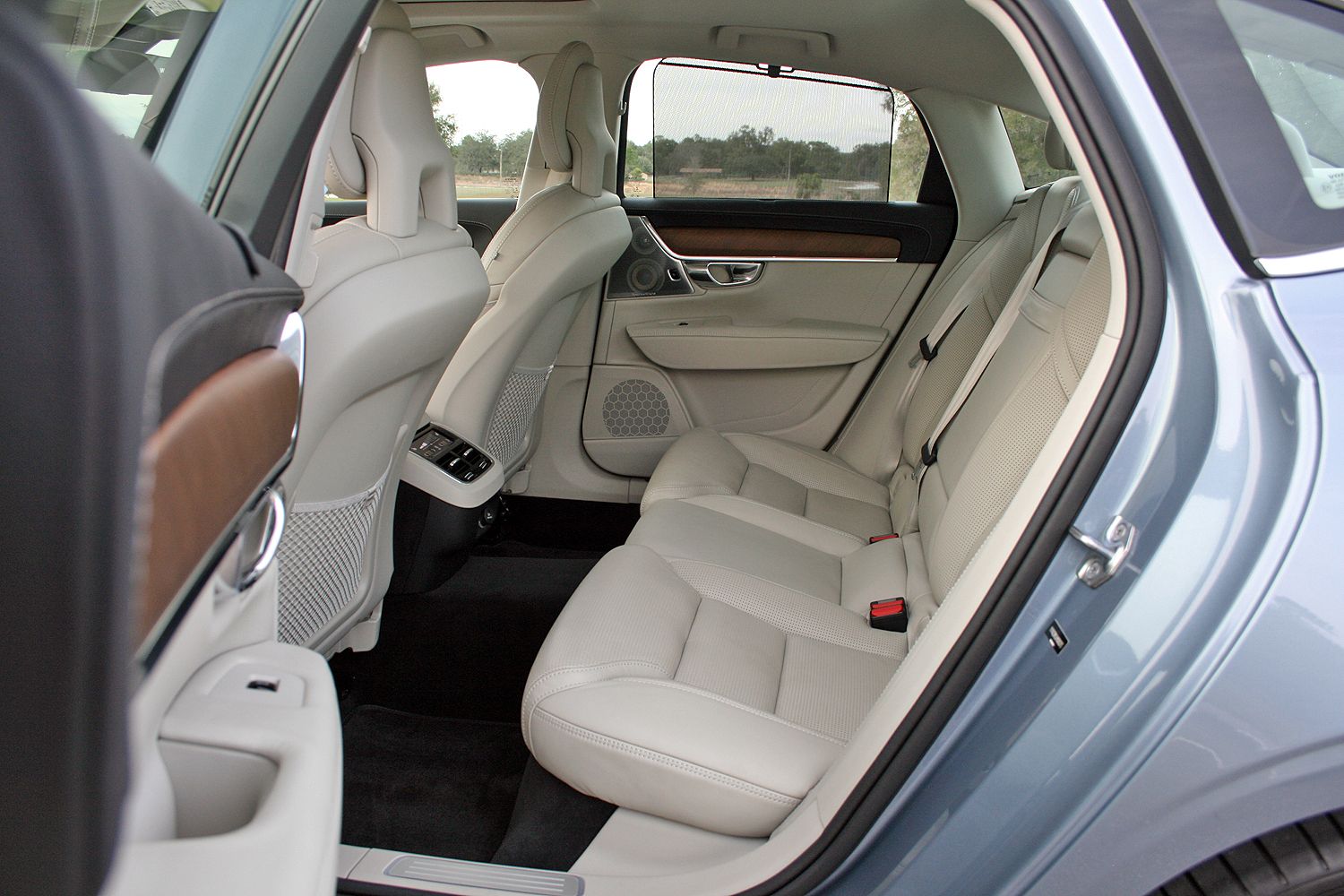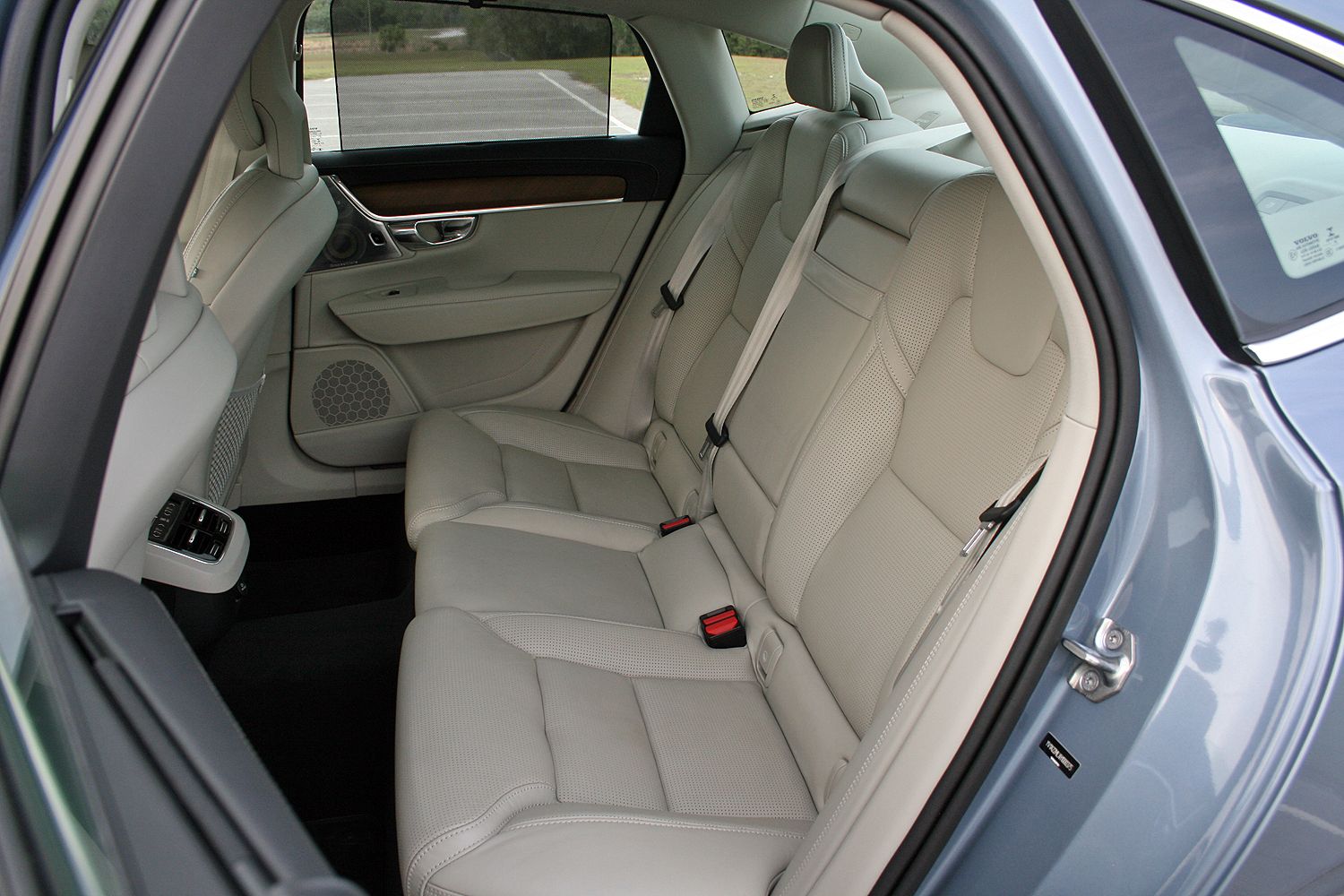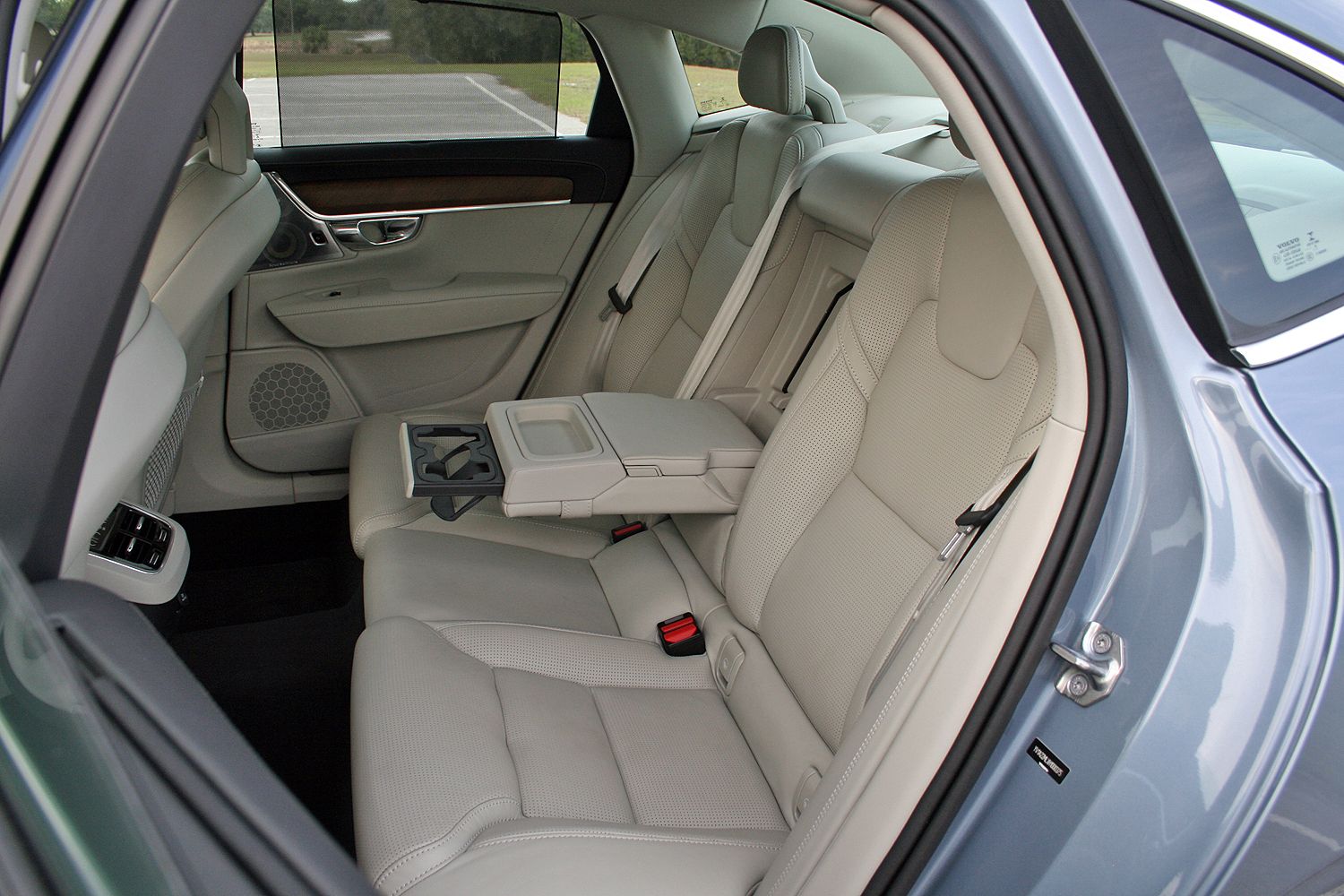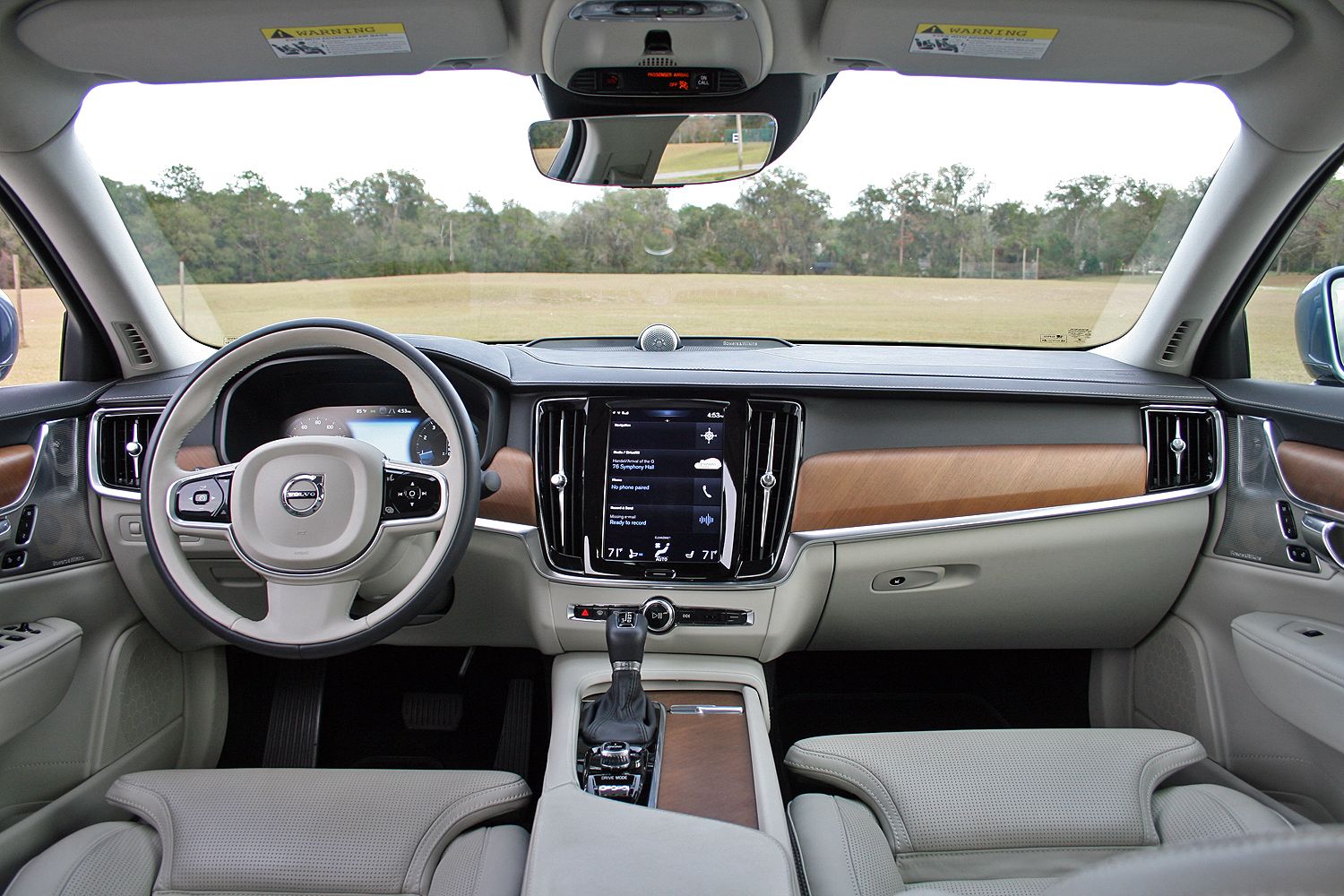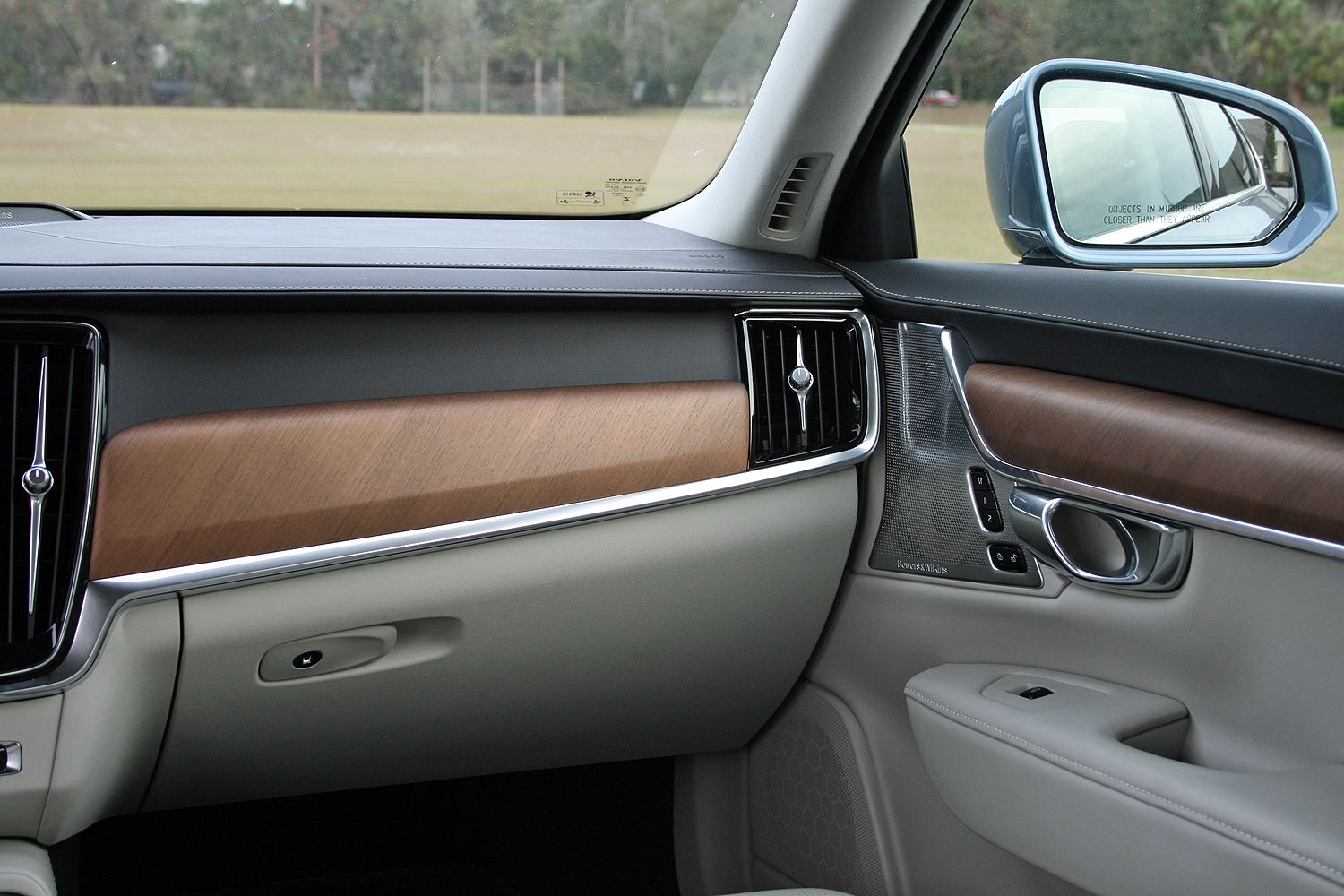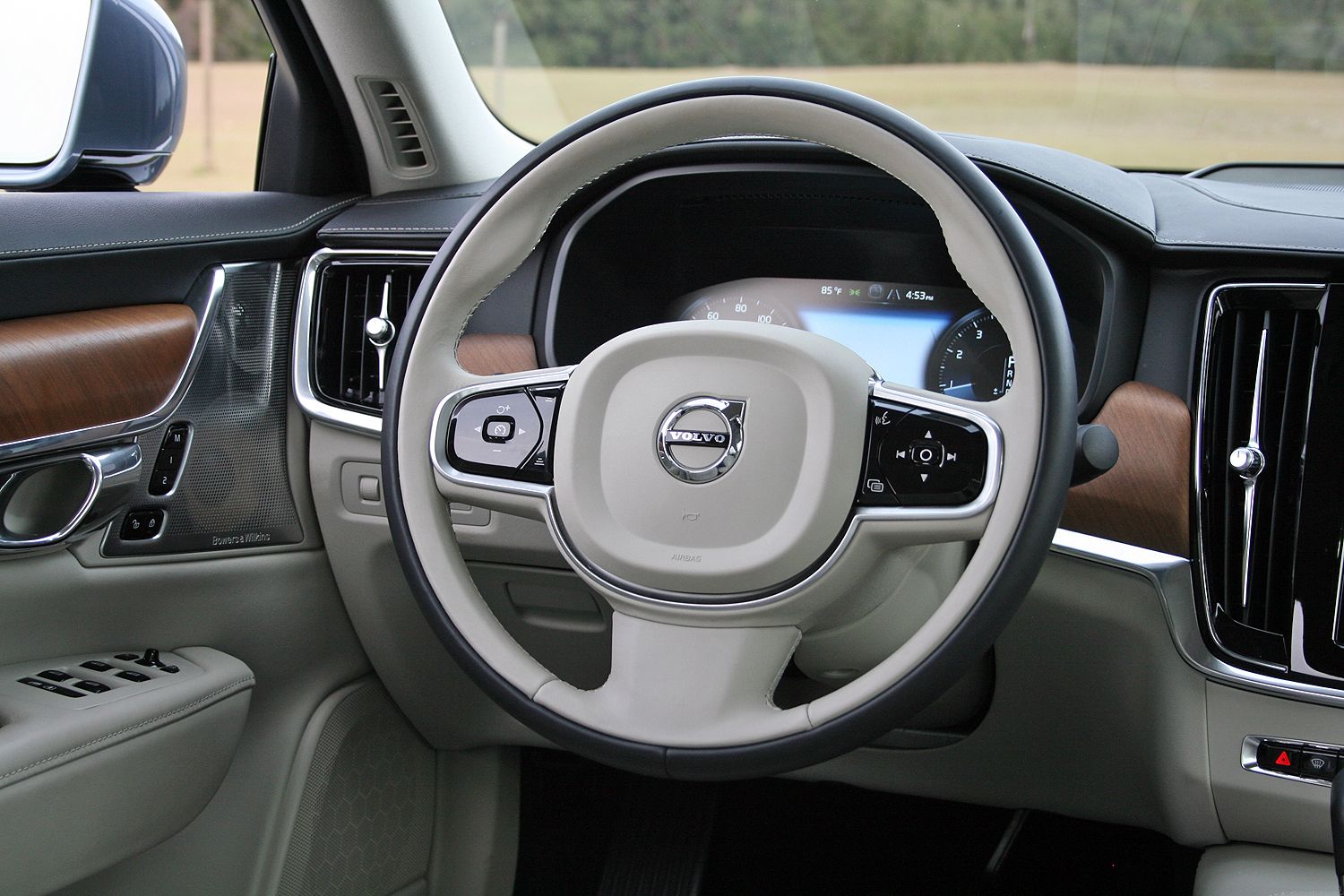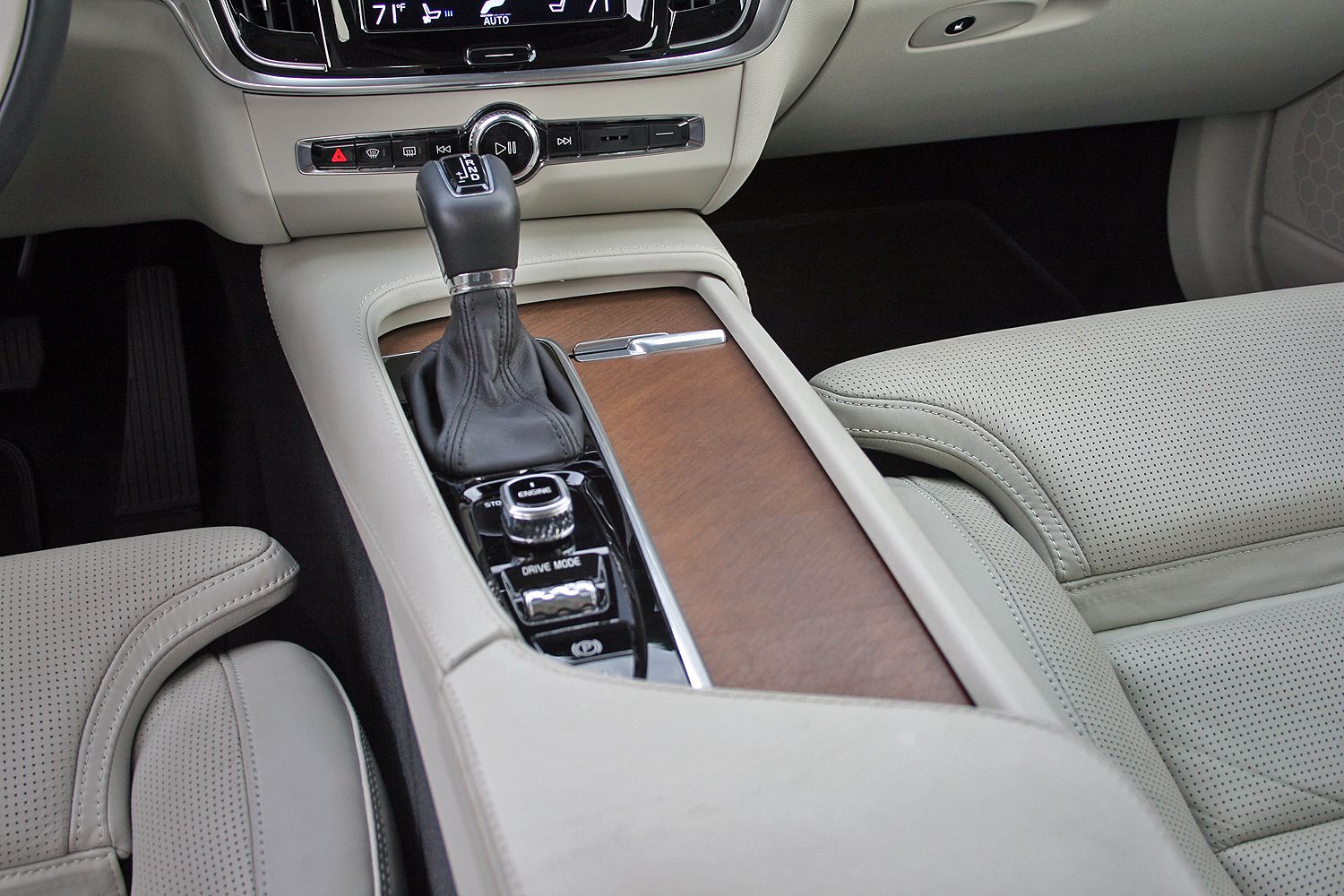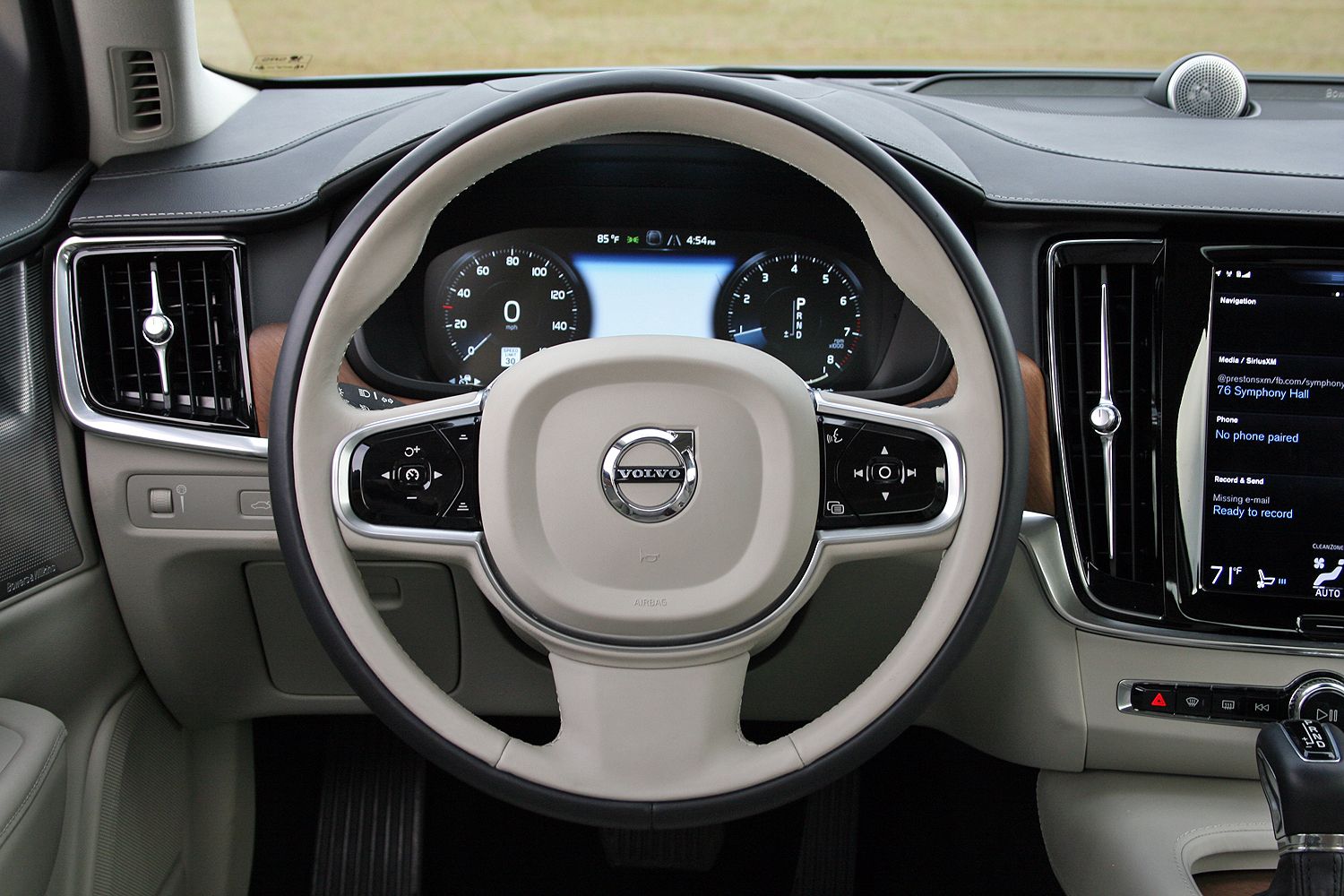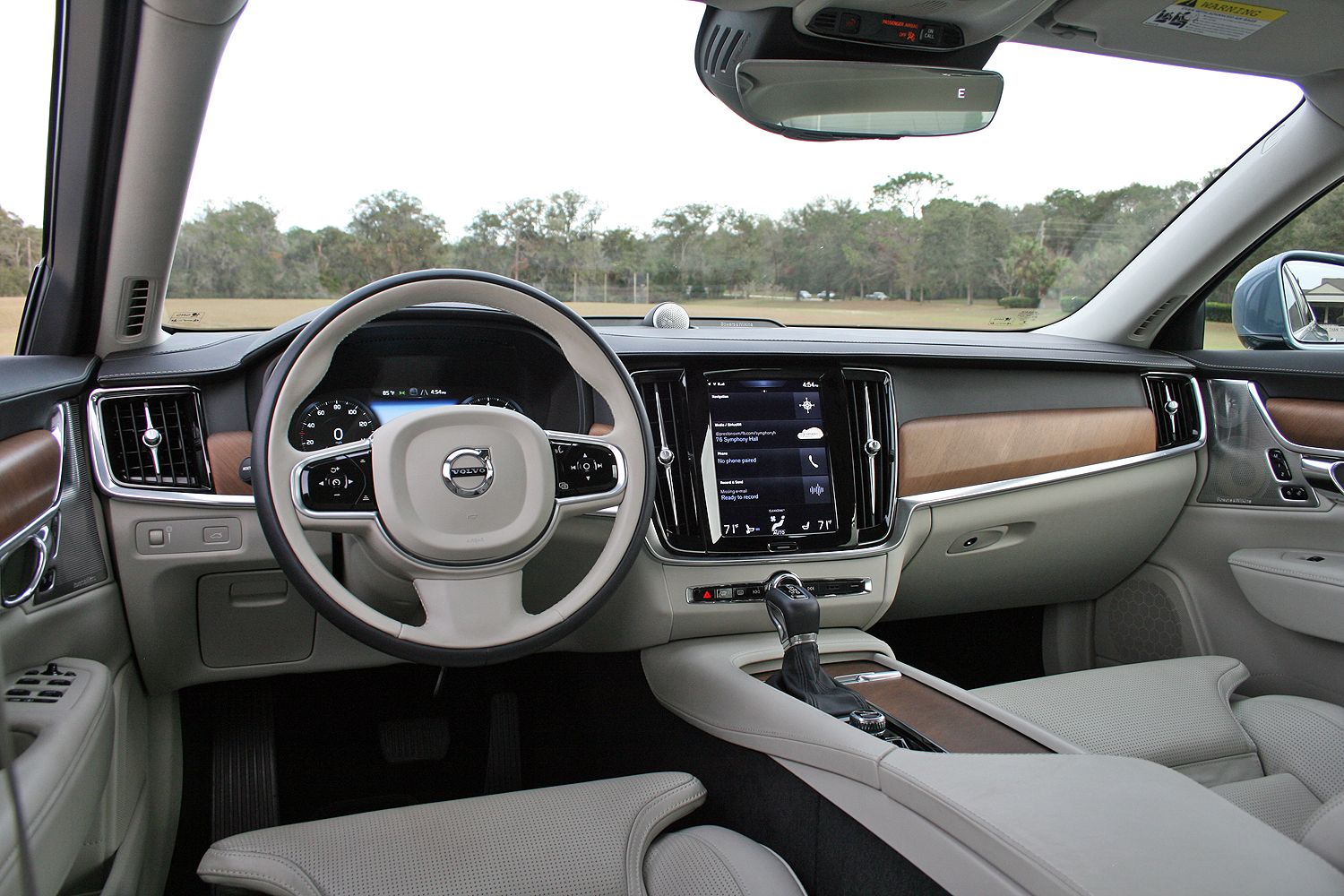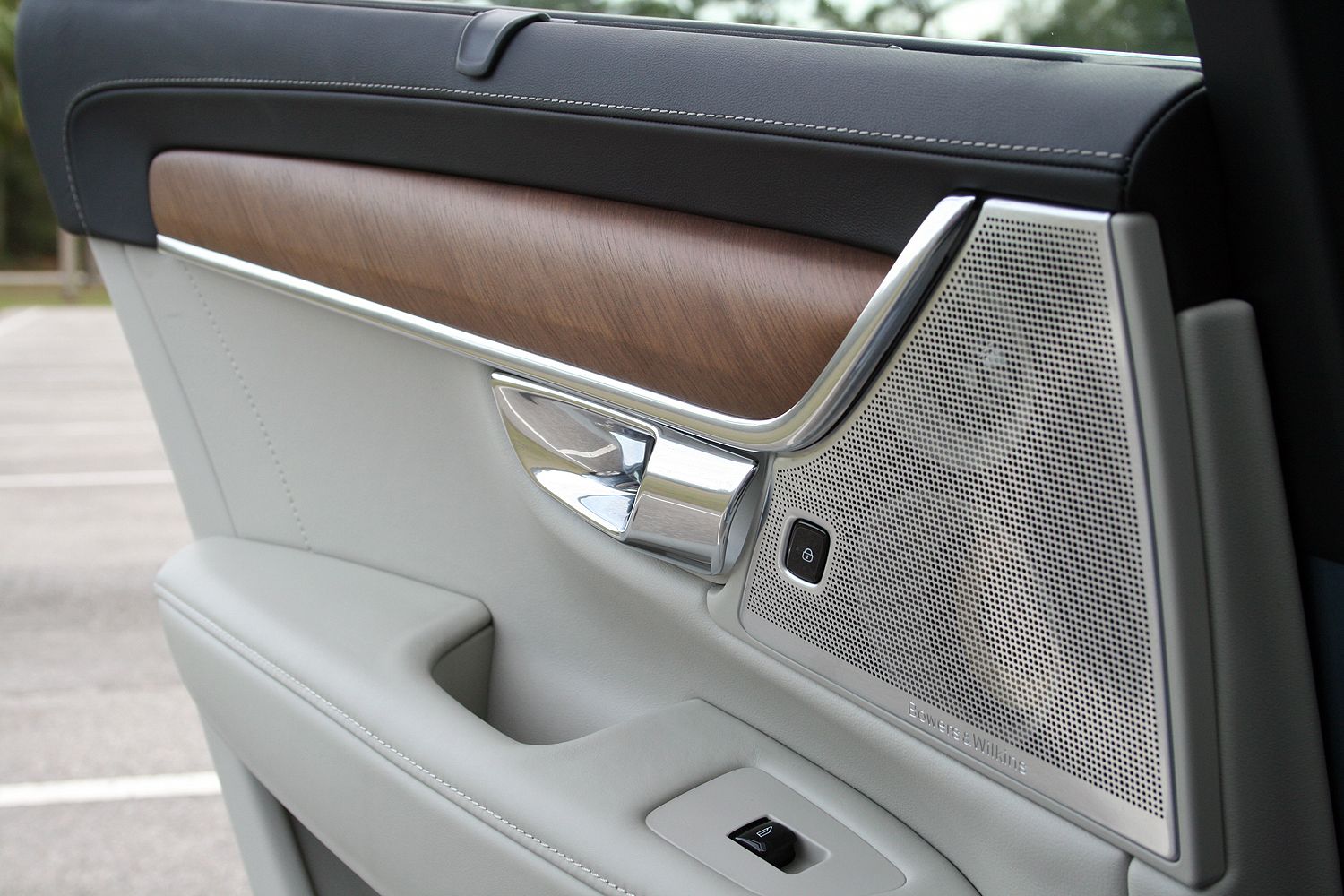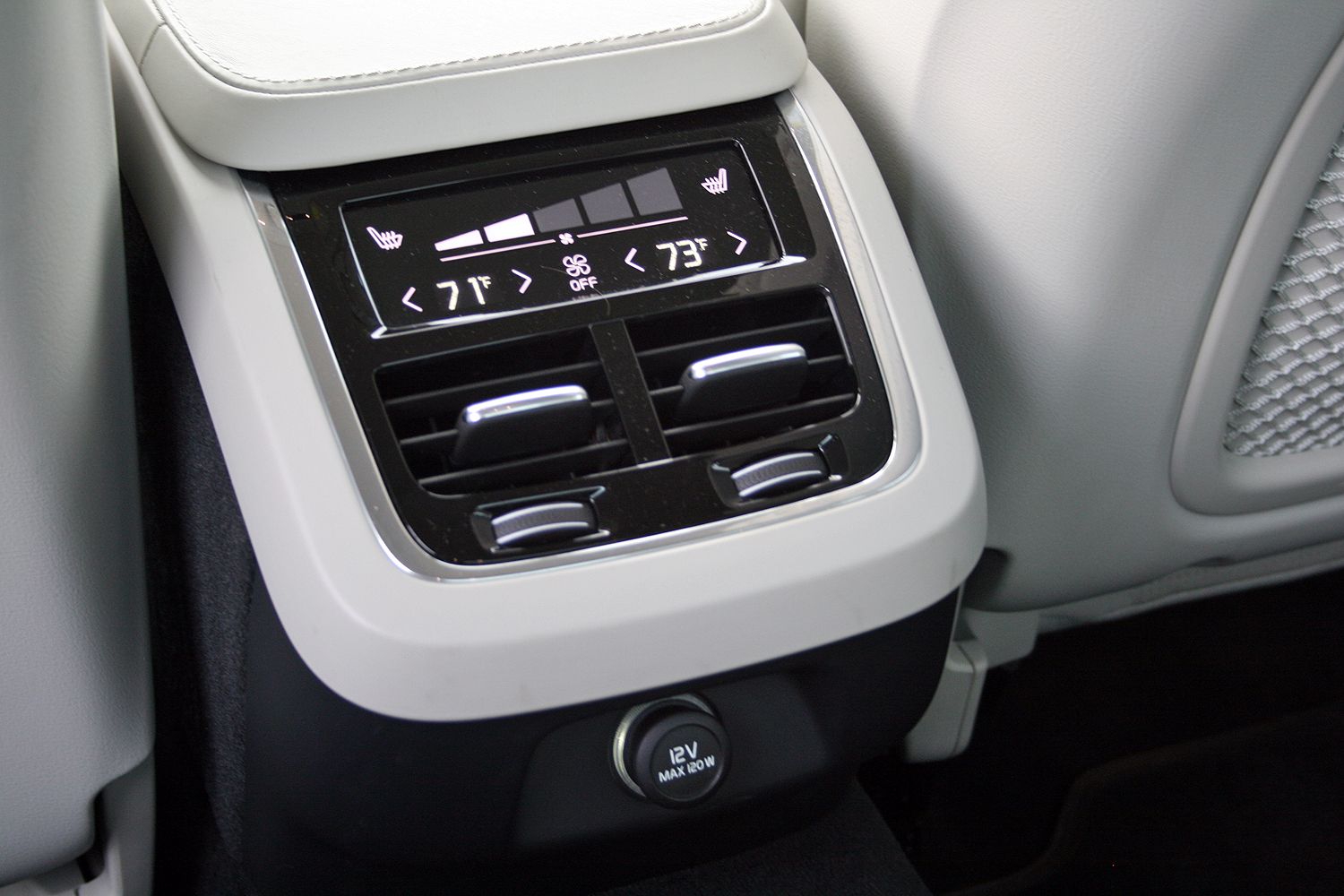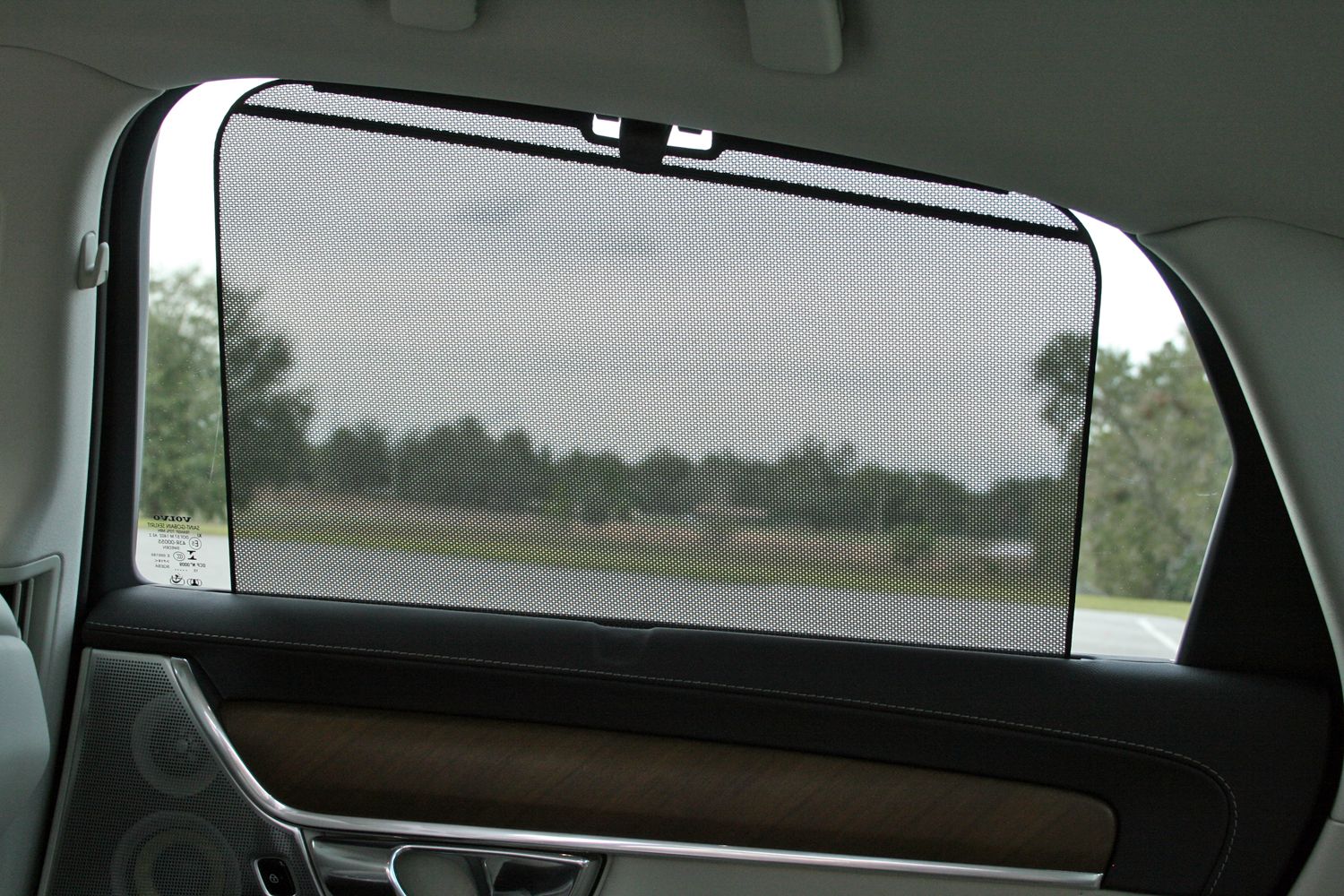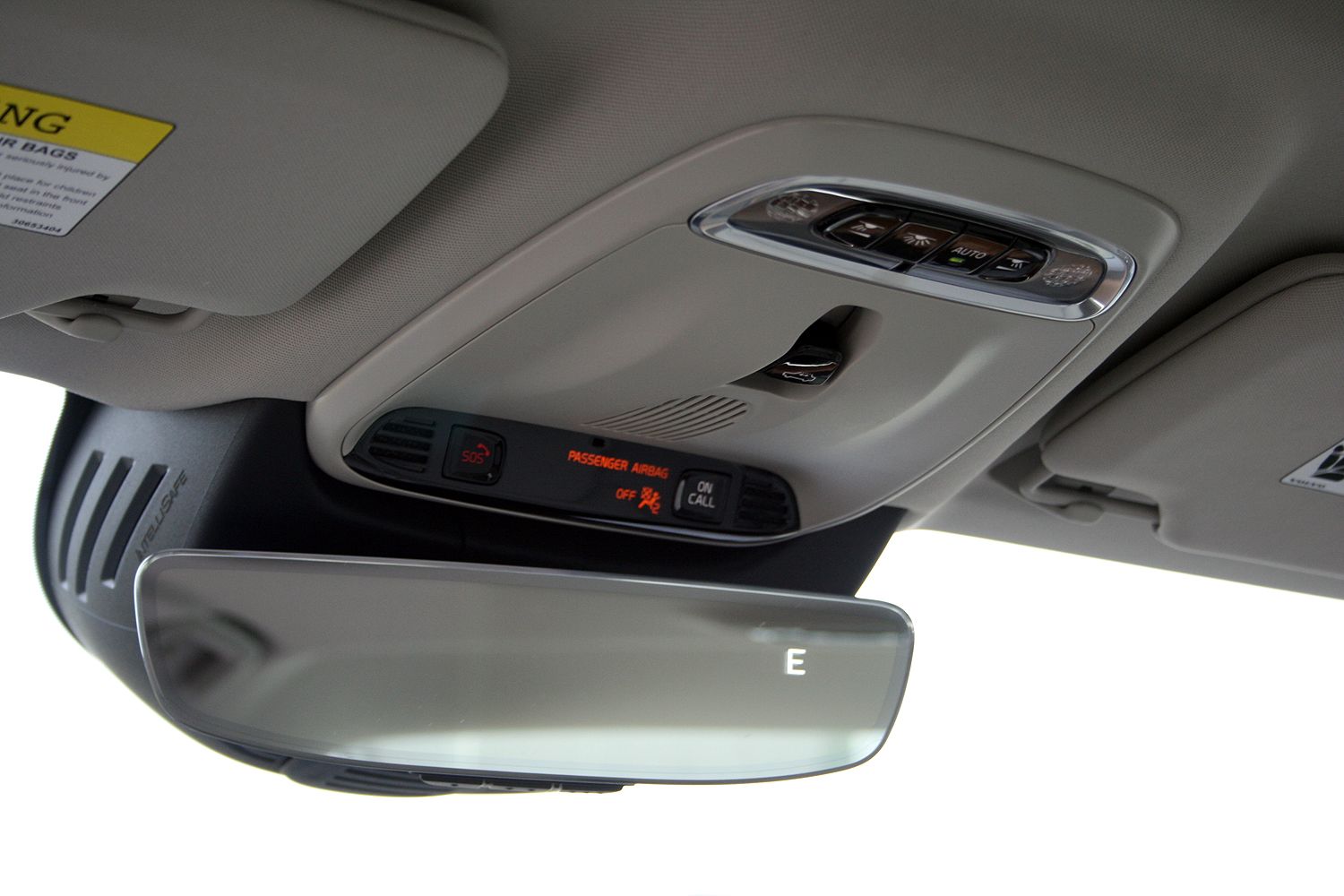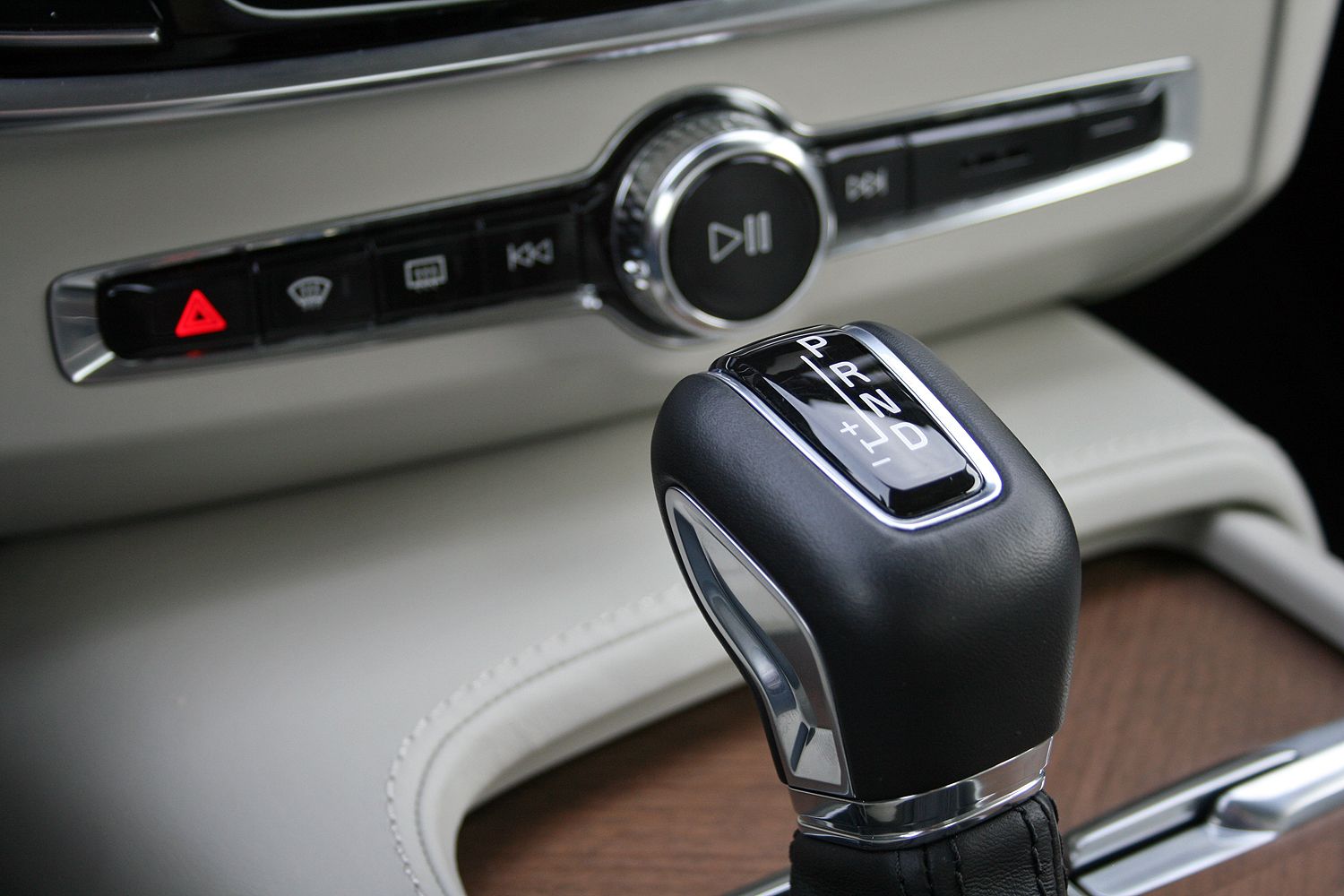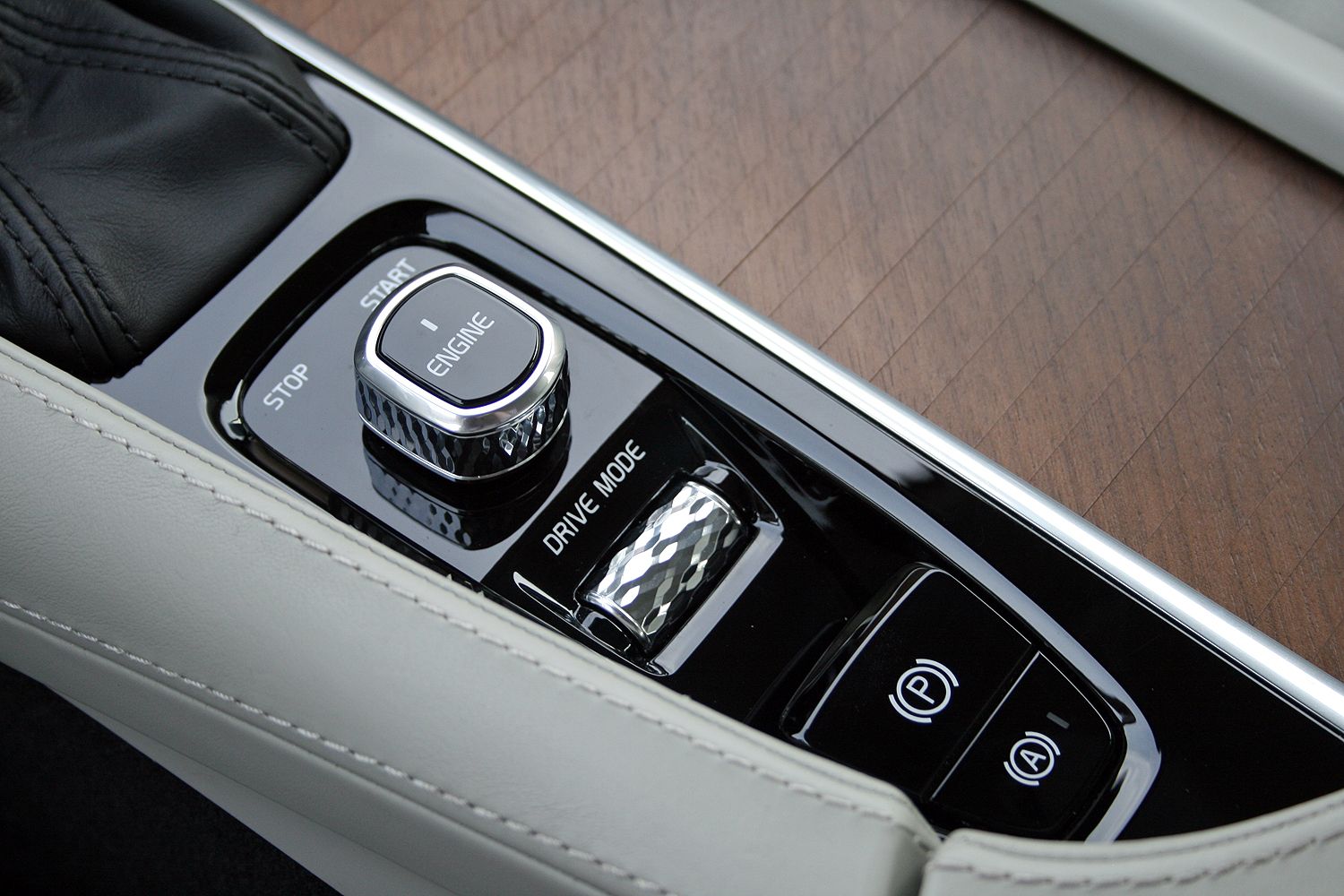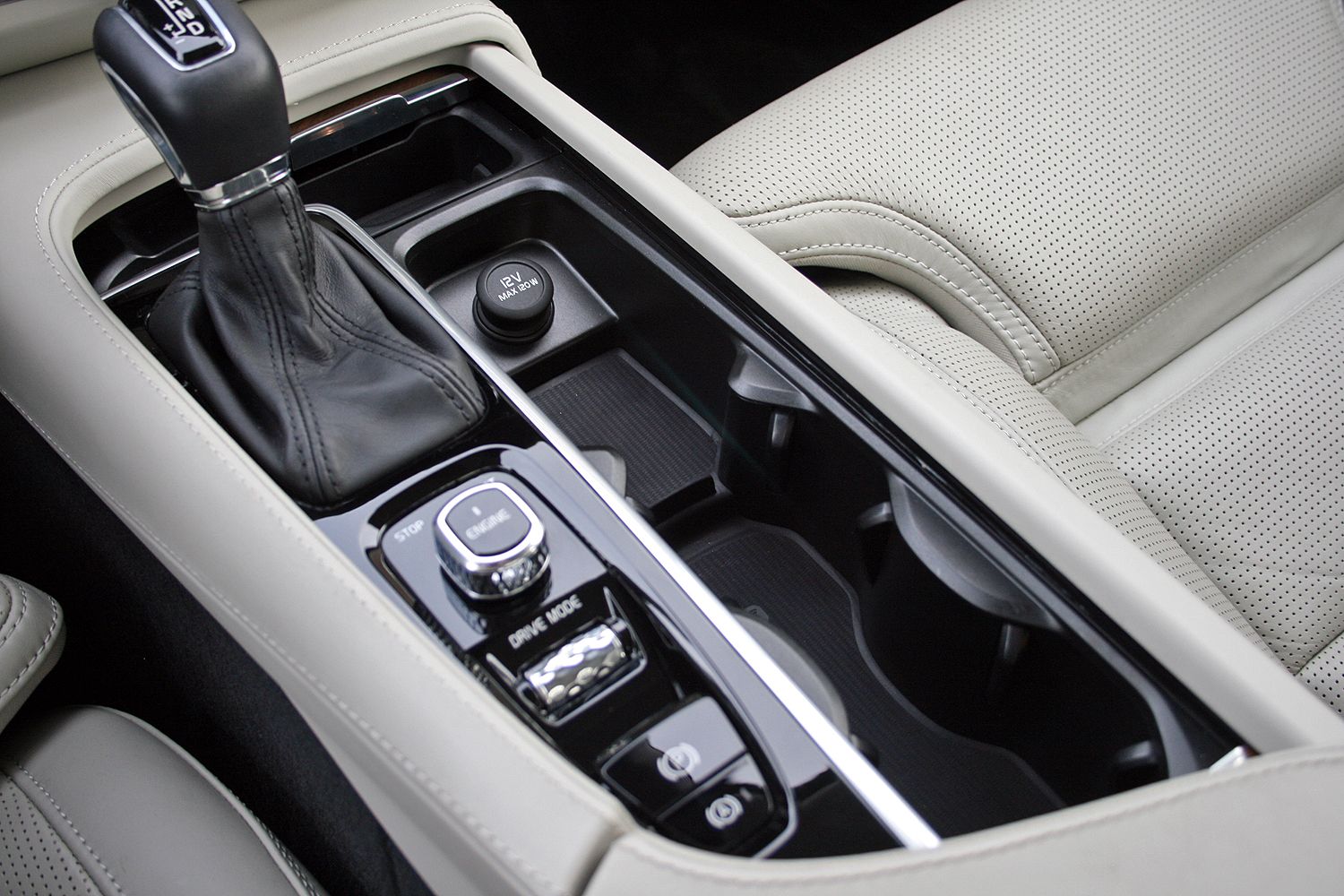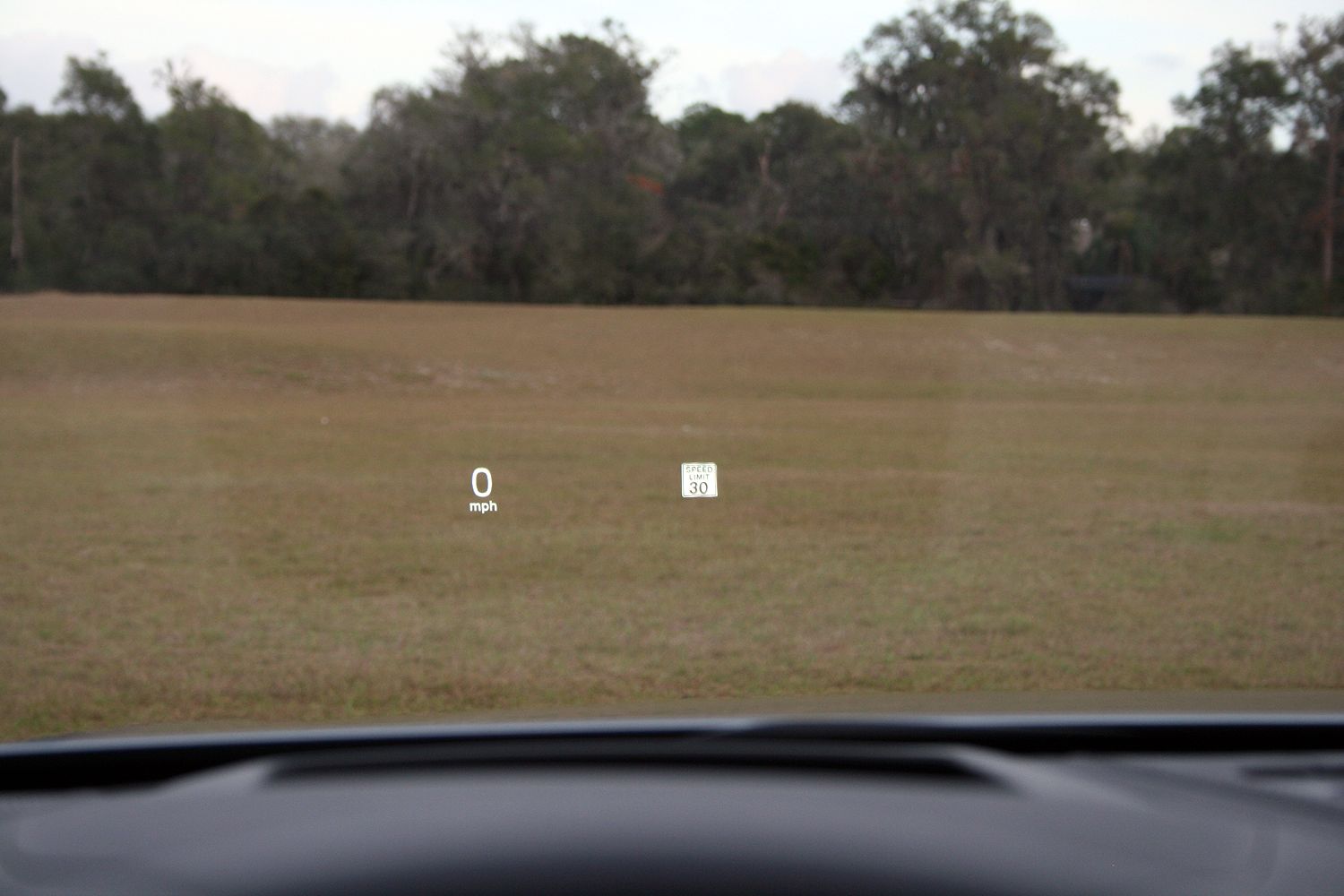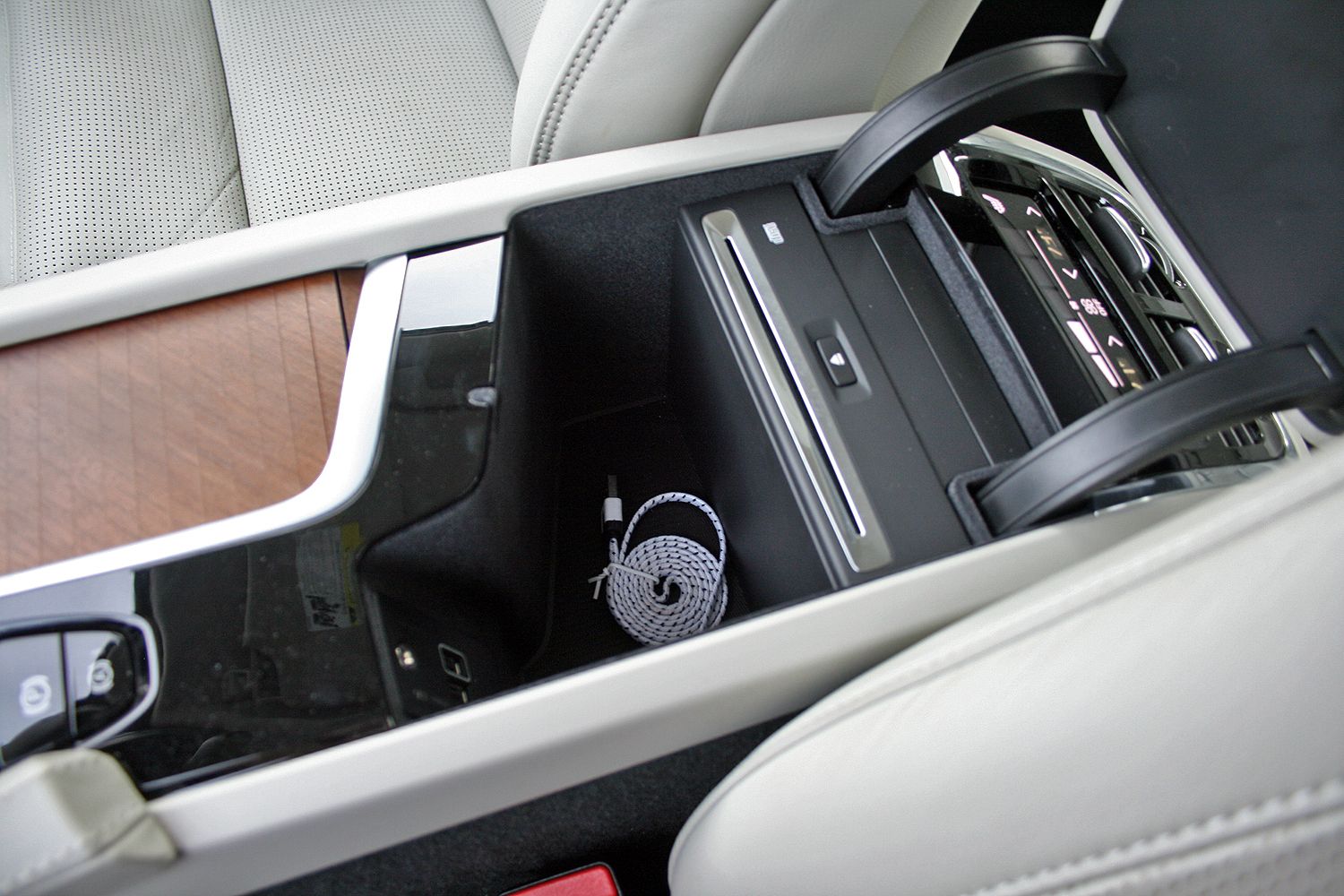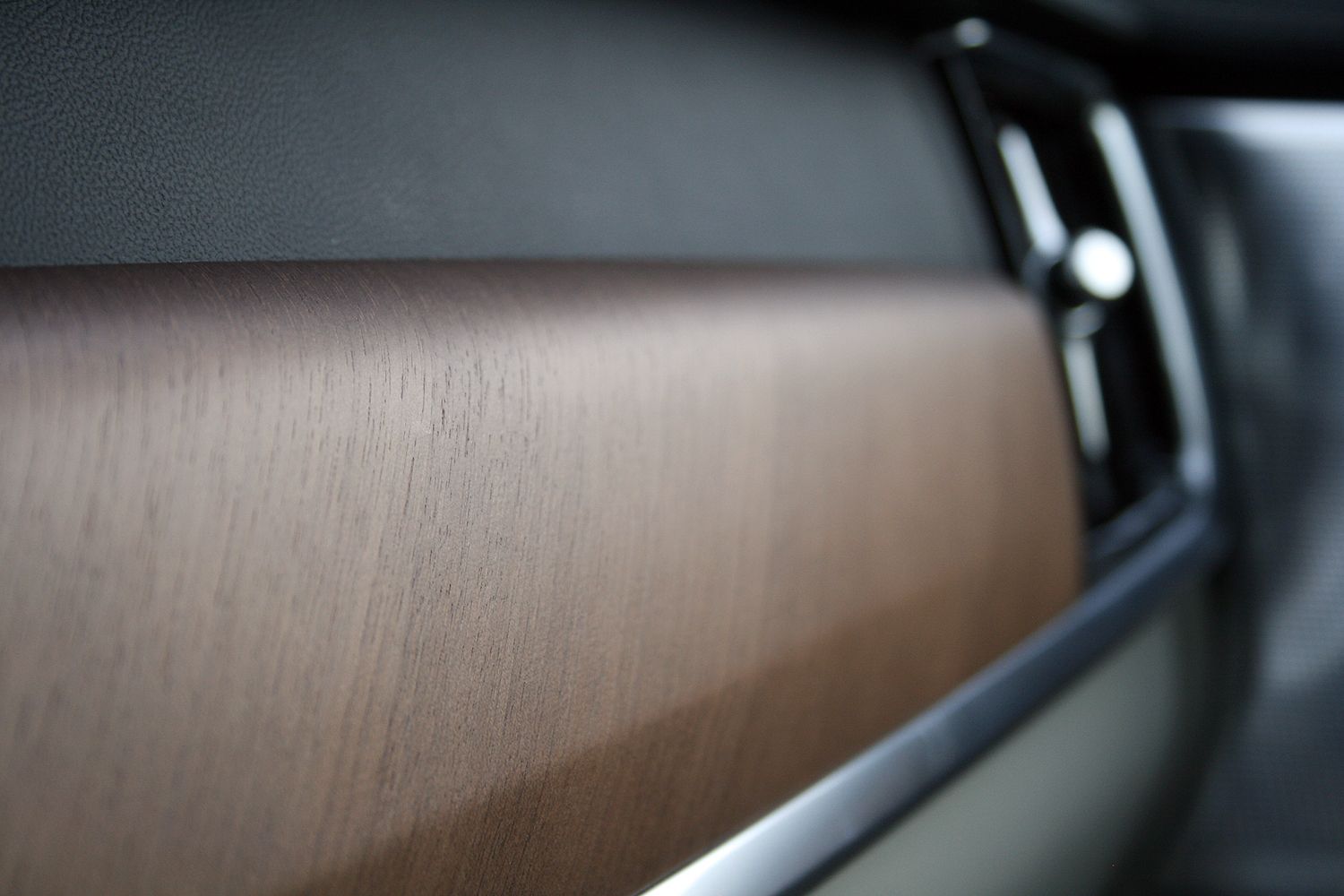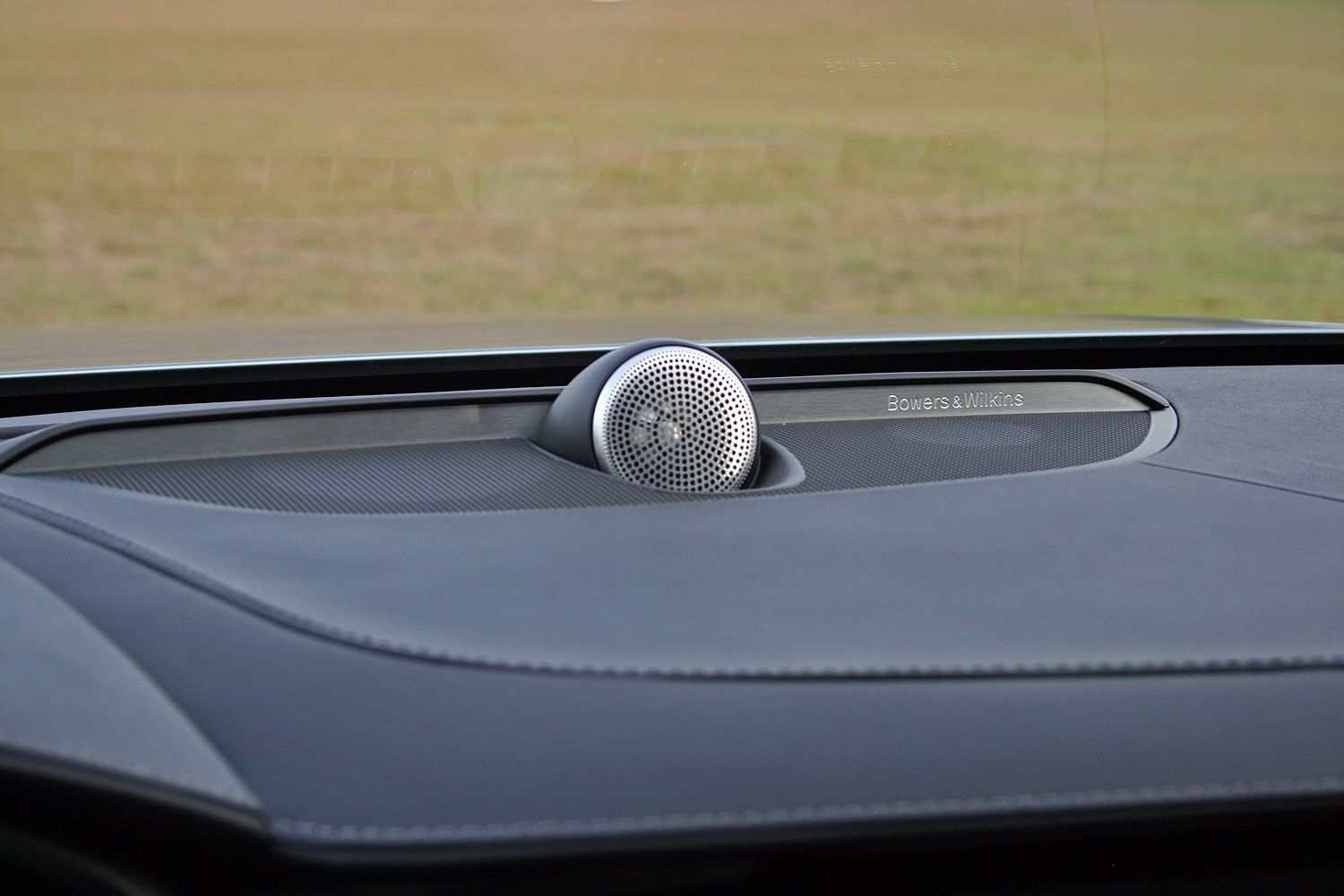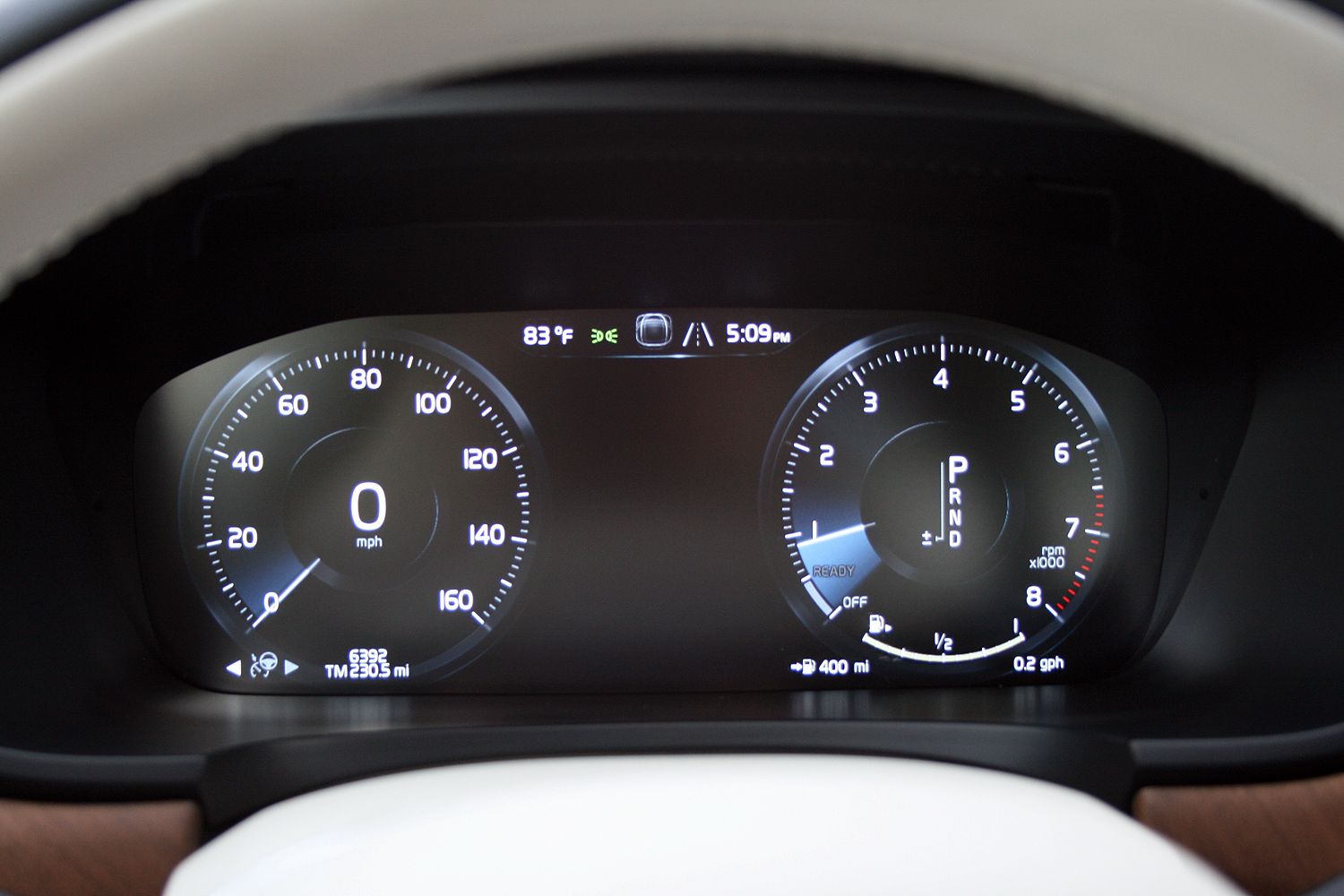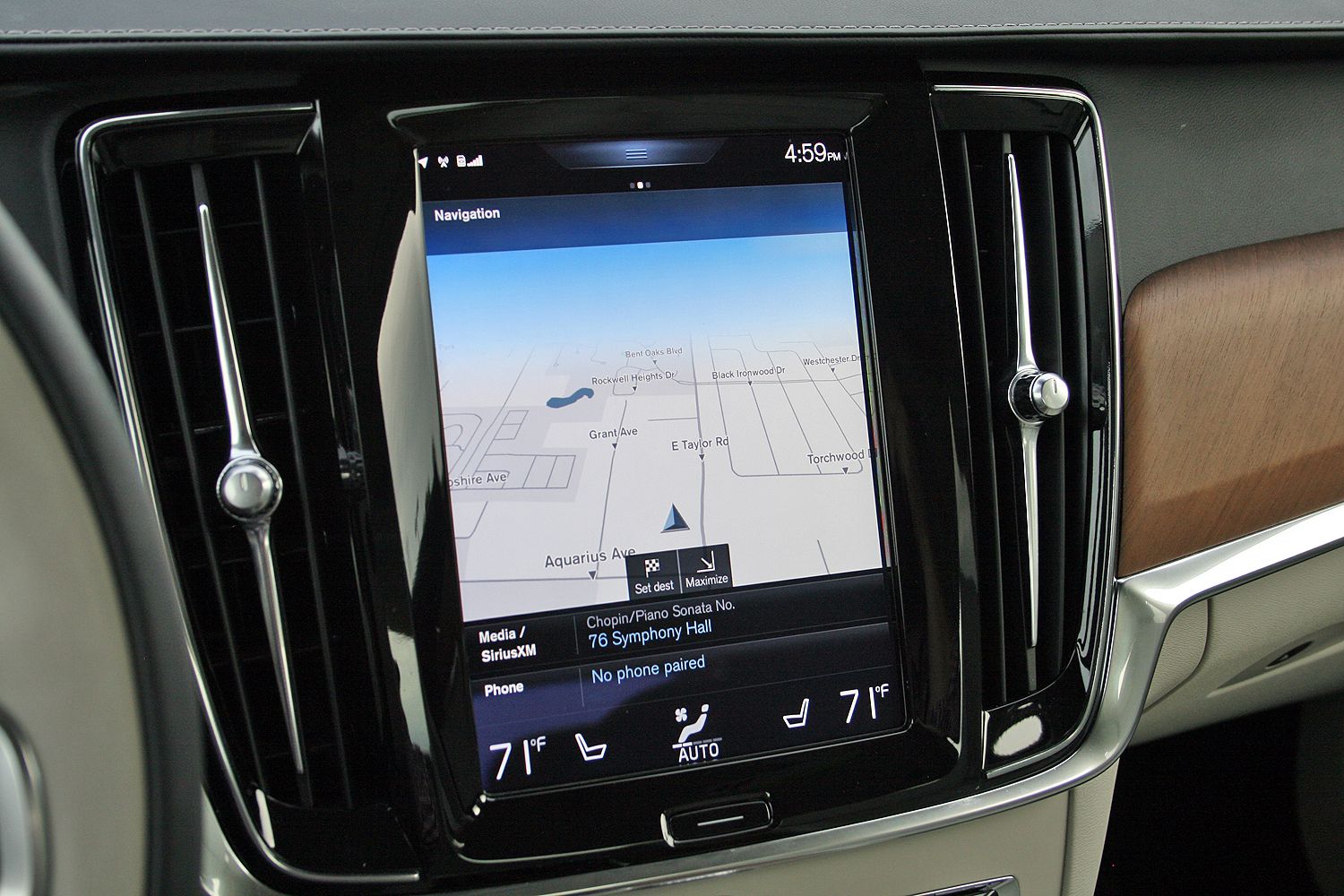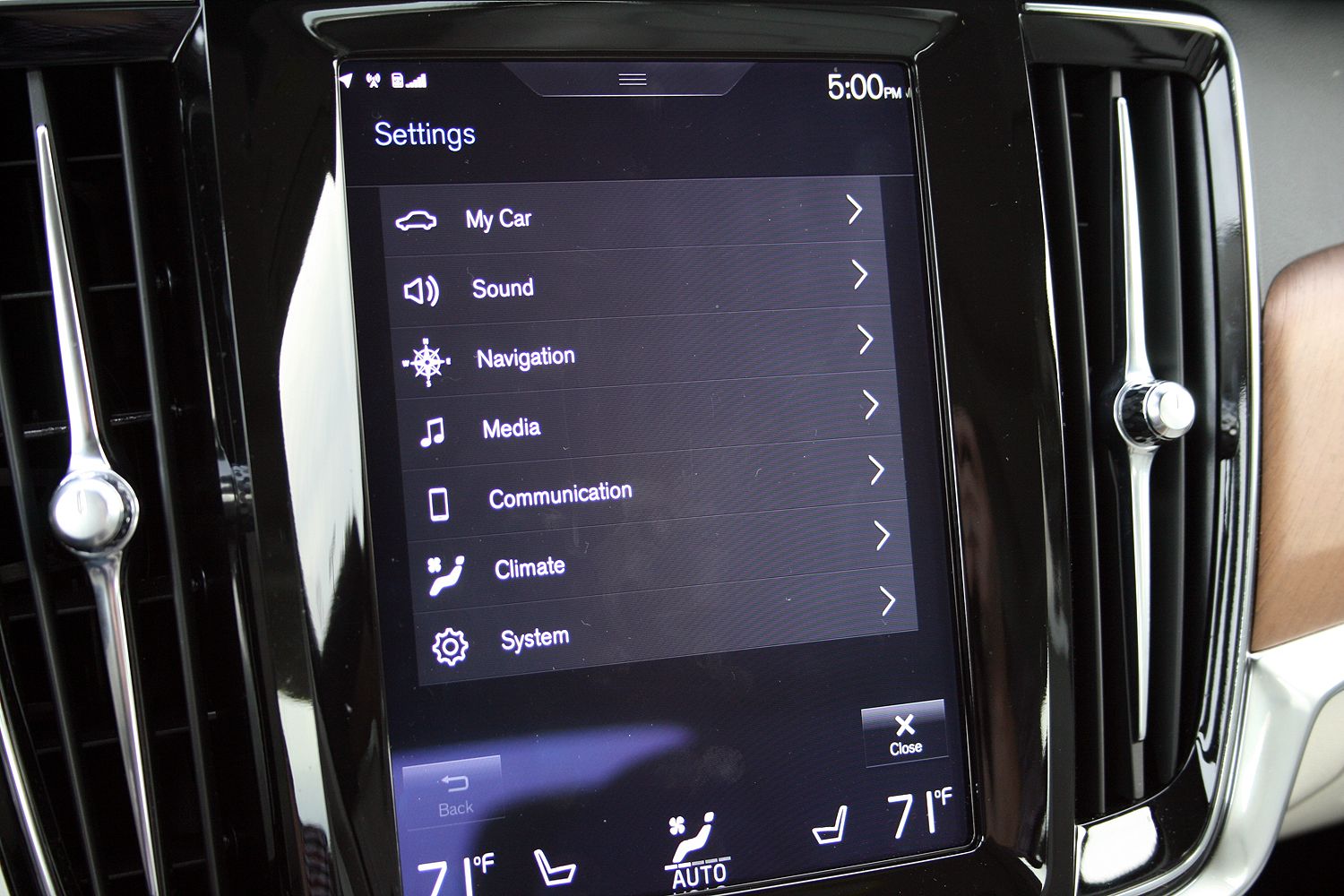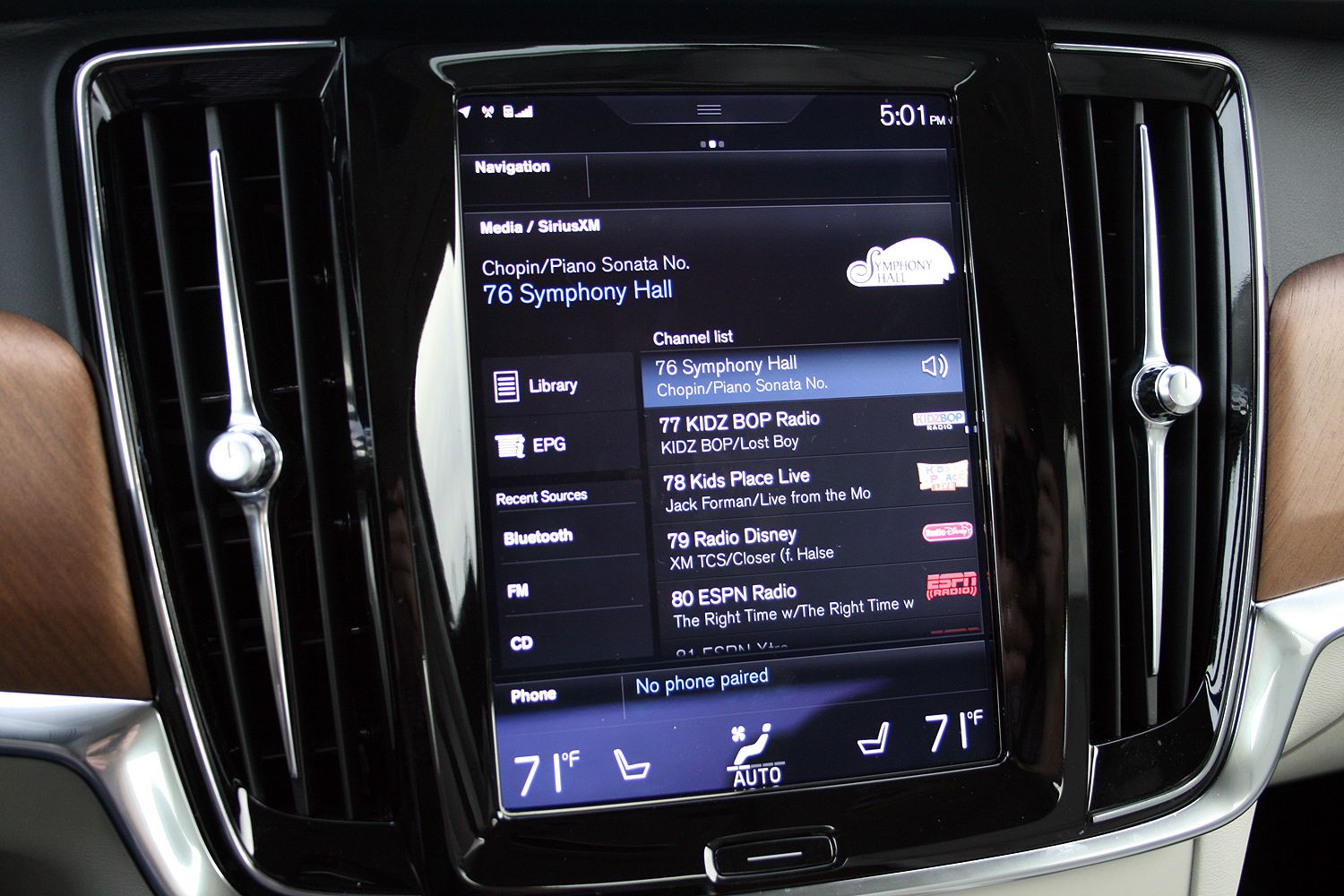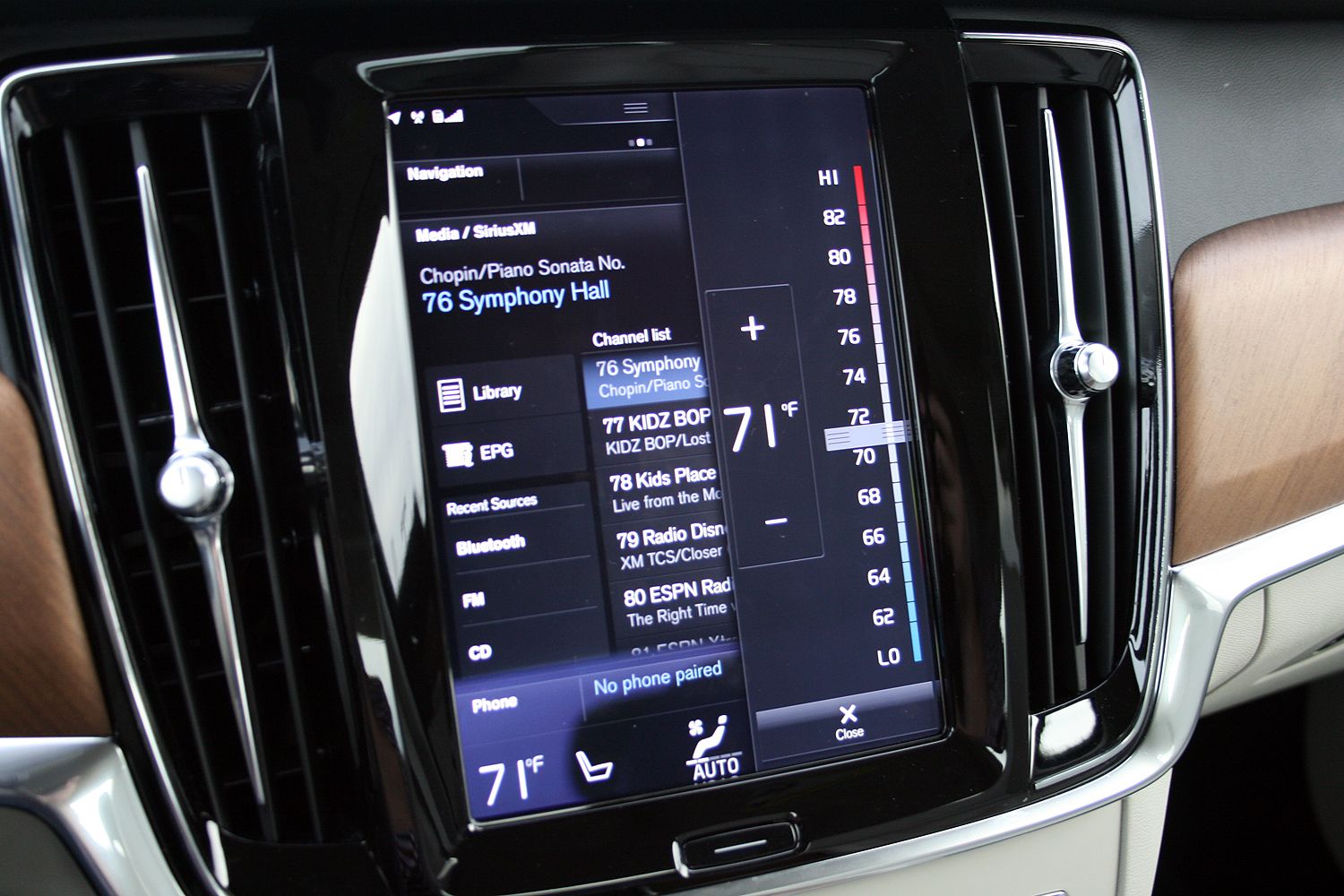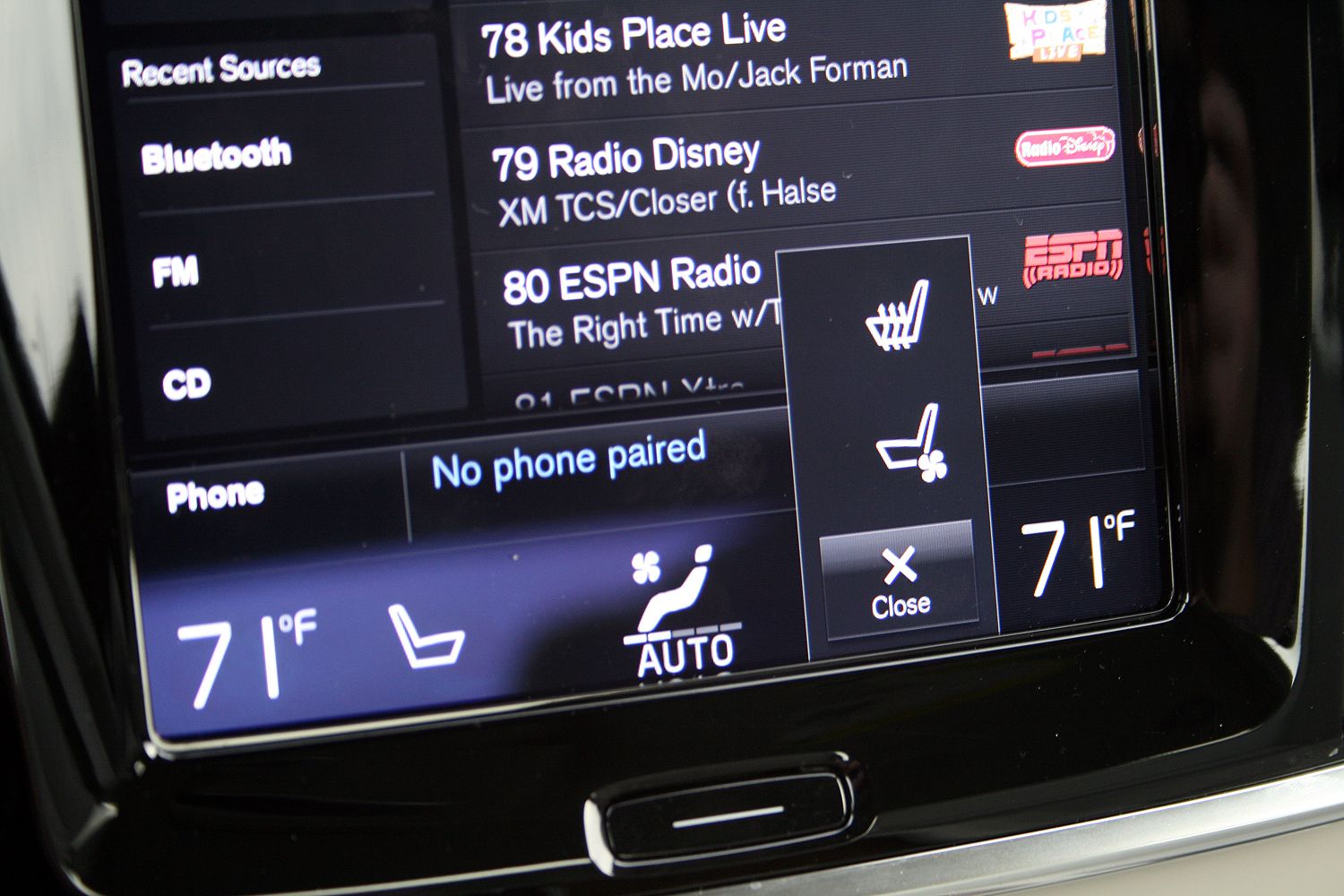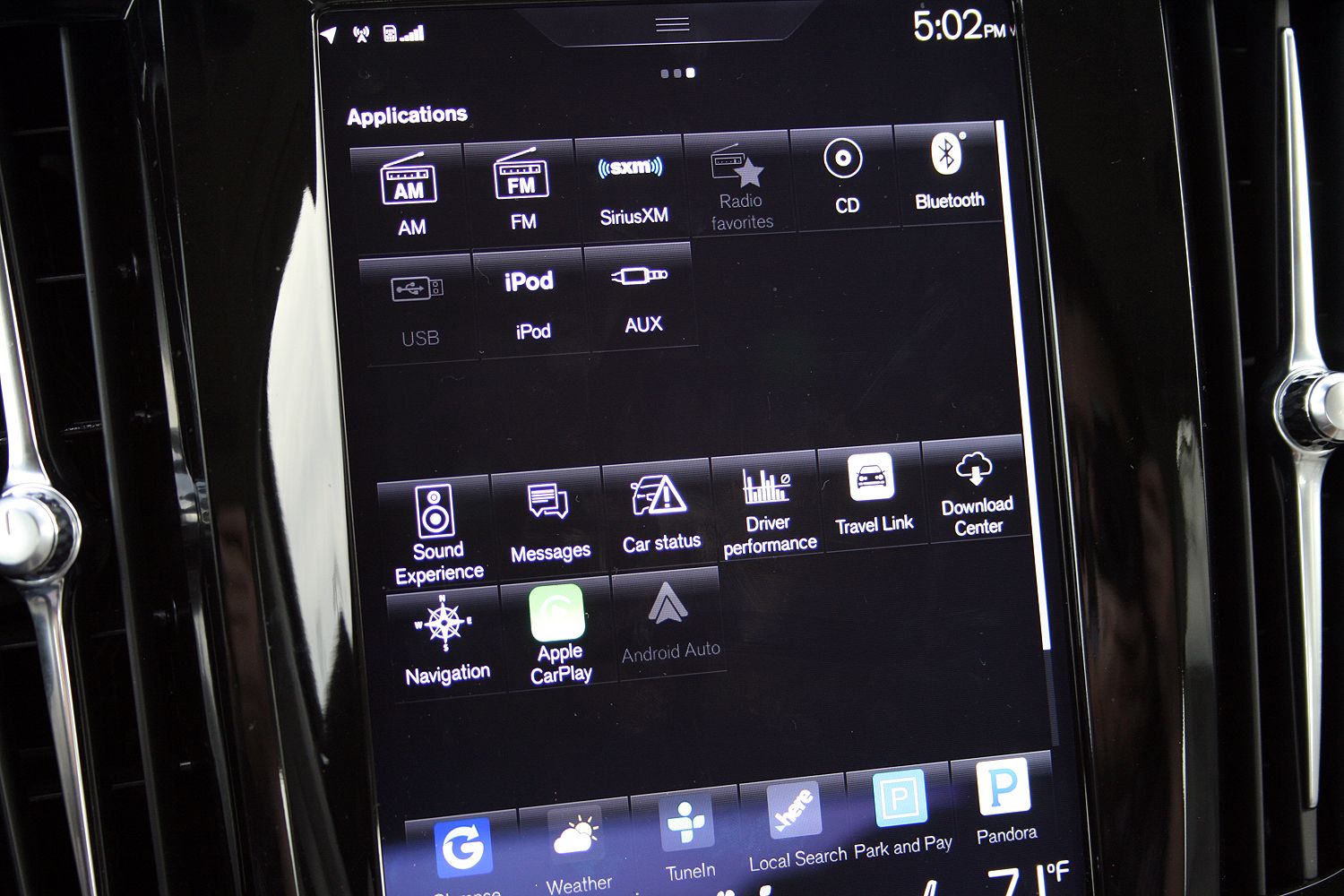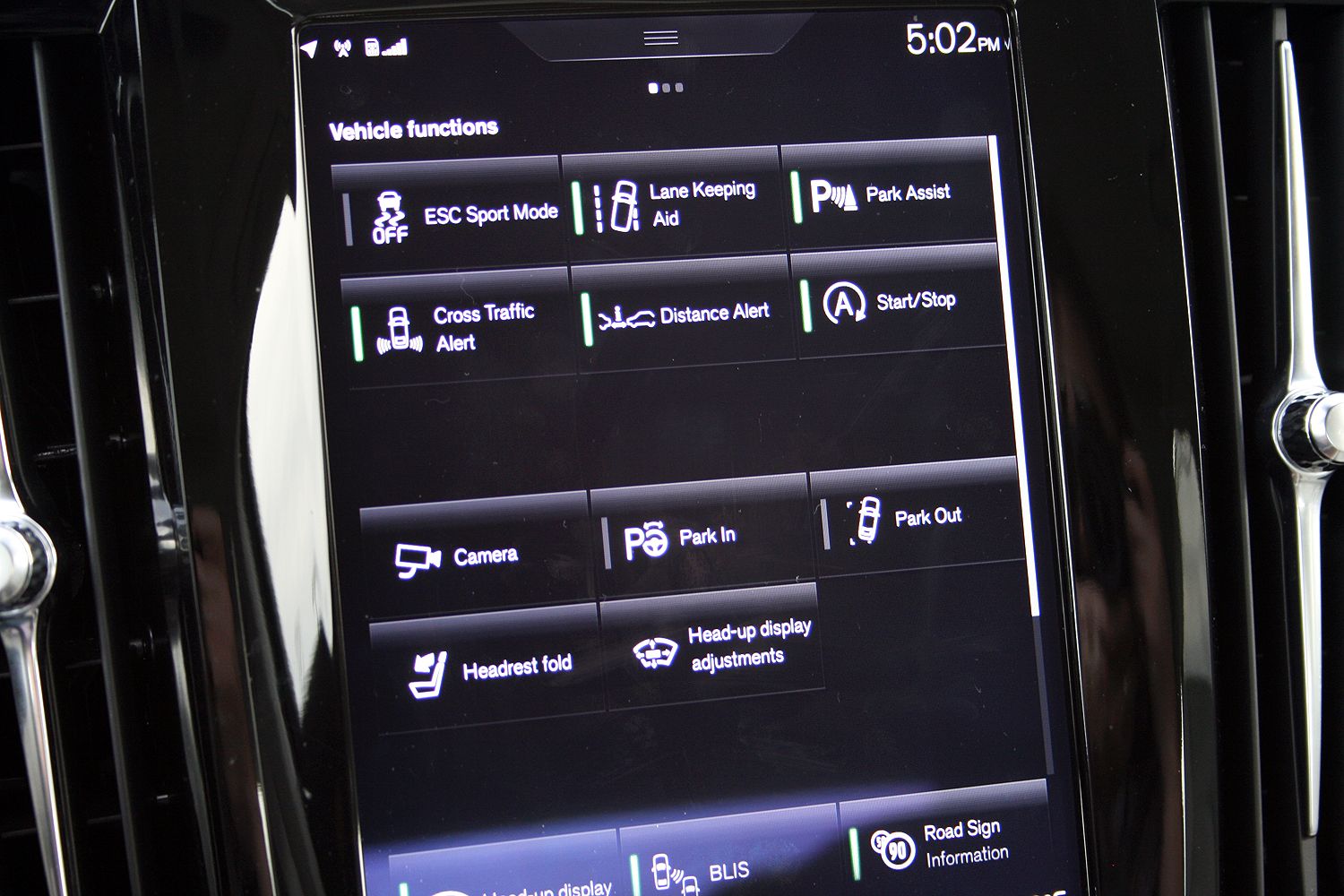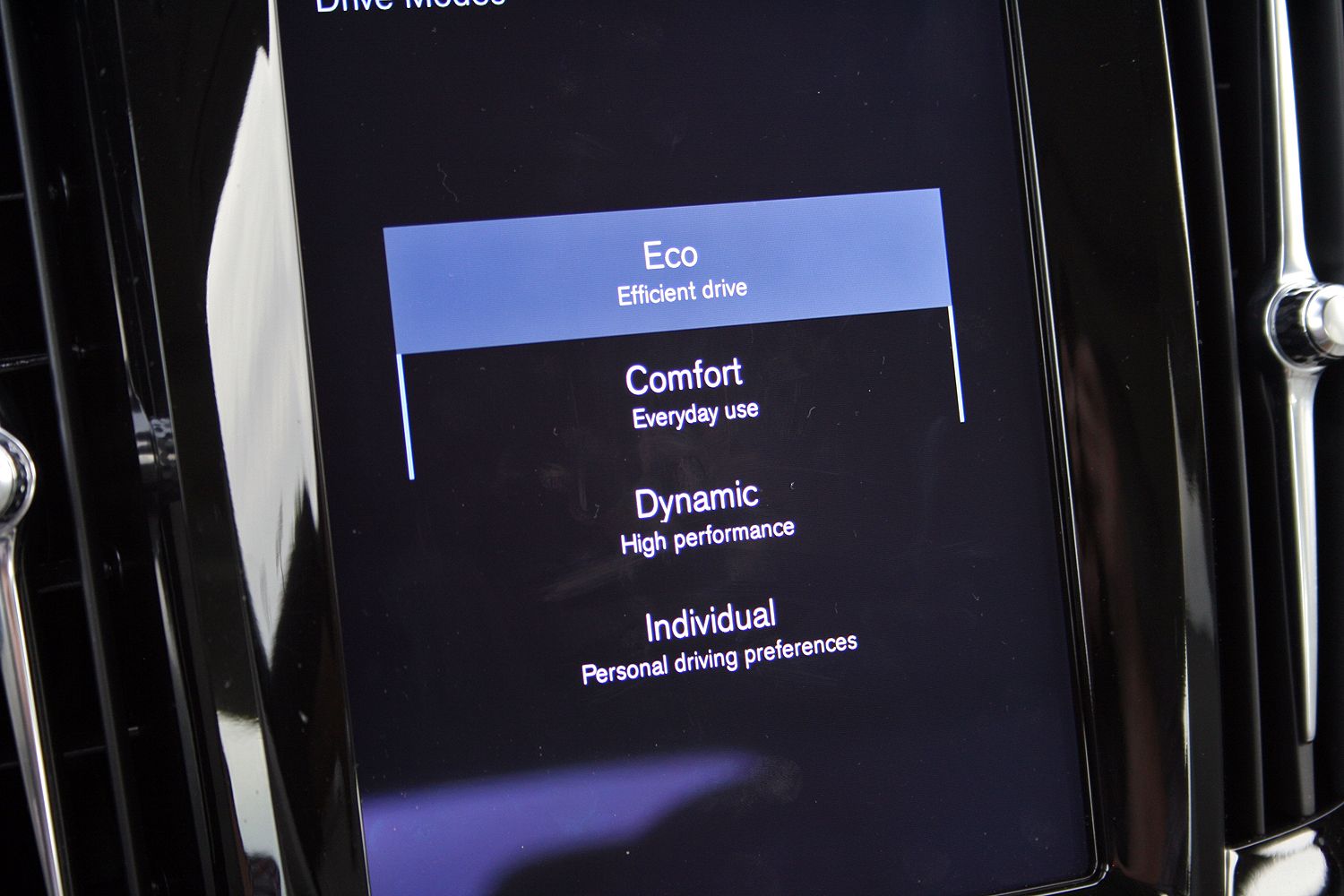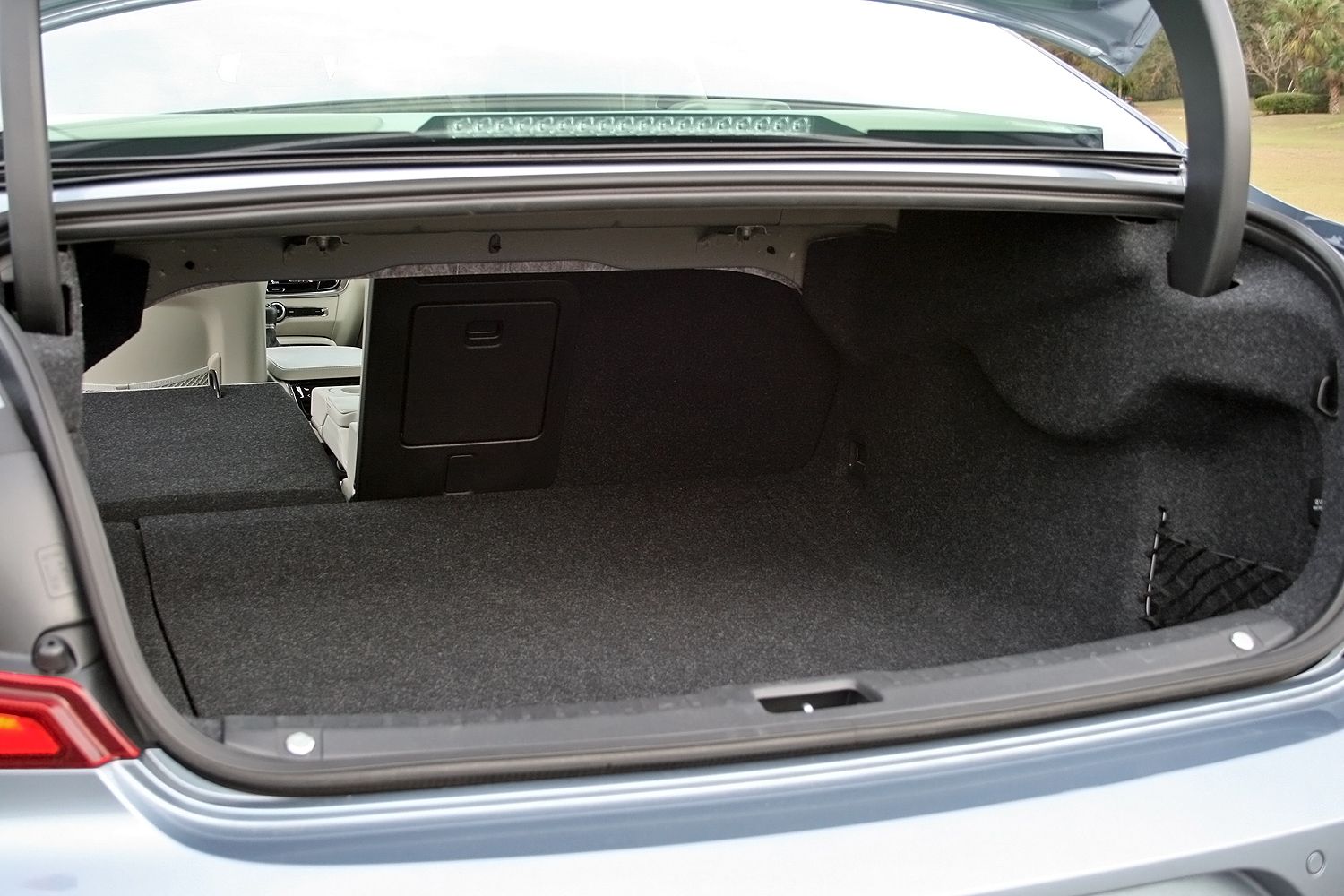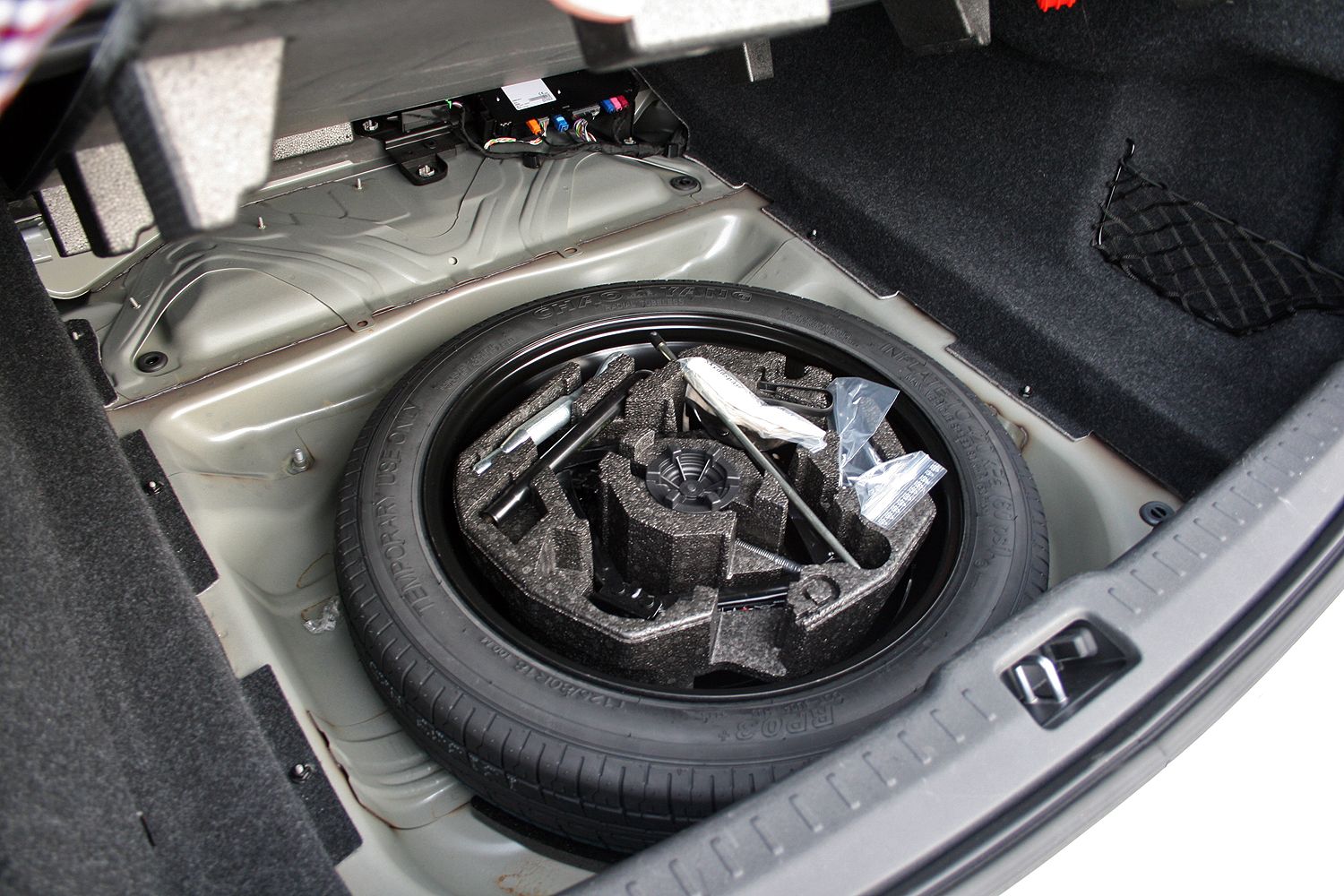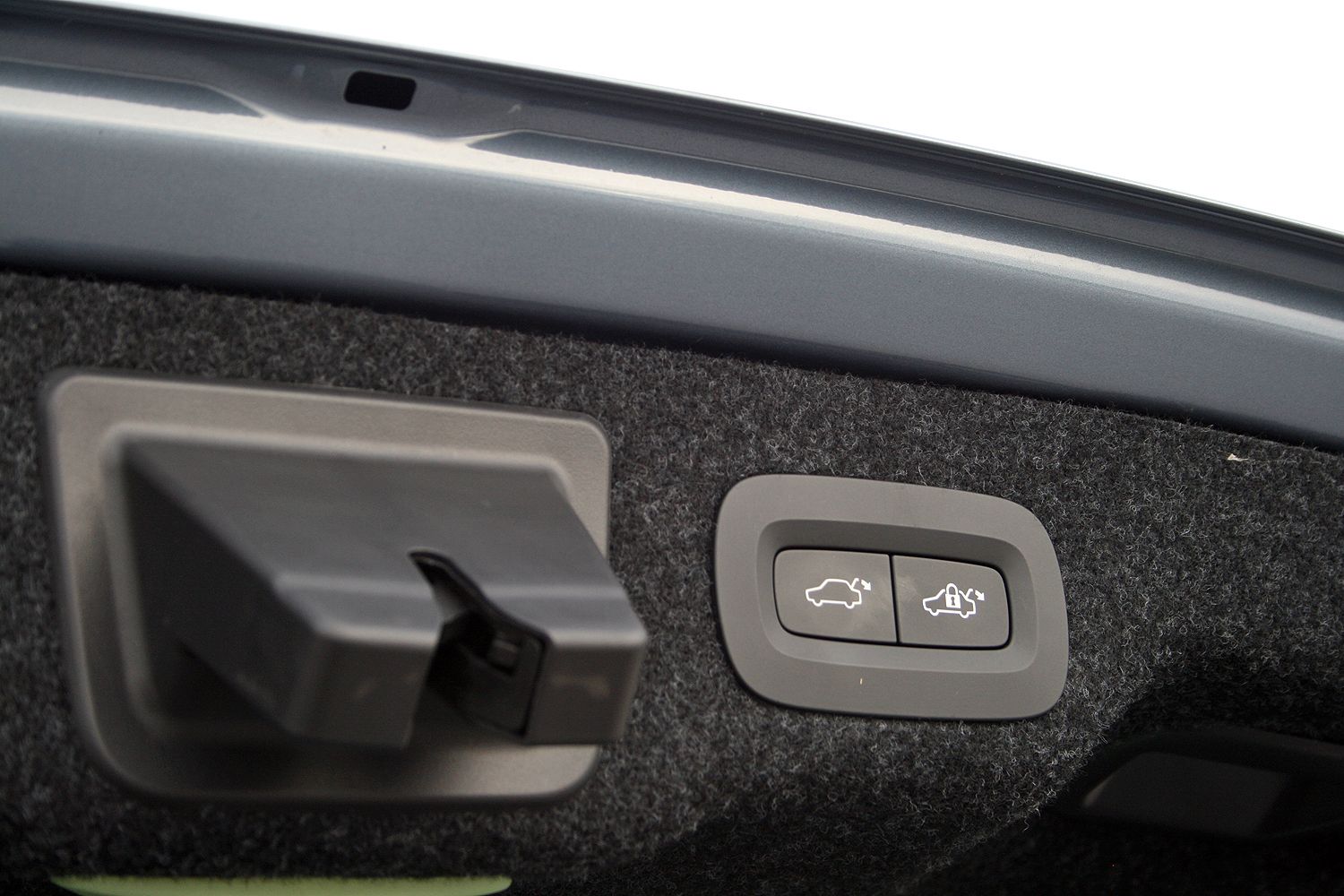Volvo has been around for 90 years and made some pretty impressive vehicles. I’d dare to say the S90 Inscription has eclipsed them all. Let me back up. Volvo’s new quest for dominance in the luxury segment has yielded two very impressive results – the second-generation XC90 SUV that debuted for the 2015 model year and the new-for-2017 S90 sedan. They both share a number on components, from the T5 and T6 four-cylinder engines to the chassis architecture. Best of all, they both share a similar design style that exudes a sense of reserved affluence.
I recently spent a week with the 2017 Volvo S90 fitted with the range-topping Inscription package and several high-end options. Though the S90 carries a base price in the mid $40,000 range, my tester felt like it cost double that, though somehow it didn’t. A rich interior is key in this positive deception, with padded leather, open pour wood accents, and aluminum trim pieces covering every inch of touchable space inside the cabin. What little plastic remains is high-quality and coated in a piano black finish.
Technology also abounds in this machine. An impressive infotainment system and digital gauge cluster further perpetuate the feeling of luxury and its merger with technology. The T6 powertrain is a marvel of modern internal-combustion engine design. And of course, a slew of active and passive safety systems continue proving Volvo remains a leader in vehicle safety.
So what’s it like to live with the S90? Keep reading for the full details.
Continue reading for the full driven review.
2017 Volvo S90 Inscription – Driven
- Make: Array
- Model: 2017 Volvo S90 Inscription – Driven
- Engine/Motor: inline-4
- Horsepower: 316 @ 5700
- Torque: 295 @ 2200
- Transmission: Eight-speed automatic
- [do not use] Vehicle Model: Array
Video Review
Exterior
Elegance – that’s what the 2017 Volvo S90 drips from every smoothly rolled crease in its Mussel Blue Metallic-covered body. It’s the type of elegance that is rarely seen these days. Where the competition uses bold designs with flamboyant grilles and overstated features, the S90 takes a more tasteful approach. Rest assured that each crease and line serves a visual purpose and that nothing is present to call attention to itself. Even the bits that are designed to impress, like the Thor’s Hammer headlights and well-placed chrome brightwork, all blend perfectly into the S90’s overall appearance. The design works as a whole, acting as a cohesive thought – like a well-written thesis on reserved refinement and modern art.
Up front, the Volvo grille is concave in its shape, allowing the Volvo badge a place of prominence. The flanking headlights use LED lighting elements with that distinctive “hammer” shape defining the daytime running lights. The lower LED lights act both as fog lights and cornering lights positioned to illuminate beyond the sideways reach of the Active Bending headlights that turn to match the steering angle.
Volvo’s quest for safety is spotted by the parking sensors, font camera, and windshield-mounted road monitoring systems, which give the S90 the ability to hold its lane, keep its distance from the vehicle in front, and automatically stop itself should a crash be imminent.
Thanks to the optional Inscription package, my tester rolls on the eight-spoke, 20-inch alloy wheels finished in a bright satin chrome. These wheels are actually optional, but only available to Inscription-equipped models. They come wrapped in 255/35-series Pirelli tires.
And just when you think you’ve got an appreciation for the S90’s aesthetics, a long stare at its side profile reveals even more intentionally understated and reserved beauty. The long hood sits nearly flat against the horizon, as does the strong shoulder line that runs between the side windows and door handles. The rearward-set cabin doesn’t fall victim to the coupe-sedan craze, but rather uses a modestly curved roofline that ensured adequate headroom for all aboard.
Out back, the S90 proves understated beauty doesn’t have to be uniform. The taillights and trunk lid are like nothing else on the road, giving this executive sedan a bespoke appearance, especially at night. The rear bumper houses twin, chrome-tipped exhaust ports that begin hinting at what lurks under that long, low-hung hood.
The S90 is probably one of the most understated of its luxury sedan brethren, but it is all the better for it. If you want sporty luxury, the Mercedes-AMG E43 and Cadillac CTS-V have you covered. If you’re wanting transportation that looks more East Hampton than Monticello Motor Club, the S90 is a properly smart choice.
The Competition
Two of the biggest competitors in this segment are the Mercedes-Benz E-Class and the Cadillac CTS. These two offer copious amounts of luxury, sport, and efficiency (when optioned correctly) – all wrapped in attractive packages.
The Mercedes E-Class, like the Volvo, is aimed more at luxury than sport – at least when not in AMG form. The Benz has a large chrome grille and LED encrusted headlights that perpetuate the E-Class’ status as a high-class luxury sedan. The feel continues further back, with sculpted yet muted bodylines forming an almost rounded shape from headlight to taillight. A tall greenhouse ensures interior headroom is plentiful, while keeping the E-Class’ traditional sedan shape. Those who want a coupe can opt for the CLS-Class. The styling out back is equally rich yet diminutive, with few traces of ostentatiousness or tacky add-ons.
The Cadillac, on the other hand, is a bit more flamboyant with its large grille, angular styling, and chrome trim scattered about. It’s not overly ostentatious, but it does have a more youthful vibe than the Volvo or Mercedes. The 2017 model year brings a slightly revised styling for the front and rear, along with some changes in the trim levels. Styling wise, the Caddy’s grille has chrome bars and a big Cadillac Crest placed front and center. Its low-slung hood is pulled down over the front wheels, giving it a forward-leaning appearance. LED daytime running lights continue the modern theme seen around the car. Out back, new vertical tailpipes replace the horizontal ones and a new lower valance resides between them.
|
Mercedes E-Class |
Cadillac CTS |
Volvo S90 |
|
|
Wheelbase (Inches) |
115.7 |
114.6 |
115.8 |
|
Overall length (Inches) |
193.8 |
195.5 |
195.4 |
|
Overall height (Inches) |
57.8 |
57.2 |
56.8 |
|
Overall width (Inches) |
73.7 |
72.2 |
79.5 |
|
Track front/rear (Inches) |
63.6/63.7 |
61.4/61.7 |
64.09/64.13 |
Interior
Like the outside, the interior of this Volvo is pure class – luxury wrapped in leather and accented with open-pore Walnut, satin chrome aluminum, and piano black trim work. Elegance prevails again, and the S90 is all the better for it. Volvo first displayed it aptitude for interior decorating with the new-for-2016 XC90. In fact, the S90 and XC90 share a similar theme and many of the same pieces. Volvo is hardly a parts-bin automaker, but the seminaries are unmistakable. Of course, this is hardly a negative, as both the SUV and sedan offer a premium interior not unbecoming of old money wealth.
Fit and finish are impeccable. Most everything expected to be regularly touched is given a high-class feel. What little plastics are scattered about are thick, high-quality pieces given that piano black finish. These plastics include the infotainment system surround, the steering wheel controls, and the area just aft of the gearshifter. That latter piece encompasses the engine start/stop rotary knob, the drive mode selector, and the electronic parking brake controls. The satin chrome pieces seen covering the start/stop button and drive mode wheel are actually satin chrome. They even feature a scalloped finish that provides grip for gloved finders.
The driver will happily take his gloves off as the three-level heated steering wheel warms up. Grab it tight on the highest setting, and your passengers will be taking bets on how long you can stand the heat. It’s a lovely feeling, honestly. The same can be said for the three-position heated seats in all seating positions, save for the rear middle. Winter is no match for the S90’s warmth.
Besides the wonderful seat heaters, the S90’s Nappa leather-covered seats offer nearly infinite power adjustments. The bottom cushion near the knees sides fore and aft, the side bolsters suck in and out, the lumbar support moves up and down and in and out, and the seat height is operated independently of the other seat adjustments.
Even without power adjustments, the rear seats offer exceptional comfort thanks to their thick padding, reclined backrest, and deep seat bottom. Padded arm rests, dual zone climate control, seat heaters, and window shades offer further comforts. That dual-zone system is controlled by the rear-mounted control panel on the back of the center console.
As for other controls, I couldn’t review the Volvo S90 without talking about its Sensus infotainment system with its iPad-like nine-inch screen. Nearly all vehicle controls, save for the main driving controls, are hosed in this system. An Apple-like light touch is all that’s required to operate the screen, which also responds to Apple-style multi-gesture commands.
While I normally don’t approve of HVAC controls being located within an infotainment system, Volvo did an amazing job at intuitively integrating the temperature, fan speed, and seat controls into the lower portion of the screen. The buttons are always present and offer quick access without fuss. The heated and vented seats have three positions, as does the heated steering wheel, for a wide range of temperature settings.
Other settings are just a swipe away. Three main pages are present, and just like your iPhone, you swipe left and right to reach each one. The middle page is home, while the left page is vehicle settings and the right page is entertainment settings and applications. The menu functions are graphically interesting and logically positioned for ease-of-use. Folks with knowledge of running Apple’s iOS software will have no problem navigating the Sensus infotainment system. It’s just that intuitive. What’s more, a built-in owners manual allows for quick searching, making it super easy to find solutions to questions.
Handy controls aren’t just limited to the front row. The rear seat passengers have their own HVAC control panel, complete with dual zone climate and an independent fan speed from the front. Both outboard seats have three-position heaters, too. Also includes are four air vents – two on the center console and one on each B-pillar – ensuring the comfort of those being chauffeured. Manual sunshades further protect rear occupants from the sun or prying paparazzi.
Besides those features, the rear seats offer plenty of room and comfort, even for taller passengers. Legroom is tremendous for this size sedan and every surface is covered in padded leather. The seats are fixed at a nice reclined angle, and the center folding armrest provides storage, cup holders, and obviously support for the in-board elbows. It also reveals a trunk pass-through for those needing to haul longer items.
Speaking of the trunk, the Volvo S90 offers a competitive 13.5 cubic-feet of space. The decklid’s hinges are hidden behind the trunk liner walls. A compact spare tire resides under the floor. Netted compartments on the trunk sidewalls are perfect for storing smaller items you don’t want rolling around. There’s also a 12-volt power port for whatever you might need to power. One feature I really loved were the buttons to close the power-operated trunk. One button simply closes the trunk, but the other closes the trunk and locks the doors in one motion. No more trying to place a finger on the door handle while carrying two fistfulls of grocery bags. Smart.
All told, the interior of the Volvo S90 is a wonderful place to spend time that ushers in a feeling of reserved opulence coated in character. Volvo has truly stepped up its game with the XC90 and S90.
The Competition
Mercedes has brought the S-Class’ interior into the E-Class. The new interior is far more elegant than before, and carries a swoopy design that feels far more expensive than the window sticker might suggest. Two large screens give the driver information, with the first being a configurable gauge cluster and the second holding the infotainment system. The combination of the two and their seamless continuity really pushes the E-Class onto the next level. Mercedes gives its customers plenty of choices when it comes to leather color, trim materials, and other features.
Rear seat accommodations are spacious and well appointed, though the S-Class’ accoutrements don’t carry over to the standard-wheelbase E-Class. Nevertheless, the rear bench seat is plenty comfortable to spend time while being chauffeured from the hotel to country club.
In keeping with its sporty exterior, the Cadillac CTS’ interior is a bit more on the avant-garde end of the spectrum. The cockpit is focused around the center stack and CUE infotainment system. The CTS also gets a digital gauge cluster that’s configurable to show different information. Combined with the infotainment system, the pair of screens offers the driver a detailed view of vehicle status, navigation information, and ancillary items like radio and climate settings. A wide range of colors and materials are available, along with different trim options. Rear seat room is average for this class. Like the Volvo, the CTS has separate controls for the rear HVAC system.
|
Mercedes E-Class |
Cadillac CTS |
Volvo S90 |
|||
|
Mercedes E-Class |
Cadillac CTS |
Volvo S90 |
37.4/38.2 |
39.2/37.5 |
38.7/37.8 |
|
Headroom front/rear (Inches) |
41.7/36.2 |
42.6/35.4 |
42.2/35.9 |
||
|
Legroom front/rear (Inches) |
57.8/57.1 |
56.9/54.8 |
57.5/55.9 |
||
|
Shoulder room front/rear (Inches) |
13.1 |
13.7 |
13.5 |
||
|
Trunk capacity |
98.0 |
97.0 |
Drivetrain
The Volvo S90 comes standard with the T5 2.0-liter turbocharged four-cylinder engine. This all-aluminum engine makes a respectable 250 horsepower and 258 pound-feet of torque that is sent to the front wheels. My tester, however, came with the T6 engine – a version of the T5 that uses both a turbocharger and a supercharger to generate boost. Yes, the T6 is both turbocharged and supercharged. The result is 316 horsepower and 295 pound-feet of torque, while still achieving an impressive 22 mpg city, 31 mpg highway, and 25 mpg combined. Admittedly, the extra power combined with the AWD system, do drop the EPA-estimates for fuel economy from the T5’s 23 mpg city and 34 mpg highway rating.
The T6 marries the two forced-induction devices together in an interestingly simple way. See, superchargers work better at low- and mid-range engine speed, while turbochargers love higher revs. Volvo uses both to force-feed the 2.0-liter engine throughout its rev range. To do this, the supercharger uses an electromagnetic coupler that disengages the supercharger’s internal screws from the input shaft driven by the engine’s accessory belt. This happens at 3,500 rpm, and at which time, the turbocharger is spooled up and generating boost that carries the engine to its 6,500-rpm redline. The transition of boost happens seamlessly and is imperceptible, even when trying to sense it.
The T6 also uses a slew of other technology, including an all-aluminum construction to cut down on weight, direct fuel injection for performance, and a start/stop system to save fuel when temporarily stopped.
The T6 comes mated to Volvo’s Geartronic eight-speed automatic transmission. It offers manual control via the gear shifter and is silky smooth in its operation, regardless of driving style. Shifts do come more quickly when in the driver selects Dynamic mode. The transmission and engine are mounted transversely between the S90’s front wheels. Thanks to the AWD system, power is sent rearward when needed. Like most good AWD systems, it uses sensors to monitor wheel speed and slip. Should a tire loose traction, the AWD system diverts power away from it and to those with grip, helping reduce the likelihood of a skid.
|
Engine |
In-line 4-Cylinder Turbocharged & Supercharged Engine |
|
Drivetrain |
All-Wheel-Drive |
|
Horsepower |
316 HP @ 5,700 RPM |
|
Torque |
295 Lb-FT @ 2,200-5,400 RPM |
|
Fuel economy city/highway |
22/31 |
|
Transmission |
Eight-speed Geartronic™ automatic |
|
Curb weight |
4,222 Lbs |
|
0 to 60 mph |
5.6 seconds |
|
Top Speed |
133 mph |
The Competition
The 2017 Mercedes-Benz E-Class is only available with one engine inside the U.S. – the 2.0-liter turbocharged four-cylinder. It makes 241 horsepower and 273 pound-feet of torque. The engine features direct fuel injection, a multi-park ignition system, and variable valve timing on its 16 overhead valves. A three-phase cooling system helps keep temperatures in check, while reducing strain on the engine when temperatures are below operating levels. Like the Volvo, it has an automatic start/stop system designed to increase fuel economy by turning off the engine at stoplights. The 2.0-liter comes mated to a nine-speed automatic transmission, which powers the rear wheels. A 4Matic version of the E-Class is available and brings a full-time AWD system to the table.
Four different suspension systems are available. They include the standard four-wheel multilink suspension, a lowered suspension with selective damping, a comfort suspension with selective damping, and Mercedes’ Air Body Control, or air suspension, which adjust to fit a variety of driving styles and road conditions.
The EPA rates the E300 at 22 mpg city and 30 mpg highway. The E300 4Matic only loses one mpg on its highway rating.
The Cadillac CTS is available with three engines, including the 3.6-liter V-6 and the impressive twin-turbo 3.6-liter V-6. It’s the 2.0-liter turbo four-cylinder that best matches the S90 and E300, however. The turbo four makes 268 horsepower and 295 pound-feet of torque thanks to a variety of technologies that include direct fuel injection, variable valve timing, and that twin-scroll turbocharger. Those keeping track of GM’s parts bin will recognize this engine in the Cadillac ATS and Chevrolet Camaro.
The engine comes mated to an eight-speed automatic transmission. Rear-wheel drive is standard, but AWD can be had. As for suspension systems, the CTS is offered with its standard four-corner independent system with conventional MacPherson struts or with the optional Magnetic Ride Control. The MRC automatically adjusts to road conditions to provide a smooth ride yet a sturdy foundation for cornering.
The 2.0-liter-equipeed CTS is EPA rated at 22 mpg city, 30 mpg highway, and 25 mpg combined. Those with AWD are EPA rated at 21 mpg city, 29 mpg highway, and 24 mpg combined. The 2.0-liter is aided by an automatic start/stop system.
|
Mercedes E300 4Matic |
Cadillac CTS 2.0T |
|
|
Engine |
2.0-liter inline-4 turbo |
2.0-liter turbo four-cylinder |
|
Horsepower |
241 HP @ 5,550 RPM |
268 HP @ 5,600 RPM |
|
Torque |
273 LB-FT @ 1,300-4,000 RPM |
295 LB-FT @ 3,000-4,500 RPM |
|
Transmission |
9G-TRONIC 9-speed |
Hydra-Matic 8L45 paddle-shift eight-speed |
|
Fuel economy city/highway |
22/30 |
21/30 |
|
Curb weight |
3,792 Lbs |
3,652 Lbs |
|
0 to 60 mph |
6.2 seconds |
6.2 seconds |
|
Top Speed |
130 mph |
133 mph |
Safety
Volvo is well known for its quest for safety. The automaker was the first to make three-point seatbelts standard in all its cars, years before governments began mandating them. The 2017 S90 continues that legacy by earning a Top Safety Pick from the Insurance Institute for Highway Safety. The car scored the top rating of “Good” in all crash-related metrics, which include small front overlap, moderate overlap, side impact, roof strength, and head restrains and seats. It also scored the highest rating of “Superior” in front crash prevention thanks to it bevy of active safety systems.
The S90 did fall short in two metrics. The IIHS did find the rear child LATCH points a bit hard to use, and awarded it with an “Acceptable” score. The S90 only scored a “Marginal” in the IIHS’ new headlight evaluation. It was this score that kept the S90 from getting a Top Safety Pick+ award. Still, it’s hard to fault Volvo, as 2017 is the first year for the IIHS’ headlight tests. We expect improvements in the next few years. Those opting for the “base” momentum trim will get worse-performing headlights, as the IIHS rates those as “Poor.”
My personal use of the S90’s Inscription-trim headlights proved nothing short of great. The provided plenty of light in both the low- and high-beam settings; Volvo’s Active Bending Lights system moved the lights in conjunction with the steering wheel; and the fog light did a great job at illuminating both in foggy conditions and dark street corners when used as turn illuminators with the turn signals.
The Competition
The revised 2017 Mercedes E300 has not been tested by the IIHS for its crashworthiness, but the 2016 model earned top marks. In fact, the IIHS rated the 2016 E-Class a Top Safety Pick+. It earned a “Good” rating in every category, including the LATCH system. It scored a “Superior” for its front crash prevention. Its headlights have not been tested.
The Cadillac, too, has not been tested for the 2017 model year. However, its 2015 predecessor didn’t fare so well in testing. Though “Good” ratings were earned in most categories, the CTS’ small-overlap frontal crash rating only ranked a “Marginal” due to intrusion into the driver’s lower foot well. The same score was given for the rear LATCH system. Headlight testing was not conducted in 2015. These two lackluster scores knocked the CTS out of any Top Safety Pick award.
Technology wise, both the Mercedes and Cadillac offer active safety systems. They include adaptive cruise control, lane-keep assist, and automatic emergency braking. Other systems include blind spot monitoring with rear cross-traffic alert and 360-degree camera systems.
|
Mercedes E-Class |
Cadillac CTS |
|
|
Small overlap front |
G |
M |
|
Moderate overlap front |
G |
G |
|
Side |
G |
G |
|
Roof strength |
G |
G |
|
Head restraints & seats |
G |
G |
|
Front crash prevention |
Superior with optional equipment |
Superior with optional equipment |
|
Child Seat Anchors (LATCH) ease of use |
G |
M |
Behind The Wheel
The S90 offers a rather quelled ride that focuses more on comfort. The suspension does a good job at soaking up bumps and ironing out imperfections in the road. The steering offers little feedback from the wheels, but in doing so, is absent of vibration or kickback. The Volvo offers three drive modes and customization mode for remembering the driver’s personal preference. These modes are Eco, Normal, Dynamic, and Individual. Normal and Dynamic are where I spent the majority of my time, with Dynamic mode offering a much more raw experience in terms of available power.
The R&D behind this turbocharged and supercharged 2.0-liter four-cylinder has certainly paid off. The engine surges with a swell of torque as the throttle pushes deeper toward the carpet. The transmission shifts so smoothly and quickly, it almost feels like CVT. This keep an uninterrupted flow of power headed to all four wheels. Wheel spin is nonexistent on dry pavement. The Volvo is simply pushes forward like a surfer picking up fast-moving wave. This feeling of power is diminished a bit in Normal mode, as the throttle loses its twitchiness and the car settles into a more relaxed state.
While power and comfort were impressive, I did have a few misgivings with the S90. First, road noise on older or broken pavement is surprisingly loud. It’s accentuated by the overall quietness of the cabin otherwise. No wind noise, shakes, or other errant sounds float around the leather-line cocoon. Second, the chassis doesn’t feel quite as solid as others in this class. It’s not anything detrimental or overly noticeable, but rather a minute feeling that the body gives a bit more when rolling over bumps or cresting a driveway. Still, it’s hardly a complaint that would stop me from recommending the S90.
And thanks to all the driver aid technologies like Lane Keep Assist and Adaptive Cruise Control, highway stints are rather relaxing. Of course, the S90 isn’t completely autonomous, but these systems do help alleviate some of the driving stress. All told, the experience behind the wheel is a very pleasant one.
Pricing
The 2017 Volvo S90 comes in two trim levels: Momentum and Inscription. The Momentum carries a starting price of $46,950. The Inscription trim, as my tester was, starts at $49,650. So what does the extra $2,700 add to the higher trim level? Plenty. The Inscription package adds LED headlights with the Active Bending feature, in addition to the Thor’s Hammer daytime running lights that are standard on the Momentum trim. A swanky set of 19-inch, 10-spoke alloy wheels are included, as well as the chrome trim along the doors. The 12.3-inch digital gauge cluster and Linear Walnut wood inlay trim work dress up the interior. All told, the Inscription package seems like money very well spent.
Both trim levels can be had with both the T5 and T6 engines. The $46,950 price aligns with the T5-powered Momentum trim, which comes only with FWD. Opting for the turbo and supercharged T6 brings AWD and a starting price of $52,950. As for the Inscription trim, the T5 version starts at the aforementioned $49650, while the T6 starts at $55,450.
My particular tester came with a number of optional extras. These include the Vision Package ($1,950); the Climate Package with HUD ($1,950); the Convenience Package ($1,000); the Bowers & Wikins premium sound system ($2,650); the Metallic paint ($560); and the 20-inch wheels ($750). Add in the $995 destination price, and the grand total comes to $66,105.
While expensive, that’s not terrible when considering what comes included with the S90 and how much its competitors cost.
The Competition
The 2017 Mercedes-Benz E300 starts at $53,075 – a full $6,125 more than the S90. In order to match the luxury levels of my S90 Inscription tester, the E300 would require selecting the Premium 3 Package – a whopping $11,250 fail swoop of all-inclusiveness. This package basically turns the E300 from a regular sedan into a high-tech, self-driving, machine with all the modern bells and whistles available. Nevertheless, this fully optioned E300 carries a price of $64,575. Adding AWD via the E400 4Matic shoots the price to $66,825 – a mere $720 more expensive than my Volvo S90 tester.
The Cadillac CTS enjoys the lowest starting price of the trio, but only by nixing the S90 by a few hundred dollars. Its starting price is $46,555 and includes the 2.0-liter turbo four, CUE system with Apple CarPlay and Android Auto, remote start with keyless access, LED daytime running lights, 17-inch aluminum wheels, wireless phone charging, and a rear view camera.
The CTS offers three trim levels – the base CTS, the Luxury trim, and Premium Luxury. In order to compete with my S90, the Luxury trim would need to be chosen. Unfortunately for this comparison, the Premium Luxury trim, which aligns better with the S90 Inscription and E300 Premium 3 Package, isn’t available with the 2.0-liter turbocharged four-cylinder. As such, the CTS’ price is lower. By selecting the optional AWD, the price ends up being $54,280. If luxury was more important than sticking with the base 2.0-liter engine, the Premium Luxury trim with AWD starts at $61,755 and adds things like the Magnetic Ride Control, head-up display, automatic parking system, power rear sunshades, tri-zone climate controls, and 18-inch wheels.
Other Competitors
2017 Audi A6 2.0T Quattro
Audi has made a name for itself in the luxury segment over the last 20 years – moving away from that quirky rally brand to something more akin to Mercedes and BMW. Volvo seems to be on that same track, moving from prudish wagon with lots of safety equipment to something sexy and desirable. Audi’s A6 is the moderately affordable luxury sedan that best lines up with the Volvo S90, Mercedes E-Class, and Cadillac CTS.
Specifically, it’s the A6 equipped with the standard 2.0-liter turbo four and quattro AWD system that best competes with the others in this review. The engine makes a respectable yet comparatively low 252 horsepower and 273 pound-feet of torque. Audi mates it to an eight-speed automatic transmission. The result is smooth power delivery with plenty of pick-up. The Audi is well suited for handling corners on twisty roads, but shoppers will find it a rougher ride than the Volvo and Mercedes.
The A6 comes in three trim levels: Premium, Premium Plus, and Prestige. The range-topping Prestige is only available with the 3.0-liter V-6, so it’s the Premium Plus that best fits this comparison. With the 2.0-liter, this model carries a starting price of $51,600. Adding the quattro AWD system pushes the price to $53,800. Options need to be added to bring it to par, inkling the Cold Weather Package ($500), the Driver Assistance Package ($2,550), the 20-inch wheels (1,000), the LED headlights ($1,400), and rear side airbags ($350). All told, the price comes to $60,650.
Read more about the 2017 Audi A6 2.0T Quattro here.
Jaguar XF Prestige
The Jaguar XF has only been on the market for a decade, but in that time, it has further solidified Jaguar’s reentry into the luxury car brand. The latest model features all the modern tech and safety systems, a trio of powerful engines, and the availability of AWD or RWD. The jaguar, like the Volvo, is a bit more focused on luxury over outright performance, though it does come with the biggest and most powerful engine in this review.
The Jag’s engine choices include a four-cylinder turbodiesel, the 3.0-liter supercharged V-6, and an up-rated version of the V-6 with more gusto. For this comparison, the standard-output 3.0-liter V-6 is the right choice. Thanks to its supercharger, it makes 340 horsepower and 332 pound-feet of torque. It mates to an eight-speed automatic transmission that sends power to all four wheels.
The XF has a rather tantalizing starting price of $48,250, but in order to match the others of this test, a slew of options and the right trim level must be picked. The luxury-minded Prestige trim offers the most cushy experience and avoids the sporty nature of the XF R-Sport. This configuration, with the base V-6, AWD, and Prestige trim costs $60,150 before options. That list is rather extensive and includes the 20-inch wheels ($1,500), Vision Package ($2,300), Comfort and Convenience Package ($2,100), Technology Package ($3,200), Adaptive Dynamics ($1,000), SiriusXM ($350), and the Head-Up Display ($990). The grand total comes to a $72,585 – the most in this comparison.
Find out more about the Jaguar XF Prestige here.
Conclusion
Volvo has hit a homerun with the S90 Inscription. The sedan boasts an extremely high level of comfort, prestige, power, and downright beautiful design in a single package that appears to have been carved out of granite. Combined with its XC90 SUV, Volvo is proving it can hang with the big boys in the luxury class. Like Audi a couple decades ago, Volvo will have to force its way into the segment by changing people (read: American’s) perceptions of what Volvo is.
Sure, its persona of safety should remain at the top of this new list, but outright luxury and craftsmanship need to be next. All it takes is five minutes sitting inside either the S90 or XC90 for anyone to recognize that. That’s where Volvo’s marketing department will have to do its work in getting the word out.

